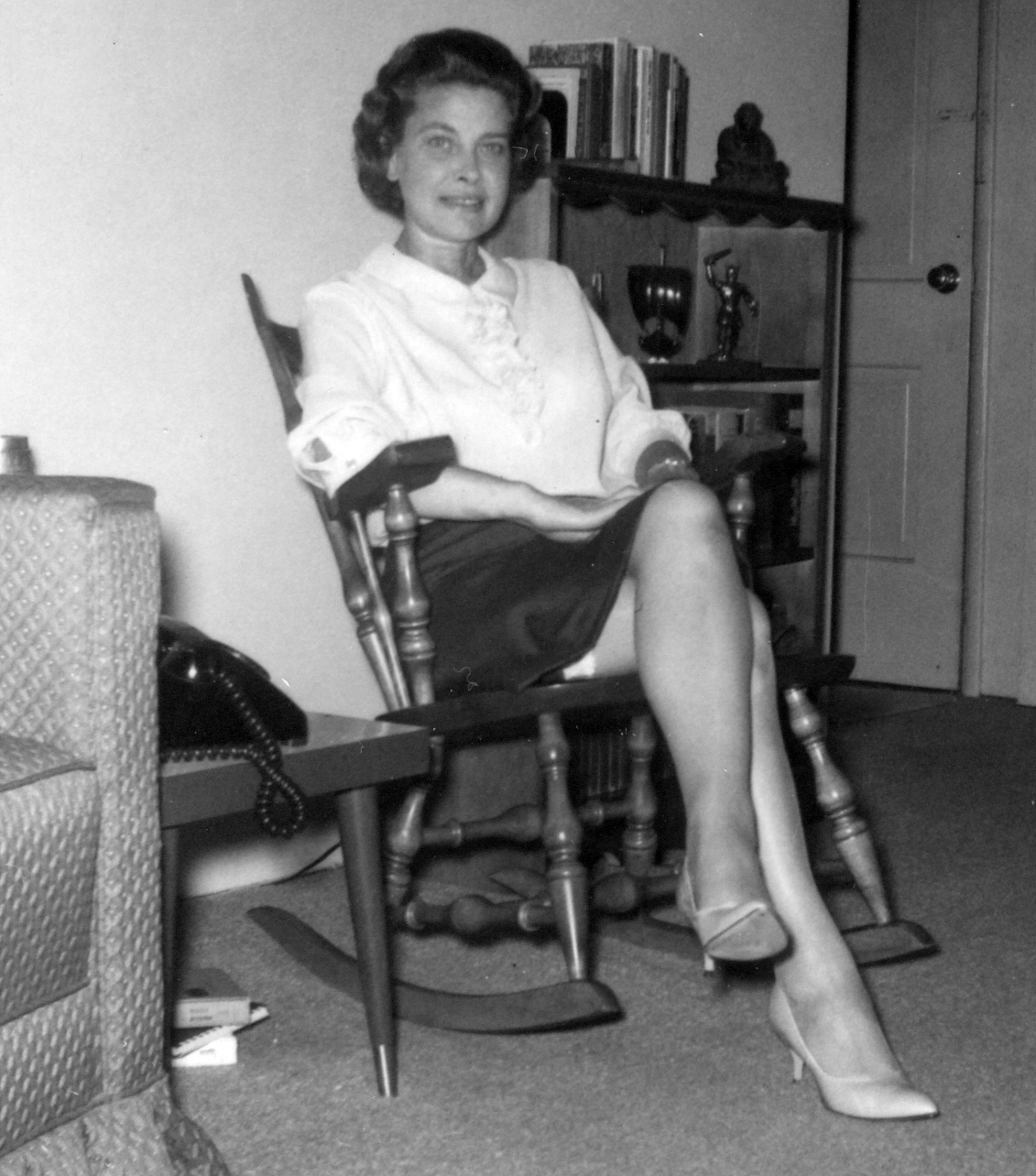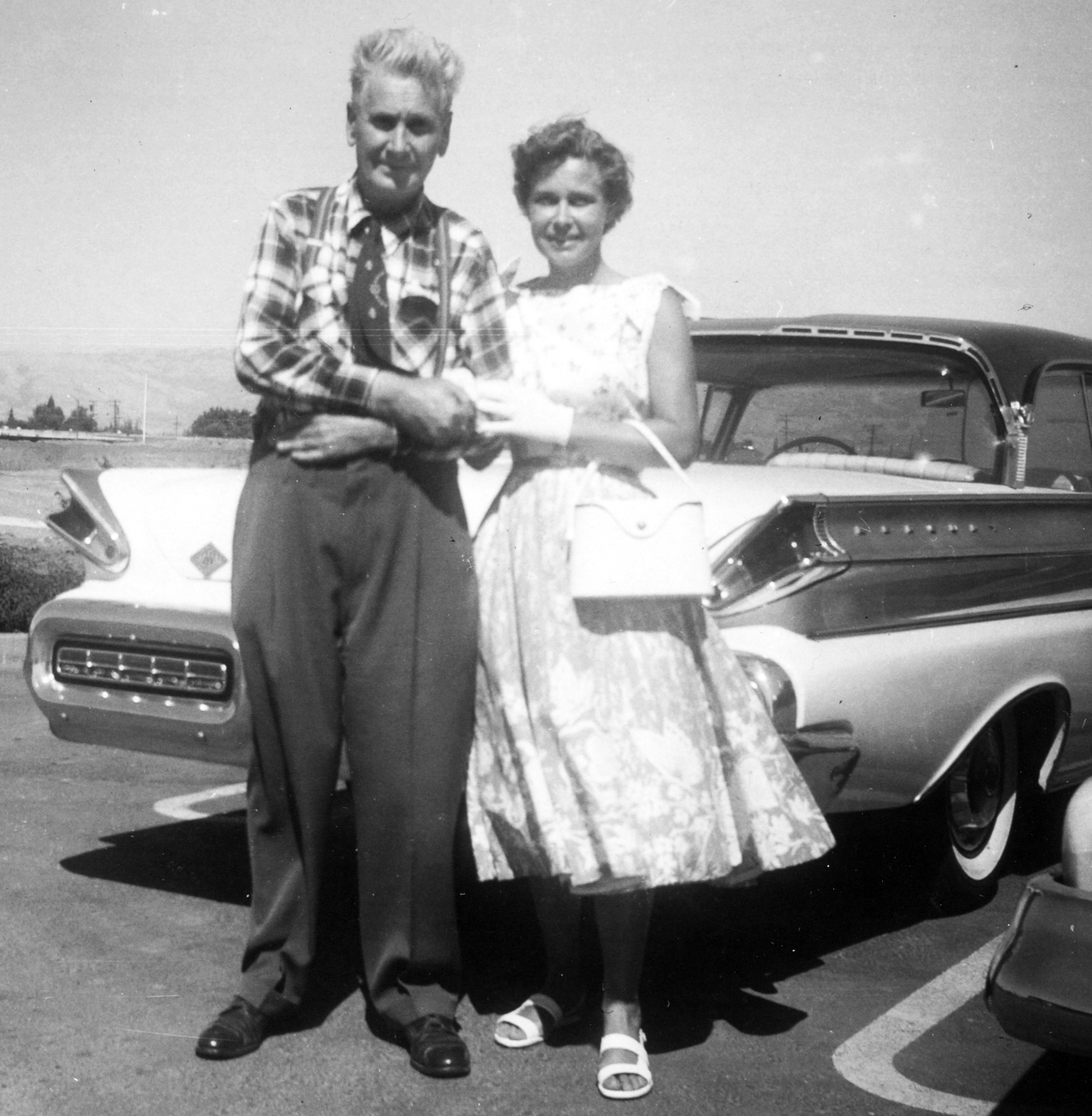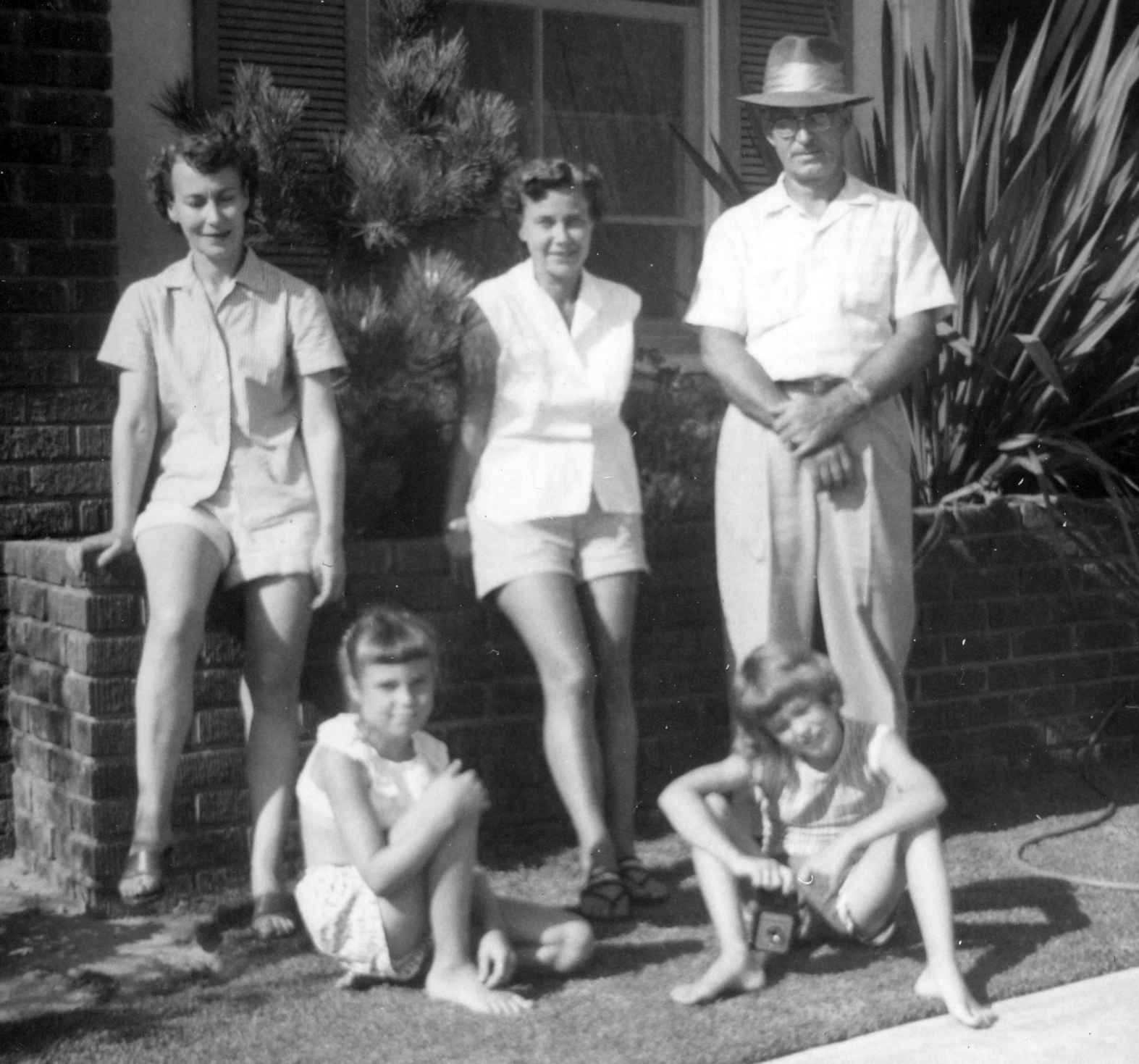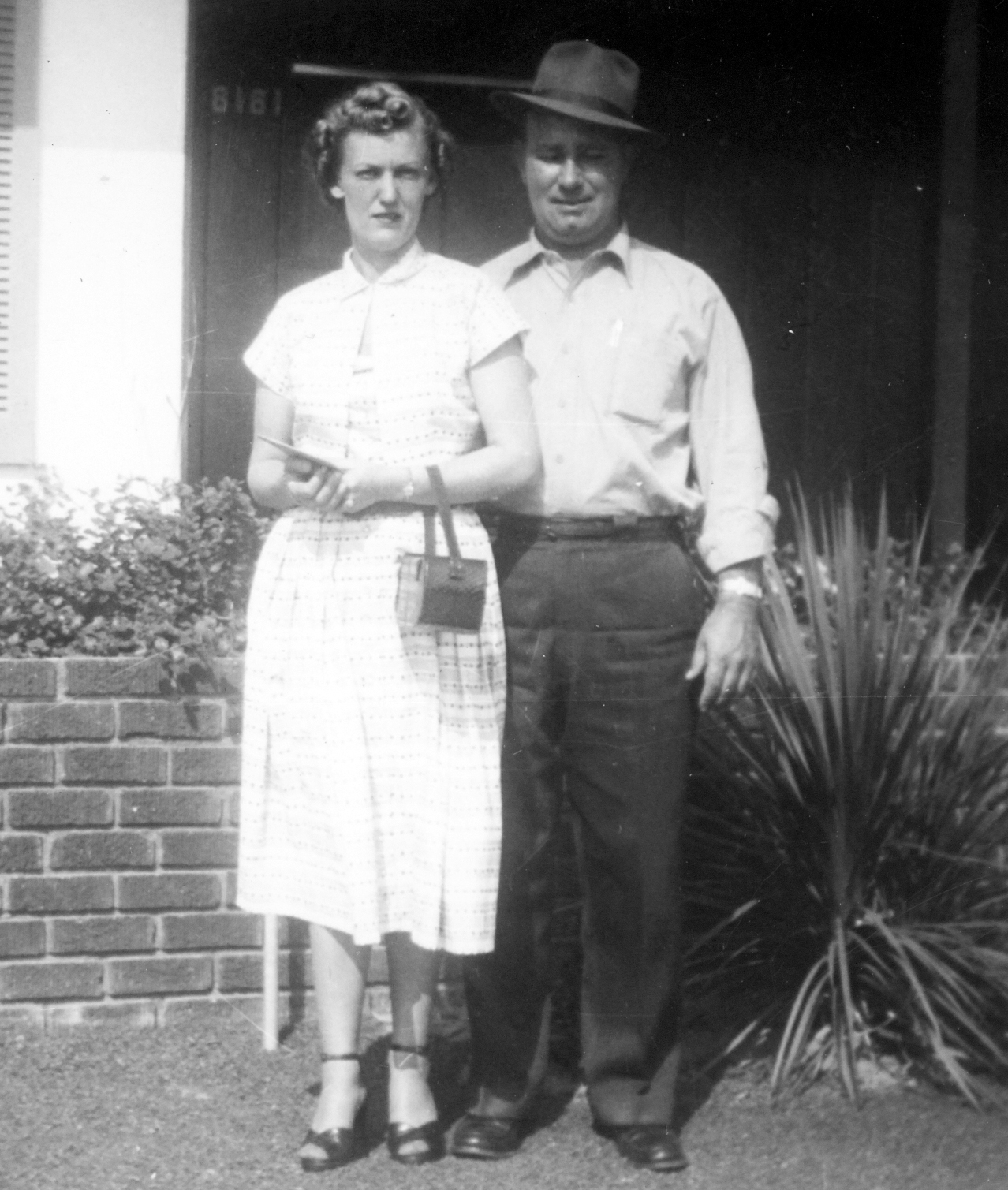|
|
←(Use Google Translate to see an approximate
translation into another relevant language)
|
[General index]
[Index to chapters]
[Index to galleries]
[Full family history]
This document is about my mother, Vivian Lund, 1922-2002; it is one chapter
from a much longer family history, which takes a
looong time to load, whereas a single chapter like this one loads very
quickly. Thanks largely to my newly found cousins, Sandy (Lund) Stout and
Betty Rae (Lund) Vanmoorlehem, and to Mark Mattison for some clarification
of patronymics. Key:
Dad = my father, Francis da Cruz Sr., Vivian's husband (Frank, "Roach").
Frank Rider = Mom's companion in California for her last 30 years.
Audie = Audrey Doney, my father's second wife.
Judy, Mommy = Judy Scott (my ex-wife).
You, you guys, Peter, Amy = my children Peter and Amy da Cruz.
—Frank da Cruz <
fdc@columbia.edu>
Most recent update: 2 November 2024 13:20:08
My mother...
[
SEE IN FAMILY TREE]
[
SEE LUND FAMILY GALLERY]
[
SEE NAVY WAVES TRAINING GALLERY]
[
SEE SCRAPBOOK GALLERY]
Acknowledgments to Cousin Sandy (Lund) Stout (my Mom's brother Zeke's
daughter) for countless photos and stories, "1940" author Dana Yost, Cherri
Schmig at the Minneota Mascot for sending numerous clippings, and
Allyson Breyfogle and Jeremy Frie at the Minneota public school.
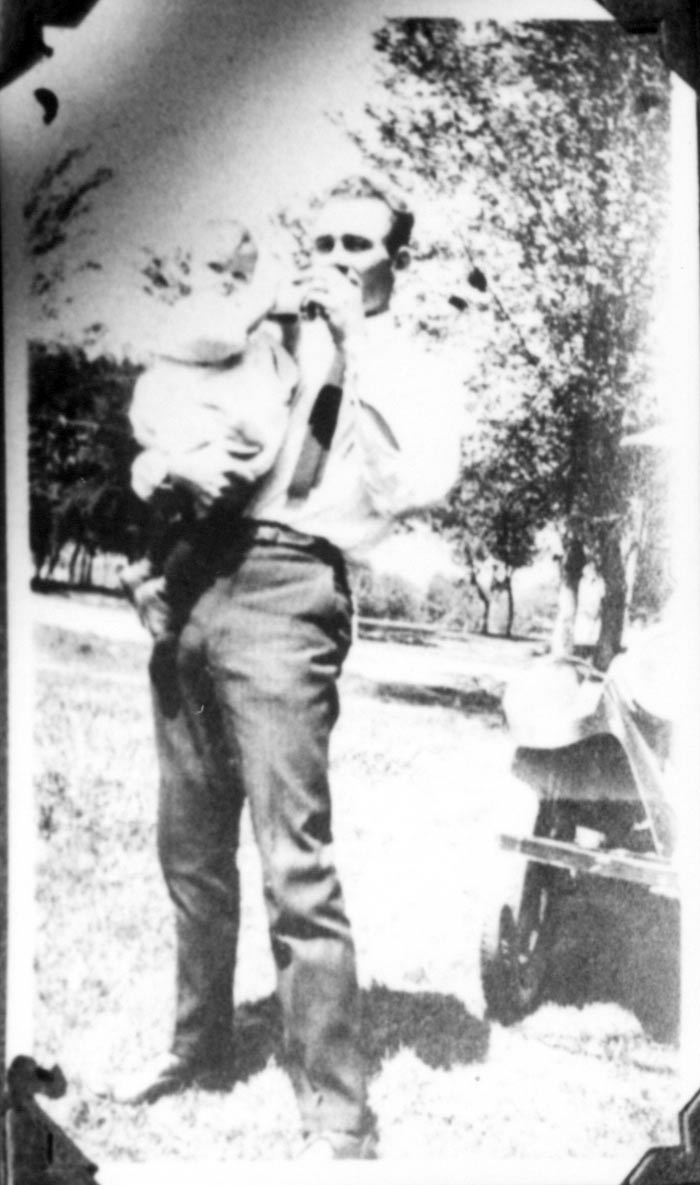
|
Carl Lund and
Baby Vivian 1922*
|

|
| Mom in 1946
|
Vivian Maxine Lund, born (at home) Minneota, Minnesota,
March 5, 1922; died July 26, 2002, in Indio, California, at age 80, stroke.
Height: 5'4".
Her father: Carl Nicolai Lund, born September 8, 1869, in Winchester,
Wisconsin. Deserted the family somewhere between 1924 and 1930. Died in
1936 of cirrhosis of the liver in Long Beach CA. Mom's parents were both
pretty old when she was born.
Mom's mother: Hannah Engeborg Johnson, born July 4th, 1883, Nordland
Township, Minnesota; died Sept 30, 1954 in Minneota, Minnesota. Her
Norwegian name Johanna Ingeborg Jansen is listed on her death certificate.
I never met her, but my mother went to see her in Minneota when I was 9 or
10. Hannah and Carl were married in Wisconsin on April 12th, 1902, lived in
Minneota until 1905, then in Streeter, North Dakota (where Carl's parents
lived), and returned to Minnesota, living in several towns until settling in
in Minneota about 1920.
Lund family residences
Within any given town, they might also have moved from house to house. For
the most part we don't have addresses, but I know from my mother that she
lived in at least two different houses in Minneota after she was born in 1922.
Here's a map of the main places, click the image to enlarge it:
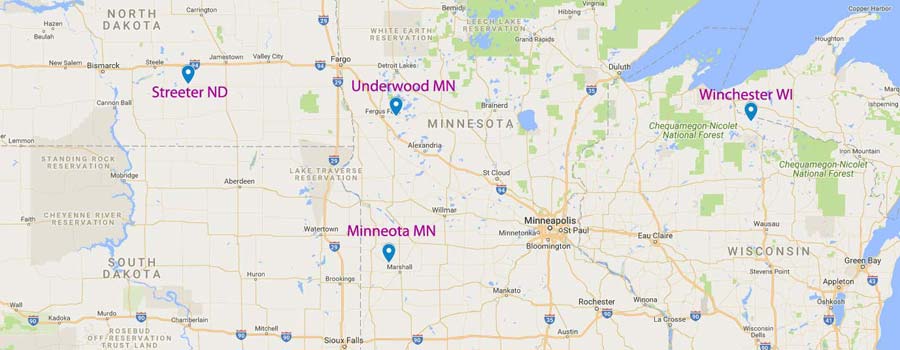
|
| Where the Lunds lived 1869-1954
(Carl came from Winchester WI; my
Mom lived only in Minneota)
|
| Years
| Town
| Authority
|
| 1869
| Winchester, Winnebago County, Wisconsin
| 1870 census; marriage of Carl's parents,
birth of Carl
|
| 1877-1899
| Minneota[1], Lyon County, Minnesota
| Birth of Hannah in 1883[2] and all her brothers and sisters.
|
| 1900-1904
| Minneota, Minnesota
| 1900 census, birth of Polly and Mabel, Polly marriage record, Hannah
obituary
|
| 1905-1912
| Streeter, North Dakota[3]
| 1910 census, births of Clarence and Marvin, Hannah obituary
|
| 1913-1920
| Underwood[4], Otter Tail County, Minnesota
| 1920 census; Births of Ella, Raymond, and Gislie; Hannah obituary
|
| 1920-1954
| Minneota, Minnesota
| Birth of Vivian, Doris, and Shirley, and death of Hannah[5].
At least two different houses during this period.
|
| [1]
| In census, church, and other records, the names Nordland, Eidsvold, and
Minneota seem to be used interchangeably; Minneota is village at the border
of Eidsvold and Nordland townships, in Lyon County. Nordland township
should not be confused with the town of Nordland, which is about 100 miles
north of Minneapolis. The use of different names for the same place (and
the same name for different places) can make it seem that the Lunds moved
around more than they actually did. The records between 1875 and 1900 show
Hannah's parents living in Nordland, Minneota, Nordland, Minneota,
Nordland... I suspect they were not moving every year, but that Nordland and
Minneota were names for the same place used by different jurisdictions.
John and Martina Johnson lived in Minneota until their deaths in 1925 and
1929, respectively.
|
| [2]
| Minnesota Births and Christenings Index 1840-1980; In Hannah's case also
confirmed in church marriage record
(hvor født = birthplace = Minneota). All of
Hannah's brothers and sisters were born in Minneota or Nordland.
|
| [3]
| This is where Carl's parents lived. Carl's father Peter died in 1908,
and was probably in decline in 1906, so I imagine the family moved to
Streeter to help out. Clarence and Marvin were born there.
|
| [4]
|
They are reported at different times as living in Underwood and in
Maine Township, which are next door to each other; they might have moved
or it might just be a variation in reporting jurisdictions. Hannah's
obituary says they lived in Underwood but doesn't mention Maine.
|
| [5]
| Personal knowledge, Mom's birth certificate, and Hannah's obituary.
|
So Carl was in Minneota for some reason, met Hannah, they went to Carl's
family's town to get married, then came straight back to Minnesota to live
in Minneota for four years. Why Minneota? Because that's where Hannah's
family (parents, brothers, and sisters) had lived since 1875. Meanwhile
Carl's family moved from Wisconsin to North Dakota and Hannah, Carl, and
children went to live on their farm for four years, then they came back to
Minnesota and lived in Otter Tail County (Underwood and/or Maine) for 6-7
years until finally settling in Minneota.
Norwegian names
Lund was a common place name in Norway; it means "grove of trees", and there
are countless places that fit that description. It was chosen as a surname
upon entry to the USA, since Norwegians did not have surnames until the law
of 1923 but our Norwegian ancestors came between 1842 and 1868. Usually
they picked some variation of the current generation's patronymic, or else
the name of their town or farm. Since, as far as I can tell, there is no
town named Lund in Hedmark, it must have been the name of Peder's farm.
Traditionally Norwegian people were called name
son-of-father's-name, or name
daughter-of-father's-name, such as Jan Jansen or Kristin Jansdatter.
Strictly speaking, the father's name is in genetive (possessive) case, like
Peders, so if Carl had been born in Norway, he would be Carl Pedersen,
i.e. "Carl, Peder's son". It might also be Petersson, but usually a single
's' is used in Norway, whereas in Sweden the suffix is usually "ssen".
Norwegian immigrants to the USA who kept
the patronymic as a last name would often change it to 'son' to be like
English. And then, if the name had an English equivalent, that would often
be substituted, so Pedersen might become Peterson. For women, "datter" or
"dotter" is used instead of "sen" or "son". But any daughter patronymics
that survived immigration
either died out or were subsumed by marriage. Meanwhile,
although most names of immigrants and their offspring were anglicized, there
were exceptions in our family like Carl's half-sister Ragnhild, which sounds
pretty Wagnerian to me.
How to spell "Lund"
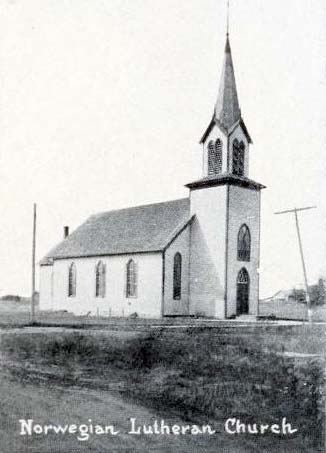
|
|
The original Hope Lutheran Church, where many Lunds are buried
|
Norwegian family records were kept in the
Ministrialbog for Minneota
Norsk-Evang. Lutherske Menighed, 1872-1910 (Ministry Register of the
Minneota Norwegian-Evangelical Lutheran Fellowship) at Hope Lutheran Church
in Minneota. This is a journal written in Norwegian by hand.
Wherever the name Lund appears, it seems to be spelled "Lünd" (with an
umlaut), and is transcribed that way in the digital version of the
register. But it is not an umlaut; it is a convention in Norwegian
handwriting (as it is in German) to put a line over the letter "u" to
differentiate it from the letter "n". If you look carefully, you can see
all the u's have a mark on top, which can look like a macron, an
umlaut, a breve, or a tilde (so the shape doesn't matter). There is no word
"Lünd" in the language, and for that matter there is no letter "ü" in
Norwegian orthography. Strictly speaking, there is no umlaut at all, but
Norwegians often write 'ö' instead of 'ø'.
Children
of Carl of and Hannah Lund
I include this now because their names are used freely from here on
and "you can't tell the players without a scorecard."

Children of Carl and Hannah Lund
| Name
| a.k.a.
| Dates
| Schooling
| Civilian occupation(s)
| Left
| Spouse
| Years
| Kids
|
| Palma Bertina
| Polly
| 1903-1995
| 10th
| PT&T telephone operator and later, executive
| ~1927
| Harold
Blanchette‡
| 1927-////
| 0
|
| Mabel Josephine
| May
| 1904-1987
| 8th
|
| 1920s
| Lloyd
Poehler†
| 1928-////
| 2
|
| Clarence
J.††
|
| 1906-1973
| 8th
| Janitor, carpenter, bartender, ship's cook
| 1920s
| Ethel
Swanson
| 1926-////
| 3
|
| Marvin
Selmer
| Zeke
| 1909-2001
| 7th
| Painter, bootlegger; later owned or managed various businesses
(ice/beer/general distributing) in Long Beach, then Anaheim.
| ???
| Mildred
Graham
| 1934-????
| 0
|
|
| Alva
Conrad
| ????-????
| 1
|
|
| Sally
Strate
| 1947-////
| 2
|
| Merrie
S.
|
| 1910-1910
|
|
|
|
|
|
|
| Gislir
Edwin
|
| 1911-1912
|
|
|
|
|
|
|
| Ella
Gladys
|
| 1913-2009
|
| Managed Colonial House apts, Long Beach
| 1935
| (none)
|
| 0
|
| Raymond
Lester‡
| Ray
| 1917-1974
| College grad
| Fireman, Long Beach
| 1930s?
| Barbara
| ????-????
| 0
|
| Gislie
Melvin†
| Pug
| 1919-1995
| 12th
| Gas station (Minneota), Calship shipyard (Liberty ships, Los Angeles);
Sudduth Tire Co. (Long Beach)
| 1940
| Ruth
Wise
| 1938-////
| 1
|
| Vivian
Maxine†
|
| 1922-2002
| 12th
| Joy movie theater ticket booth (Minneota),
Draftswoman (PT&T San Francisco), radiotelegraph operator (Navy
Washington DC),
medical/legal secretary (Long Beach)
| 1940
| Francis F.
da Cruz†
| 1944-1963
| 2
|
|
| Frank
Rider
| 1972-////
| 0
|
| Doris
Viola
|
| 1924-1990
| ≥10th
|
| (never)
| Earl
Jasperson‡
| 1949-????
| 5
|
|
| Clyde
Burgress‡
| 1960-????
| 2
|
| Shirley
Ione
|
| 1925-1994
| ≥8th
|
| (never)
| Leonard
Hasel‡
| 1954-1959
| 3
|
|
| Norman
Torgeson‡
| 1966-????
| 1
|
| †
| Served in the Navy in WWII (Lloyd Poehler died in Guadalcanal 1944)
|
| ‡
| Served in the Army in WWII (Raymond in the Army Air Corps; Harold was
in WWI, not WWII)
|
| ††
| Served in Merchant Marine in WWII
(Clarence was Chief Cook and was still at sea as late as 1955)
|
|
| (All military Lunds and spouses were enlisted, not officers)
|
Notes:
- Name, Spouse:
Names are links into the
family tree.
- Schooling:
Highest grade achieved comes from the 1940 census. Since the number is
self-reported, it's not necessarily accurate. I can't find the census for
Ella or Raymond because I don't know where they lived in 1940. Zeke
reported 7th grade but his daughter says he only finished 4th. Doris and
Shirley were still in school in 1940 but I don't know how long they stayed
after that. Hannah herself finished 8th grade. That Raymond had 4 years of
college is from his USAAC service record; I don't know if this was before
the War or after on the GI Bill.
- Occupation:
My information is very sketchy. For example after Mabel's husband died in
WWII, what was her source of income? How did Doris and Shirley live?
(Zeke's daughter Sandy said Shirley was on welfare.)
- Left:
All the kids except Doris and Shirley left Minnesota as soon as they had
a chance and most of them went to California, mainly to Long Beach and
Anaheim. Polly was the first; she stayed in San Francisco. Mabel went to
Casper, Wyoming, and stayed there her whole life. Doris and Shirley's young
daughters drowned in 1960 while playing together in Minneota, and I suspect
they didn't want to leave them behind.
- Years: Dates of each marriage. Italics means a guess based (for
example) on the birth of the first and/or last child. //// means until the
death of one of the partners. Vivian was never actually married with Frank
Rider and I'm not sure of the exact year they first got together.
Carl Lund
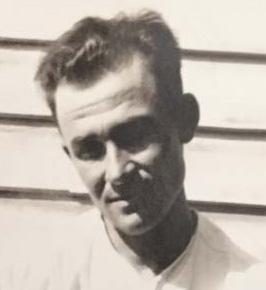
|
| Carl Lund 1913 (age 44)
|
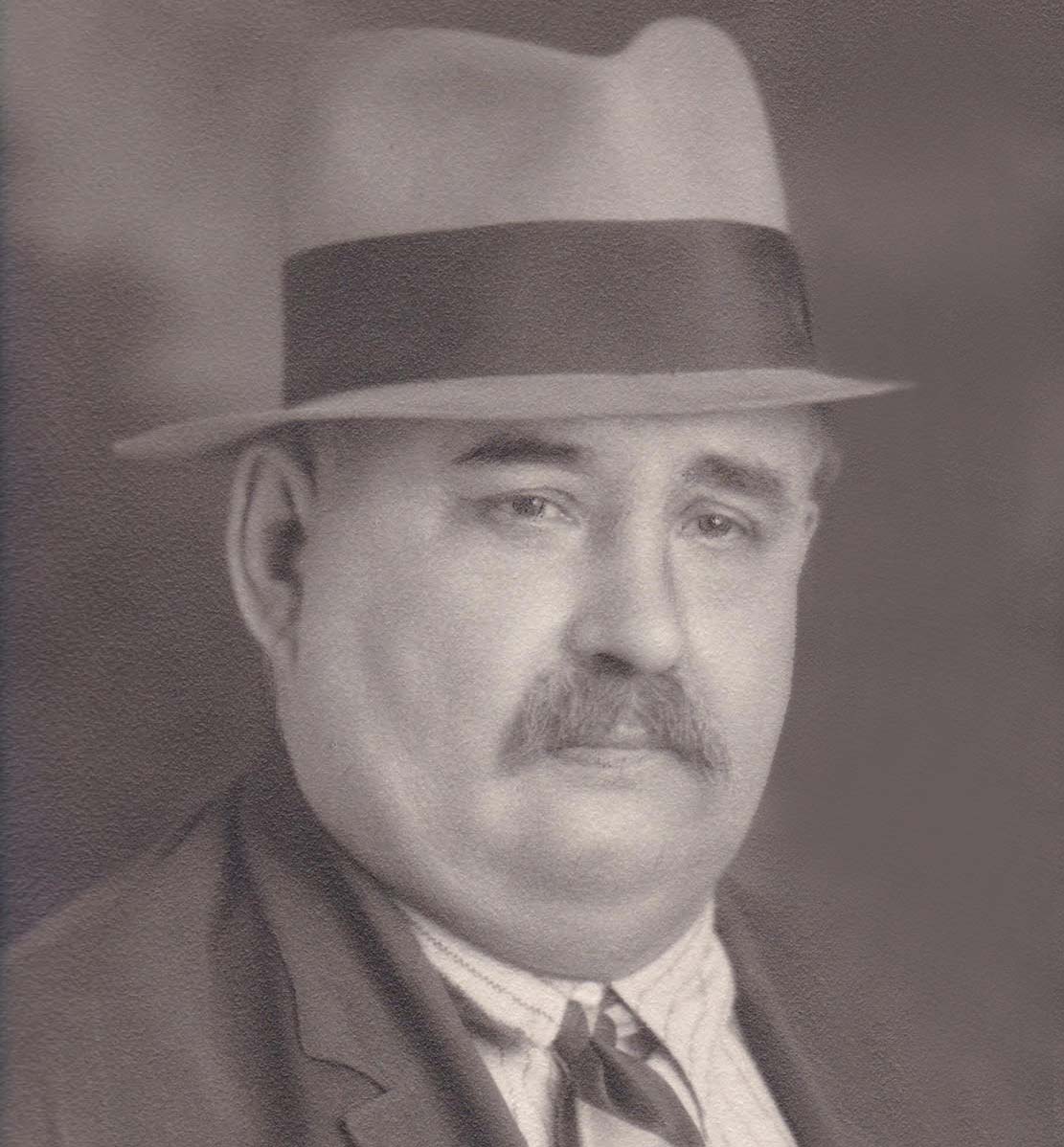
|
| Carl Lund (?) about 1930
|
My grandfather
Carl Nicolai Lund. The photo on the left turned up
recently and is clearly the same person as
the
man in Mom's scrapbook, who my Mom told
me was her father. The studio portrait on the right was passed down by Ella
and is believed by some family members be Carl. But these are two different
persons; leaving aside the total lack of resemblence, you can see that the
younger Carl has a free earlobe while the older one has an attached earlobe.
Luckily we have another,
verified,
photo of
Carl from 1892 in which the face, the shape of the head, and the earlobe
match the 1913 photo.
Anyway, whatever he looked like, Carl Lund wound up as a drifter,
alcoholic, and eventually a derelict. On the 1900 census he's listed as a
blacksmith; in 1910 as a farmer (on his parents' farm in Streeter, North
Dakota); in 1920 a farmer (in Otter Tail County, Minnesota); on my mother's
birth certificate his occupation is listed as "laborer". At some point
between 1924 and 1930 Carl walked away from the family. My cousin Sandy,
Mom's brother's Zeke's daughter, says "Carl, from what my dad said was
almost never home, he was a blacksmith and traveled with the builders
... spent most of the time in the tavern and when he left Hannah with all
those kids he told the owner of the General Store that when they had eaten
all of what the house was worth he could have the house."
In 1930 Carl was living with daughter Mabel and her husband Lloyd and their
baby girl in Casper, Wyoming, occupation "None", marital status "Divorced".
He had left Hannah and the three youngest children — Vivian, Doris,
and Shirley, who were still in school — and was mooching off his
second child and her husband. To Hannah, Carl was as good as dead; she
listed her marital status as "Widowed" on the 1930 census. Just as the
Great Depression kicked in, she had to find a way to house and feed the
three girls. I don't know the whole story but somehow she held it all
together at least until 1940, when my Mom left home.
Mabel and Lloyd must have kicked Carl out because he made his way somehow to
Long Beach, California, where several other of his children lived, including
Sandy's father Zeke. The next thing I know is that he was found dead on the
beach, January 27, 1936, liver failure. Sandy says, "Ella at age 95 still
cried about her dad... she just remembers he bought her a red dress. I don't
think she saw him [when he came to Long Beach]. Ella loved him for the good
memory of a new red dress. They were poor and everyone had to work to
support 10 kids. Seems if anyone knew he was in Long Beach we would have
heard Dad say something about it and Carl was never mentioned." Certainly
Mom never knew what happened to him because Frank Rider hired a detective to
investigate, only to find out that he died on the very same beach that their
apartment looked out on.
Carl's Norwegian family
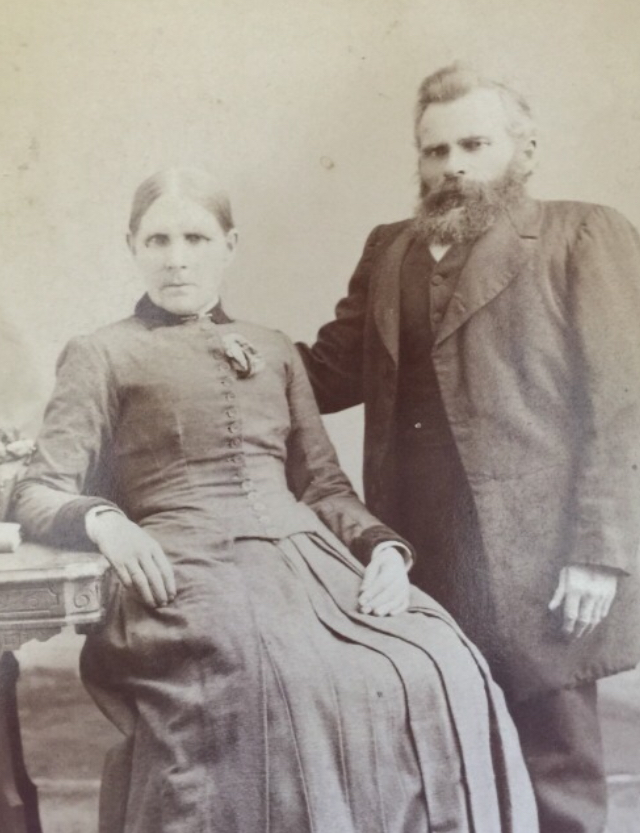
|
| Betsey and Peter Lund about 1885
|

|
| Our Norway towns
|
Carl's father: Peder Nicolaisen, born 1841 in Løiten (now
Løten), Hedmark, who became
Peter Nicolai Lund when he arrived in the
United States in 1868.
Carl's mother: Bergit Høljesdatter,
born Gransherad, Telemark, in 1834, who arrived in the US in 1842 and
became
Betsey Lund when (after a first marriage) she married Peter
Lund.
Peter and Betsey met in Wisconsin, were married in 1869, lived in
Winchester, Winnebago County, where they had four children: Carl Nicolai
(1869), Martha Oline (1871), Eliza Elise Sophia (1874), and Melvin Bernard
(1878). They also had Betsey's four children from her previous marriage to
Knud Hanson, a Norwegian immigrant and Union soldier who had died in 1865 in
Andersonville prison camp in Georgia: Ragnhild (1857), Caroline (1858),
Anna Maria (1861), and Henry (1863).
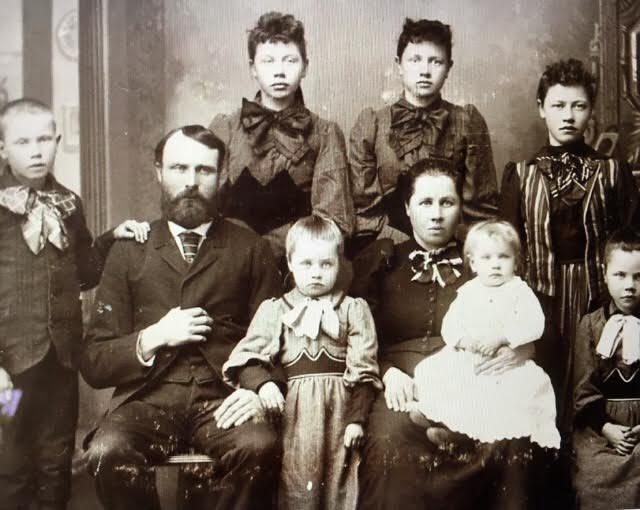
|
| Betsey and Peter Lund family 1880
|
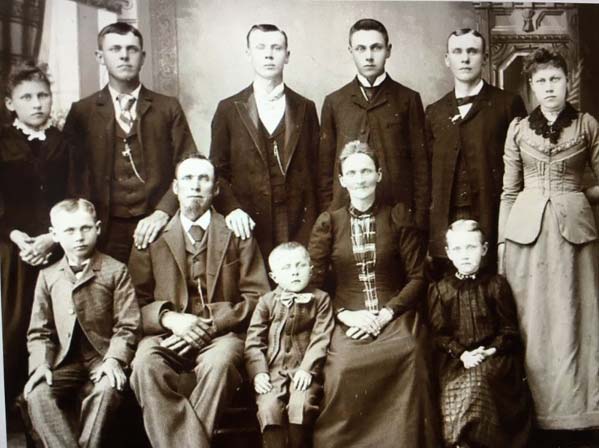
|
| Betsey and Peter Lund family 1892
|
These extraordinary photos showed up on EBay, cousin Sandy found them; the
most amazing part is that they came with captions saying who everybody is;
Click the photos to see the captions. Carl is on the left in the 1880 photo
and third from the left, top row, in the 1892 photo.
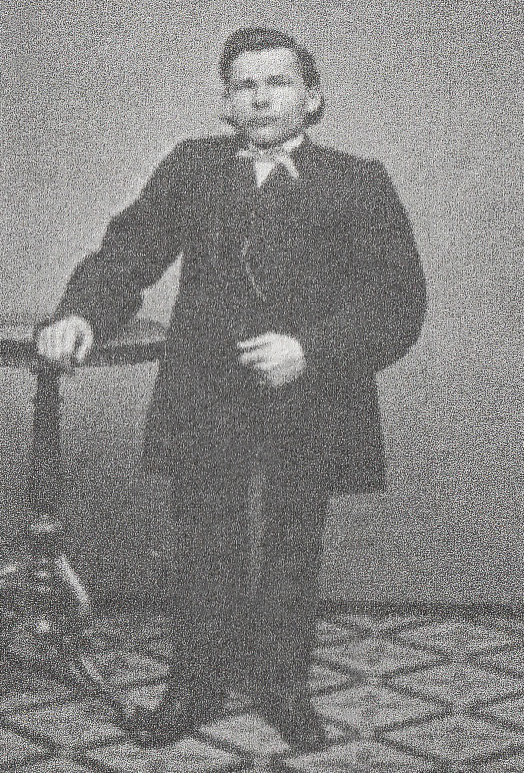
|
| Peder Lund[8]
|
I have to say that the Peter (Peder) Lund in these group photos appears to
have a normal body, whereas there is an authenticated photo (right) of Peder
Lund in the book
Wisconsin My Home[
8], and he
is very small. The book says Bergit "..was a tall woman and ... he was a
short hunchback ..."; elsewhere she says "this small Norwegian man, who had
been so crippled with some kind of rheumatism when he was eleven years old
that he had a big bump on his back and chest. Both his head and arms were
the same size as any other grown-up man, but his legs were so short that I
don't believe he could have been over four feet tall. Because of this
deformity his parents in Norway had educated him very well ... [he soon
married the [Civil War] Widow Hansen (Bergit)] [and] there were four
children [including Carl] born to this union, and a better father, husband,
and stepfather has never lived, I am sure."
Peder was a prominent figure in the in the Winchester Norwegian community:
church klokker (sextant) and bell-ringer, hymn leader, town assessor
(of Winchester), parochial school teacher (where children learned not only
the Lutheran religion but also to speak, read, and write Norwegian),
night-school teacher, farmer, story-teller, and comforter of the sick and
dying.
I'm inclined to believe the man in the group photos is indeed Peder Lund,
not only because he is identified as such in the photo legend, but also
because Sandy ran the photos at the top of this section through a
face-matching app with an 81.37% look-alike score.
Hannah Lund
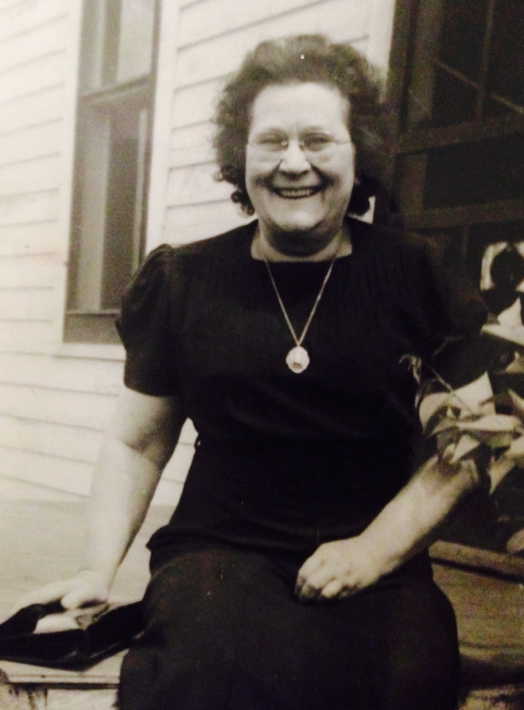
|
| Hannah Lund 1940s
|

|
| Hannah Lund 1930s
|
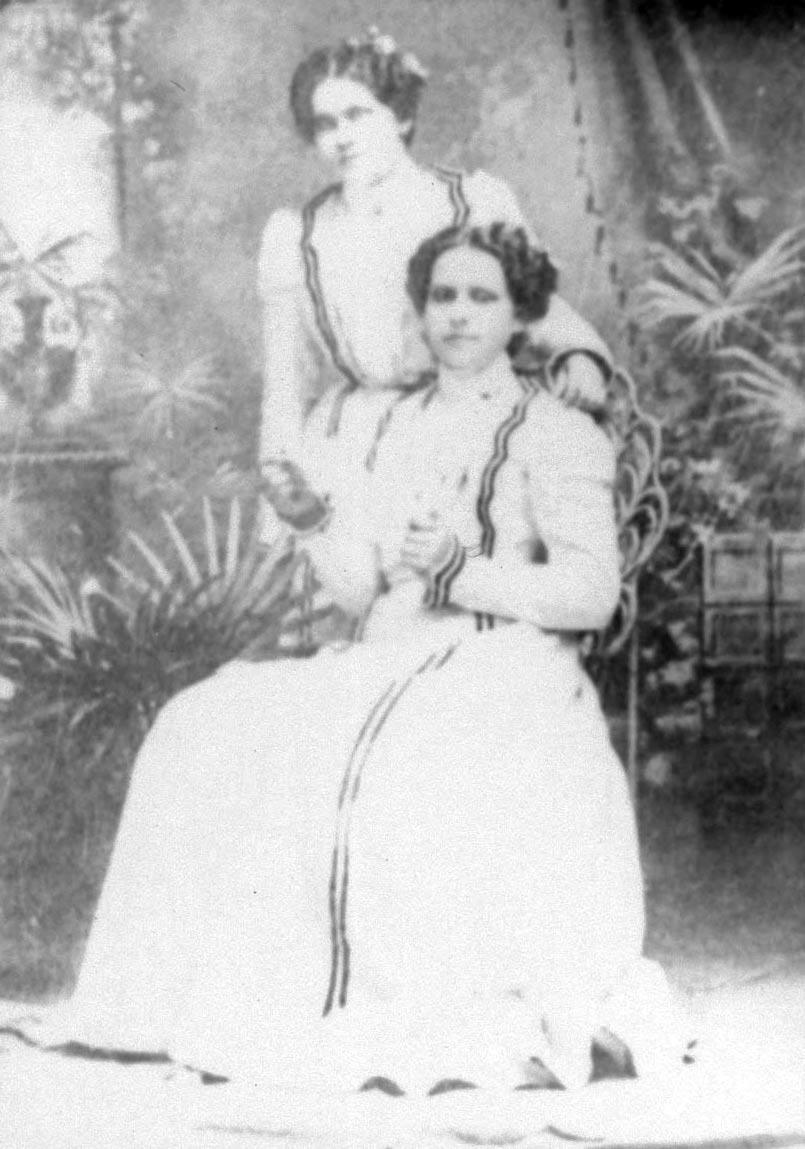
|
Hannah Lund
(standing) 1902
|
My grandmother
Hannah Engeborg Lund, born Ingeborg Johanna Johnson
(anglicization of Janssen, her father's patronymic), raised ten children in
conditions of unremitting chaos and hardship, as far as I can tell. Carl was
not a good husband; he was never home, he drank up much of whatever money he
managed to earn, and he deserted the family when my Mom was somewhere
between four and eight years old and Doris and Shirley were very little.
I know little about the early years, but Sandy says her father Zeke (who was
born in 1909) remembers living in a sod house; that's like a hole in the
ground, typical of many newly-arrived Scandinavian immigrants who settled in
northern plains states, where there are few trees; this would have been in
either North Dakota or Minnesota, nobody is left alive who can say for sure.
He remembered "having only flour and water to eat and if they were lucky
they could sprinkle cinnamon on it for flavor." My own Mom had a similar
story about eating snow.
Despite all this, and despite the fact that all the children except Doris
and Shirley had gotten the heck out of Minnesota at the earliest possible
moment, most of them without finishing school, Hannah was much loved by her
children. Mom, like all her brothers and sisters, couldn't wait to get out
but when she was still on the cross-country train she was already
homesick...
I am more than 3000 feet above sea level in the Rockie Mts. It's 11:30 now,
Sunday morning. It's all very wonderful. We stopped in Denver this morning
and met some of the Jack B's wife's relations. Harold [Polly's husband] is
shaving. There hasn't been time to write so I bought this [foldout postcard
mailer] for 25¢. Harold's been feeding me so much I'm stuffed. There is
snow on the mts. Now we're going thru an 11 mile tunnel. Will be in
S.F. 9:35 Mon. nite. Tell all the kids hello I miss Viola [Doris] all
ready. Phyllis Knight bought stockings in Marshall [Minnesota]. I had
dinner over to Blanchette [Polly's married name]. I can't write its so
bumpy. I'm afraid I'm going to be lonesome.
Postmarked June 11, 1940, in East Portal, Colorado, addressed simply to
"Hanna Lund, Minneota, Minn" (notice the touches of "Fargo" dialect towards
the end). I guess Polly and Harold must have come out from San Francisco to
meet her halfway somehow.
So now it was just Hannah, Doris, and Shirley left in Minneota, less mouths
to feed but also less people to earn money. The offspring who went west,
I'm not sure how they all managed it, but Zeke worked his way across; at one
point as a logger and others as a farm hand. Later on, in the 1940s and 50s
the ones who had money like Polly and Zeke were able to send money to
Hannah in Minneota and also to brothers and sisters down on their luck.
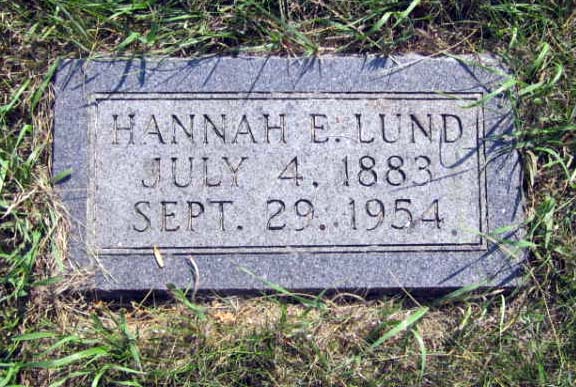
|
| Hanna's marker
|
We (da Cruz's) were still pretty poor while Hannah was alive, but
somehow my Mom got plane tickets to go see her in March 1954 when she was
dying, the first visit since she left home. Maybe Polly sent her the money.
I have postcards from Mom when she was there; she sounds happy being where
she grew up and with her family and friends. Ella went to Minneota after
Mom and stayed with Hannah until she died. Somehow Hannah's funeral and
burial were paid for and an obituary was printed in the
Minneota
Mascot:
Mrs. Lund dies; Rites Held Monday
Mrs. Hannah Lund, a resident of this community for years, died at her home
Thursday of last week after a lingering illness of several months. ¶
She was buried here Monday afternoon following services at Hope Lutheran
Church. ¶ Rev. Ott Dale officiated at the funeral rites, with the
following acting as pallbearers: ¶ Arby Furgeson, Orrin Hanson, Henry
Johnson, Irving Johnson, and Richard Lund. ¶ Hannah Engeborg Lund, a
daughter of Mr. and Mrs. John B. Johnson, was born on July 4, 1883, in
Nordland township. ¶ At the time of her death she was 71 years old.
¶ On April 12, 1902 she was united in marriage to Carl N. Lund and they
first made their home in this community. ¶ In 1905 they moved to
Streeter, N.D., and later to Underwood, Minnesota. ¶ They returned to
Minneota in 1920 and since that time this has been Mrs. Lund's home. ¶
To this union 11 children were born of which 10 are living. ¶ She was
preceded in death by her husband, one son, parents, five brothers and
sisters. ¶ Mrs. Lund is survived by her 10 children: Palma
(Mrs. Harold Blanchette) of San Francisco, Calif.; Mabel (Mrs. Mabel
Poehler) of Sheridan, Wyoming; Clarence, Marvin, Raymond, and Gislie of Long
Beach, Calif.; Ella of Glendale, Calif.; Vivian (Mrs. Francis da Cruz
of Falls Church, Virginia; Doris (Mrs. Earl Jasperson) of Storden, Minn.;
Shirley (Mrs. Leonard Hasel of Minneota. ¶ She is also survived by two
brothers, Andrew Johnson of Ivanhoe, Gislie Johnson of Minneota; and two
sisters, Mrs. Theo Furgeson of Minneota, Mrs. Carl Wigness of Fessenden,
N.D.; 16 grandchildren and seven great grandchildren.
Hannah's Norwegian Family
Hannah's father: John Bjorn Johnson, birth name Bjørn Jansen (or
Janssen) in 1852 in
Sauherad,
Telemark, Norway
(
see map); arrived USA
1861, died 1925.
Hannah's mother: Martina Halvorson, born Simonine Mathene
Andersdatter in
Bamle,
Telemark, who took the surname
Halvorson (her father's patronymic) when she arrived in the US in 1861, and
became Martina Johnson when she married John Bjorn Johnson in 1875. They
lived in Iowa and Wisconsin before settling in Minnesota, and had 12
children.
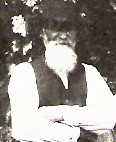
|
| John Bjorn Johnson
|

|
| Martina Halvorson
|
Children of John Bjorn Johnson and Martina Halvorson
| Name
| Dates
| Born
| Died
|
| Bernard Johnson*
| 1875-1953
| Minnesota
| Minnesota
|
| Anne/Anna Johnson
| 1877-1961
| Minneota MN
| Lincoln MN
|
| John Johnson
| 1878-1925
| Nordland MN
| Nordland MN
|
| Stener Johnson
| 1880-1907
| Nordland MN
| Hendricks MN
|
| Johanna Ingeborg Johnson**
| 1883-1954
| Minneota MN
| Minneota MN
|
| Andrew Johnson
| 1884-1960
| Nordland MN
| Hendricks MN
|
| Joseph Martinias Johnson
| 1887-1946
| Nordland MN
| Lyon County MN
|
| Julia Clareth Johnson
| 1890-1946
| Nordland MN
| Stettler, Alberta
|
| (baby girl)
| 1892-1892
| Nordland MN
| Nordland MN
|
| Ella Andrea Johnson
| 1893-1945
| Nordland MN
| Todd MN
|
| Tilda Nellie Johnson
| 1896-1982
| Nordland MN
| San Leandro CA
|
| Selmer Adolph Johnson
| 1898-1945
| Nordland MN
| Fort Dodge IA
|
| Gislie Louis Johnson
| 1900-1984
| Nordland MN
| Sioux Falls SD
|
|
Bear in mind, Nordland and Minneota are most likely the same place.
|
* Bernard and his wife Annie Kass were close with Hannah her whole life.
** Johanna is Hannah.
Summary of Mom's Norwegian immigrant grandparents
| Norwegian name
| American name
| Born-died
| Arrived
| From
| Relation
|
| Peder Nicolaisen
| Peter Nicolai Lund
| 1841-1908
| 1868
| Løiten, Hedmark
| Carl's father
|
| Bergit Høljesdatter
| Betsey Lund
| 1834-1926
| 1842
| Granserad, Telemark
| Carl's mother
|
| Bjørn Jansen
| John Bjorn Johnson
| 1852-1925
| 1861
| Sauherad, Telemark
| Hannah's father
|
| Simonine Mathene Andersdatter
| Martina Halvorson Johnson
| 1859-1921
| 1861
| Bamle, Telemark
| Hannah's mother
|
So all of Mom's grandparents were immigrants from southeastern Norway, three
from Telemark and one from Hedmark, and both couples met in the USA.
Meanwhile on Bergit's side we have 4 generations of documented ancestors
before her going back to Hans Olsen (1696-1740) and Gunlov Såmåldatter (born
1696) and on Simonine's side (Hanna's mother), five generations going back
to Jon Nilson (1710-1763) and Live Knudsdatter (1713-1750).
Minneota
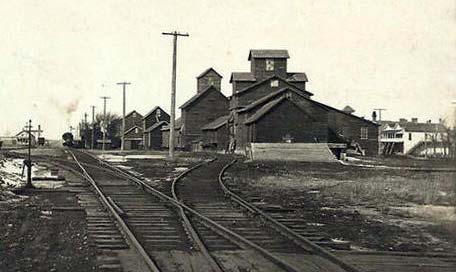
|
| Minneota station and grain elevators 1908
|
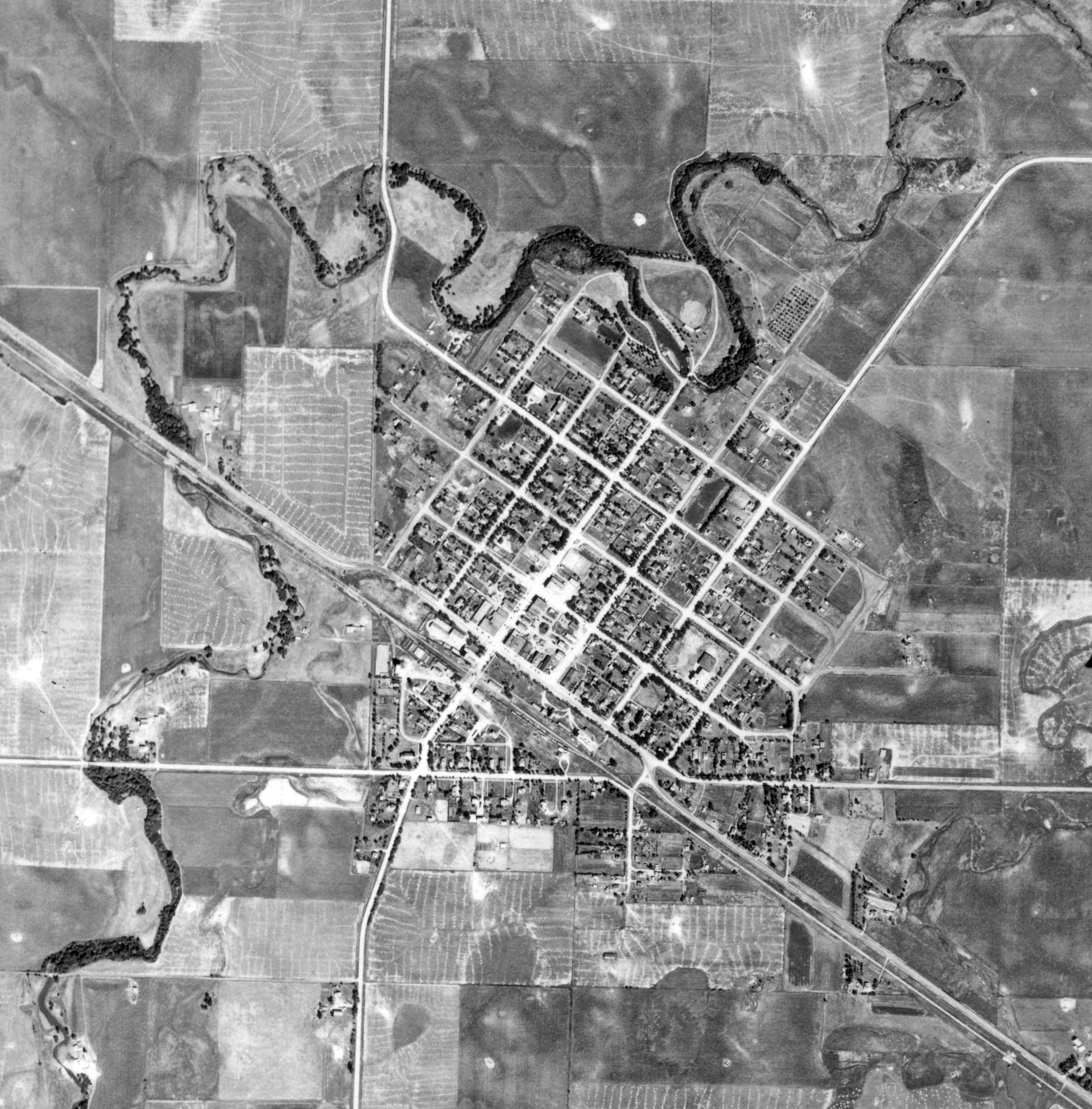
|
| Minneota aerial view 1938
|
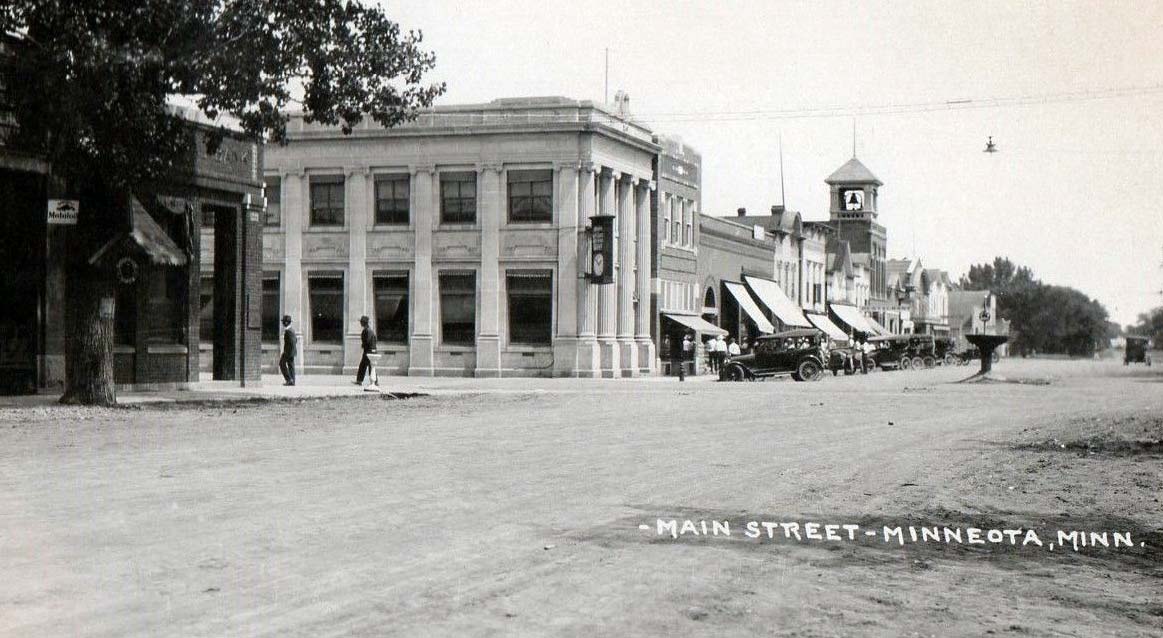
|
| Minneota Main Street (before it was paved)
|
Minneota is a tiny town on the Yellow Medicine River in the plains
of southwestern Minnesota. It grew up around a railroad station built in
1877 for the coal-burning trains to take on water from the river for their
boilers, and was incorporated in 1881 in the middle of a vast flat landscape
of farmland and featured huge grain elevators and warehouses where the
farmers brought their crops and livestock be taken to market on the train.
In 1938 the town was a grid of 6 by 6 streets (give or take) and only the
main street (1st Street) was paved. Farmers brought goods to town in
horse-drawn wagons, and there were still hitching posts in front of the
stores. The town ends abruptly at the farmers's fields, there were and are
no suburbs. To this day, houses in Minneota have no fences, and it's not
much bigger than it was then.
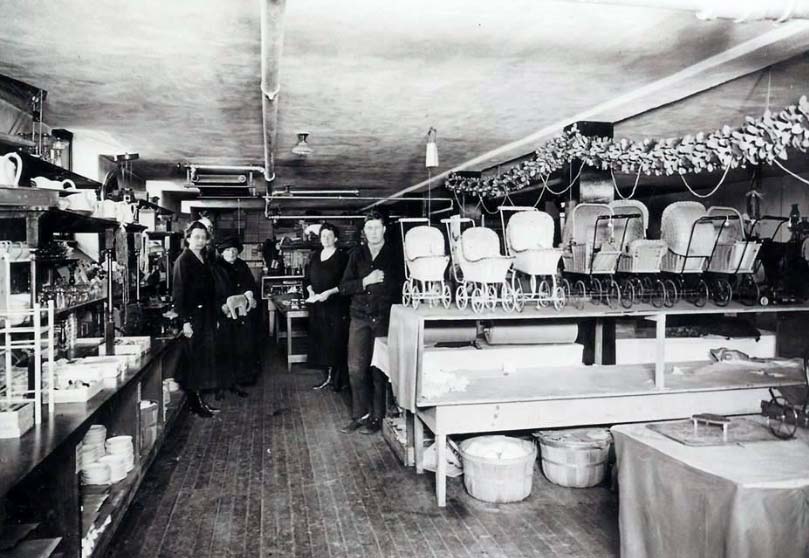
|
| Inside The Big Store
|
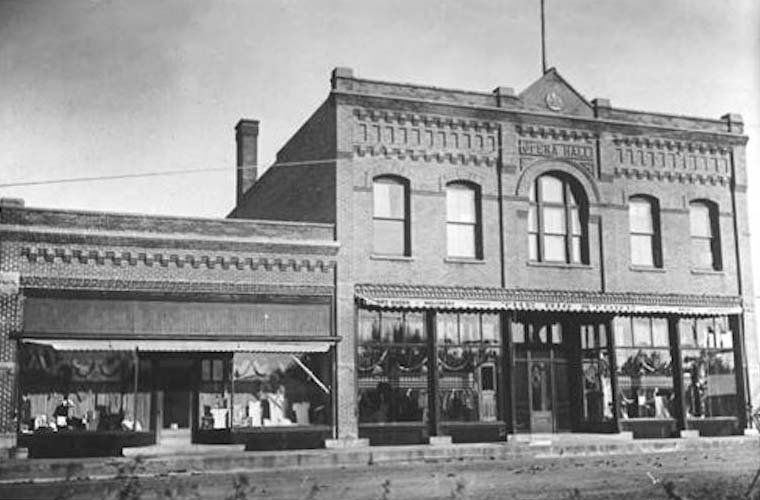
|
| Minneota Big Store
|
Although the population was only 1065 in 1940, Minneota had six grocery
stores, three hardware stores, the Big Store (a 1900-era department store),
five churches, five agricultural businesses, five cafés, four auto dealers,
two gas stations, a drug store, a jeweler, a bakery, a pool hall (Dero's), a
Public school and a Catholic school, and the Joy movie theater (where my Mom
was cashier), plus a doctor, a dentist, a vet, and an undertaker. This is
because Minneota served the nearby towns (which had very little in the way
of retail) and the farms scattered over a vast expanse; it was the only
place to buy stuff for hundreds (thousands?) of square miles to the west,
north, and east. The larger town of Mashall was 12 miles to the Southeast,
but if you were coming from the north, why go an extra 24 miles to Marshall
and back if you could buy what you needed in Minneota?
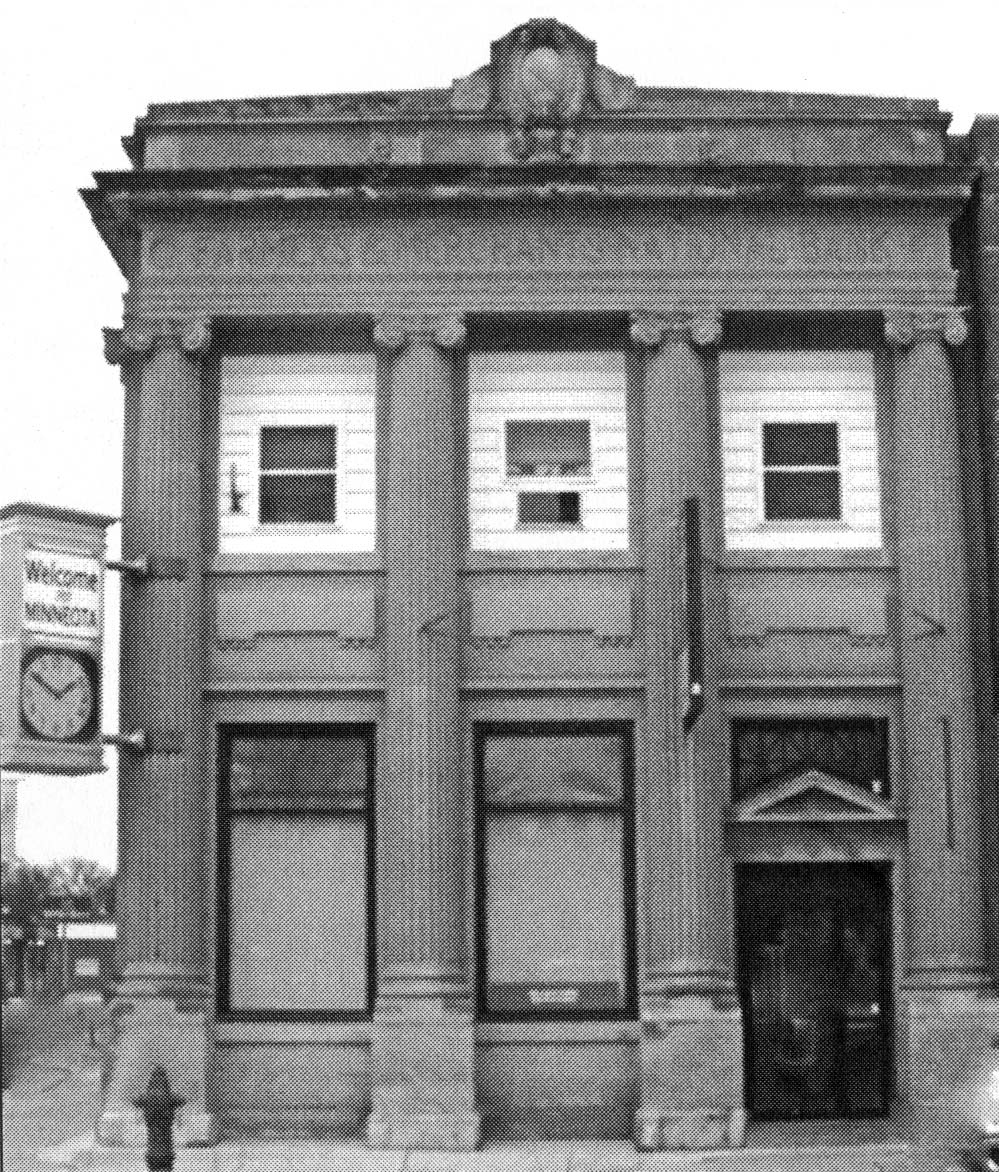
|
| Farmers & Merchants Bank
|
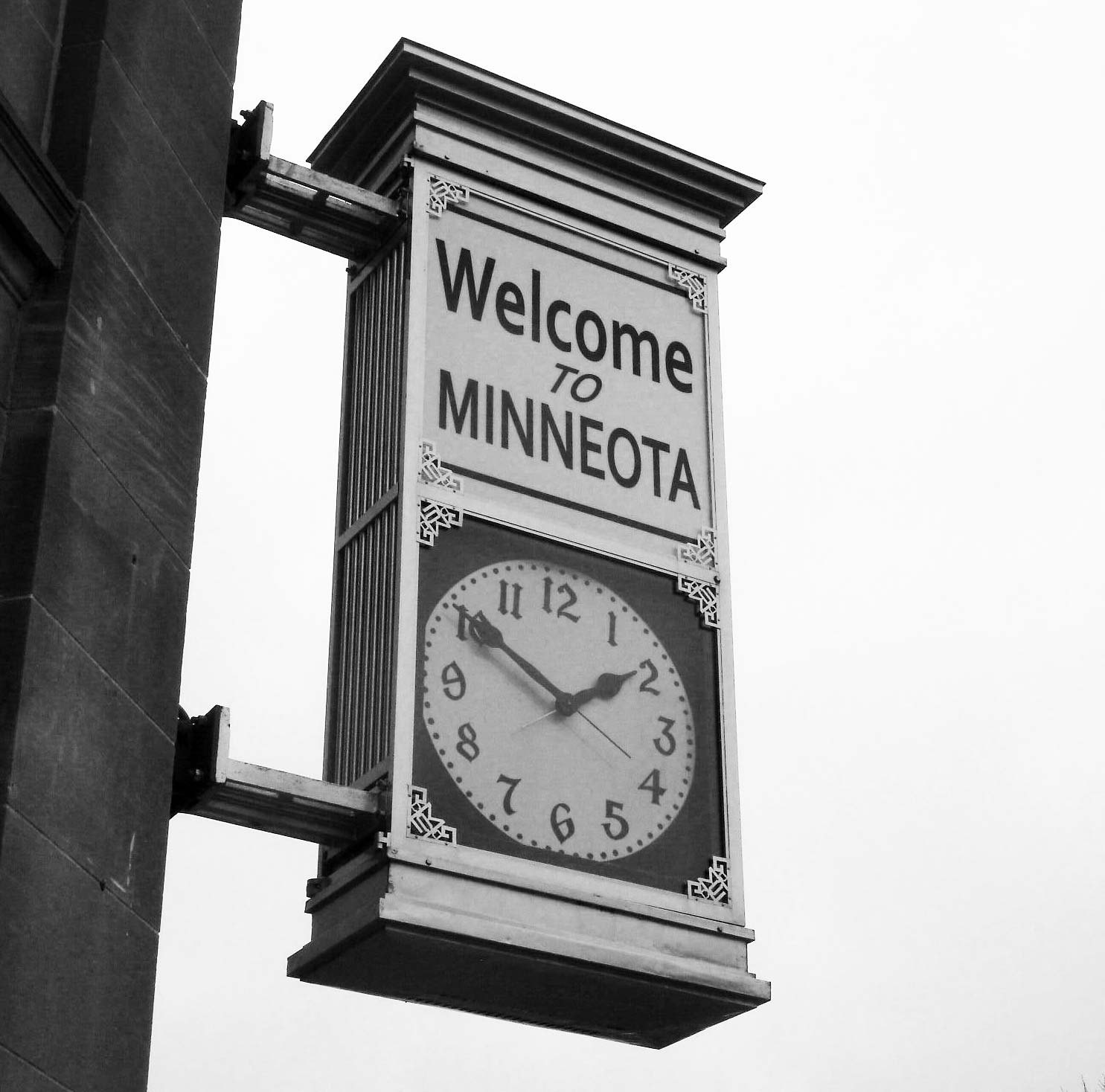
|
| Bank clock
|
Minneota's population was Norwegian, Icelandic, and Belgian: some
immigrants, others children and grandchildren of immigrants. The Belgians
were Catholic Walloons (Dutch speakers); the Norwegians and Icelanders were
Lutherans, with separate churches. The Norwegians and
Icelanders went to the public school, the Belgians to the Catholic school.
In 1940, the average annual family income was under $900, far below the
national average. 24 Minneotans worked for the WPA that year. It was
normal for families to have lots of kids; 41% of the population were
children. Telephones existed but not everybody had them; phone numbers were
two digits. The town had electricity but it was only just beginning to
reach the farms through an electrical cooperative funded by FDR's Rural
Electrification Administration. Even today, 20% of Minnesotans get their
electricity from cooperatives.
Dana Yost points out that "Minnesota was well ahead of the rest of the
nation as far as number of co-operatives and still is ... Minnesota was,
indeed, a state with socialist tendencies from the 1890s up to World War II,
largely as off-shoots of farm activist organizations, labor unions,
etc. Interestingly, the left/socialist organizations started in more rural
areas than urban ... From 1915-1920, an anti-banking, anti-big business
organization known as the NonPartisan League had more than 50,000 members in
Minnesota. It started as a farm-activist group but supported flat-out
socialist policies in many areas and supported the state equivalent of
nationalizing grain elevators ... (it gave) rise to the Farmer-Labor
political party, which remains intact today in Minnesota as part of the
Democrat-Farmer-Labor Party." Minneota itself had a gas-and-oil cooperative
and a dairy co-op.
The Depression was as hard on Minneota as it was throughout the midwest:
drought, farm failures, food shortages, lost jobs, and even an uprising of
foreclosed farmers, but Minneota survived. My Mom was only seven years old
when the Depression started, and hard times were all she knew during her
formative years.
References -
Source material and recommended reading and viewing...
- Yost, Dana, 1940,
Journal of a Midwestern Town, Story of an Era,
Ellis Press (2017), 665pp. A whole book about Minneota in the pivotal year
of 1940.
- Federal Writers Project, The WPA
Guide to Minnesota (1938);
reissued by the Minnesota Historical Society.
- Kenney, Dave, Minnesota
Goes to War: The Home Front during World War II,
Minnesota Historical Society Press (2004).
- Haugen, Einar, Language
Conflict and Language Planning,
Harvard University Press (1966). Language and spelling standardization and
reform in Norway.
- Haugen, Einar, The
Norwegian Language in America, Indiana
University Press (1969). The growing problems in communication between
Norwegian immigrants in America and their relatives back home.
- Rølvaag, Ole Edvart, Giants in
the Earth, Harper (1924-25).
A novel about Norwegian immigrants to the upper midwest in the late 1800s.
Rølvaag lived near Minneota.
- Moberg, Vilhelm, The Emigrants series of novels (The
Emigrants, Unto a Good
Land,
The
Settlers,
The
Last Letter Home, 1951-61). About Swedes rather than Norwegians
but the same experience. Also available as two excellent (if depressing)
films: The Emigrants (1971), and The New Land (1972).
- Oleson, Thurine,
Wisconsin My Home, University of Wisconsin Presss (1950), 2012 edition.
This is the autobiography of Thurine Oleson (1866-1990), as told to her
daughter Erna Oleson Xan. Peder and Birgit Lund lived next door and
appear throughout the book.
The Lunds in Minneota
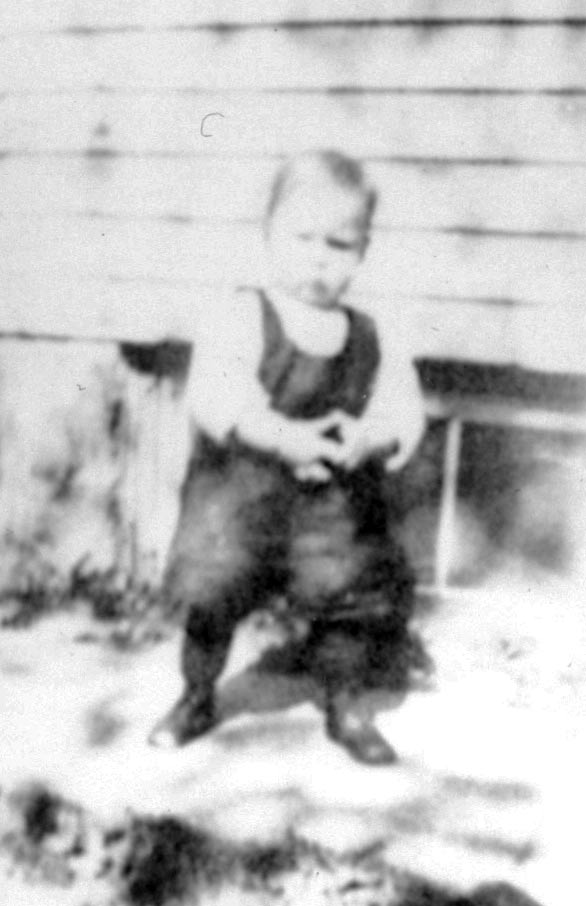
|
| Baby Mom
|
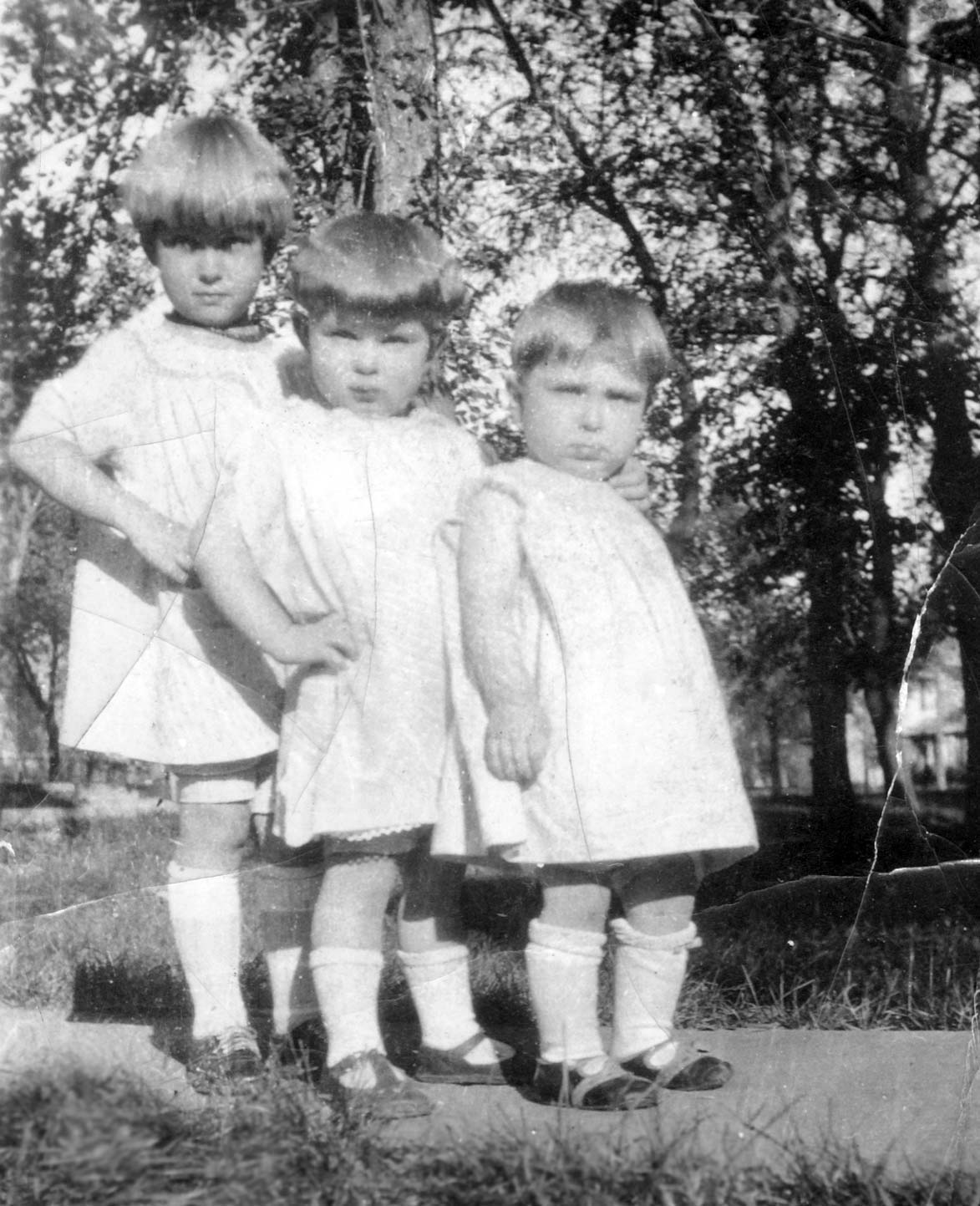
|
| Mom, Doris, Shirley
|
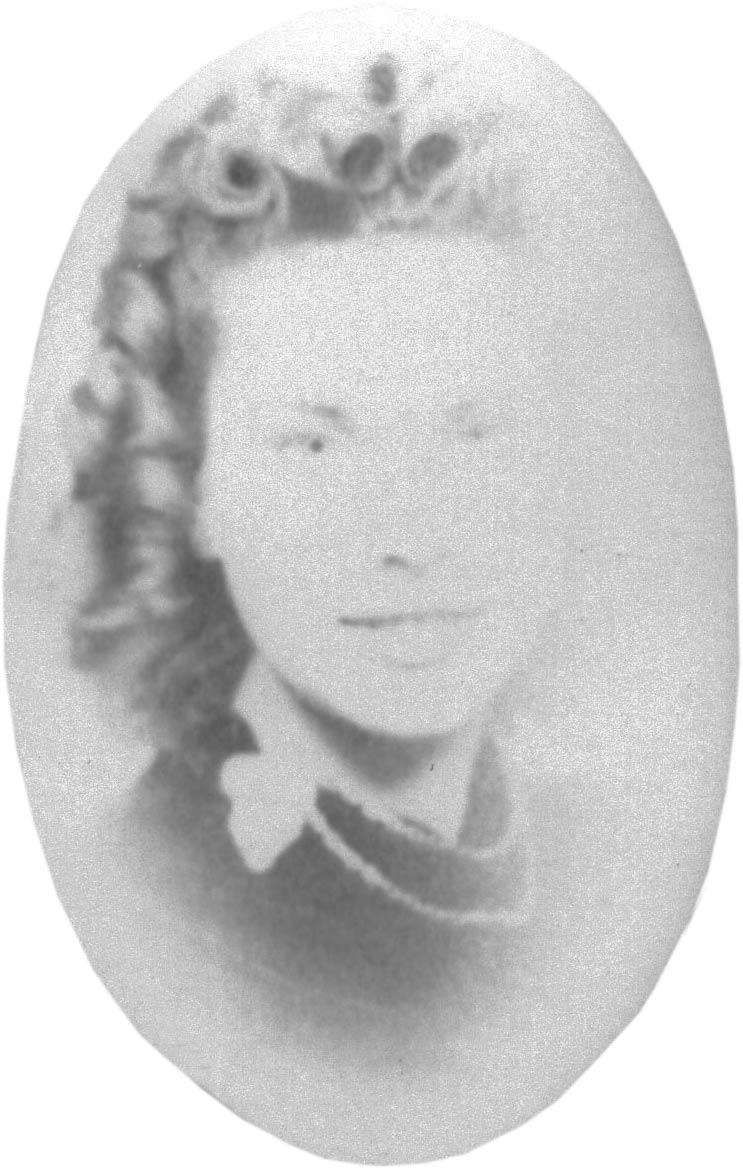
|
| Mom in 1937
|
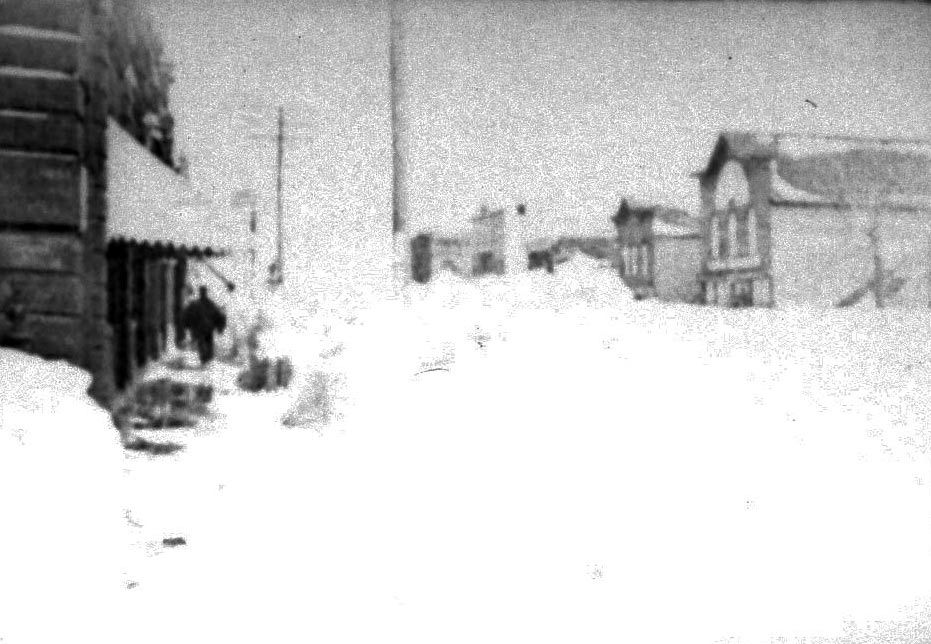
|
| Minneota winter
|
Mom had a whole photo album of Minnesota and her time in the Navy, but it
disappeared after she died.
There were
photos of the house, of her as a little girl, and even of a snowfall so deep
that people went from place to place through snow tunnels... treasures she
had preserved her whole life. Luckily, on a visit to Big Bear in the 1980s,
I took black and white photos of all the pages with a film camera. But
un-luckily, almost all of my photos-of-photos were overexposed and
washed out. I've done my best with Photoshop to rescue the faded ones
you see in this section.
When Mom was born in 1922, the Lunds lived in a
modest two-story house on South Jefferson
Street which was big enough for Hannah, Carl, and the seven children (only
Polly had left home, and Doris and Shirley were yet to arrive). Carl was
presumably still contributing something to the support of the family, but I
don't know the details. Even so, Mom said her mother was on welfare ("home
relief") and took in laundry but that still wasn't enough to pay the rent so
the kids would have to miss school to babysit or do other chores to get some
money. Ella, for example, was farmed out as a live-in babysitter in
faraway places for weeks and months at a time. Of course no food went to
waste; nobody was a picky eater. Even in later life, when Mom ate an apple,
she ate the whole thing, core, seeds, and all. When she ate chicken, she
ate the bones too.
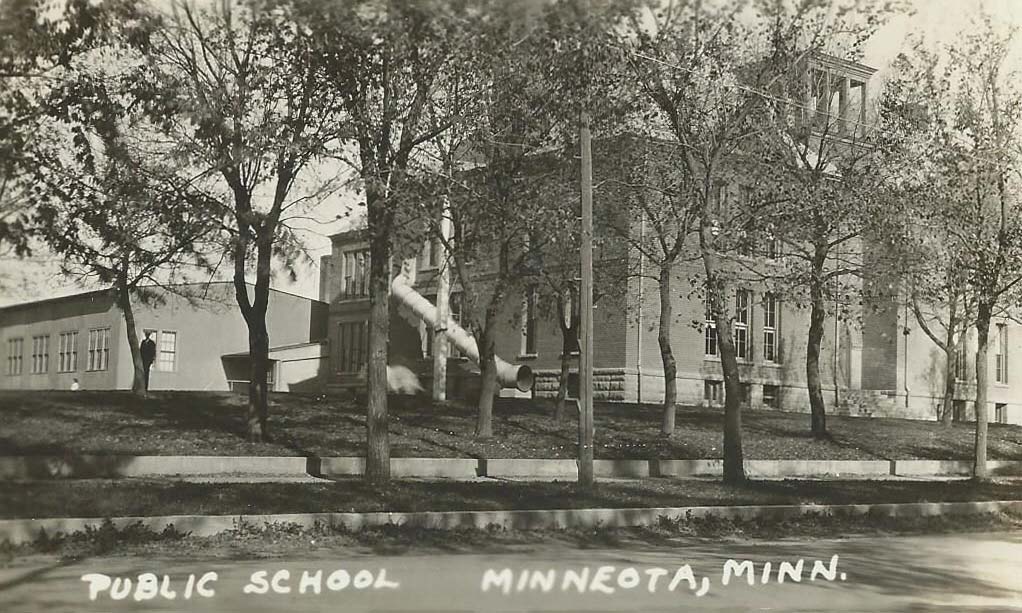
|
| Minneota Public School
|
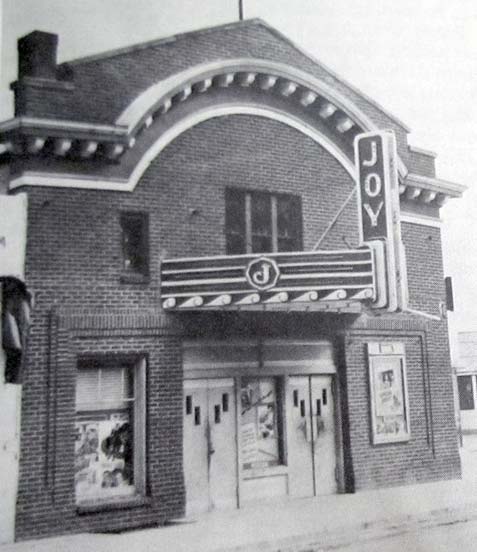
|
| Minneota Joy Theater
|
By the time Mom was a teen, no later than 1935, they moved to
a
tiny one-room house with one bed for everybody,
right across from the school. The rent was $10 a month. Carl and seven of
the children had already left home, so it was just Hannah, Mom, Doris, and
Shirley. Mom worked as a cashier at the Joy movie theater ("Hollywood
glamour available year-round"), which allowed her to stay in school and
eventually to graduate.
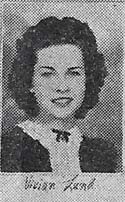
|
| Vivian Lund 1940
|
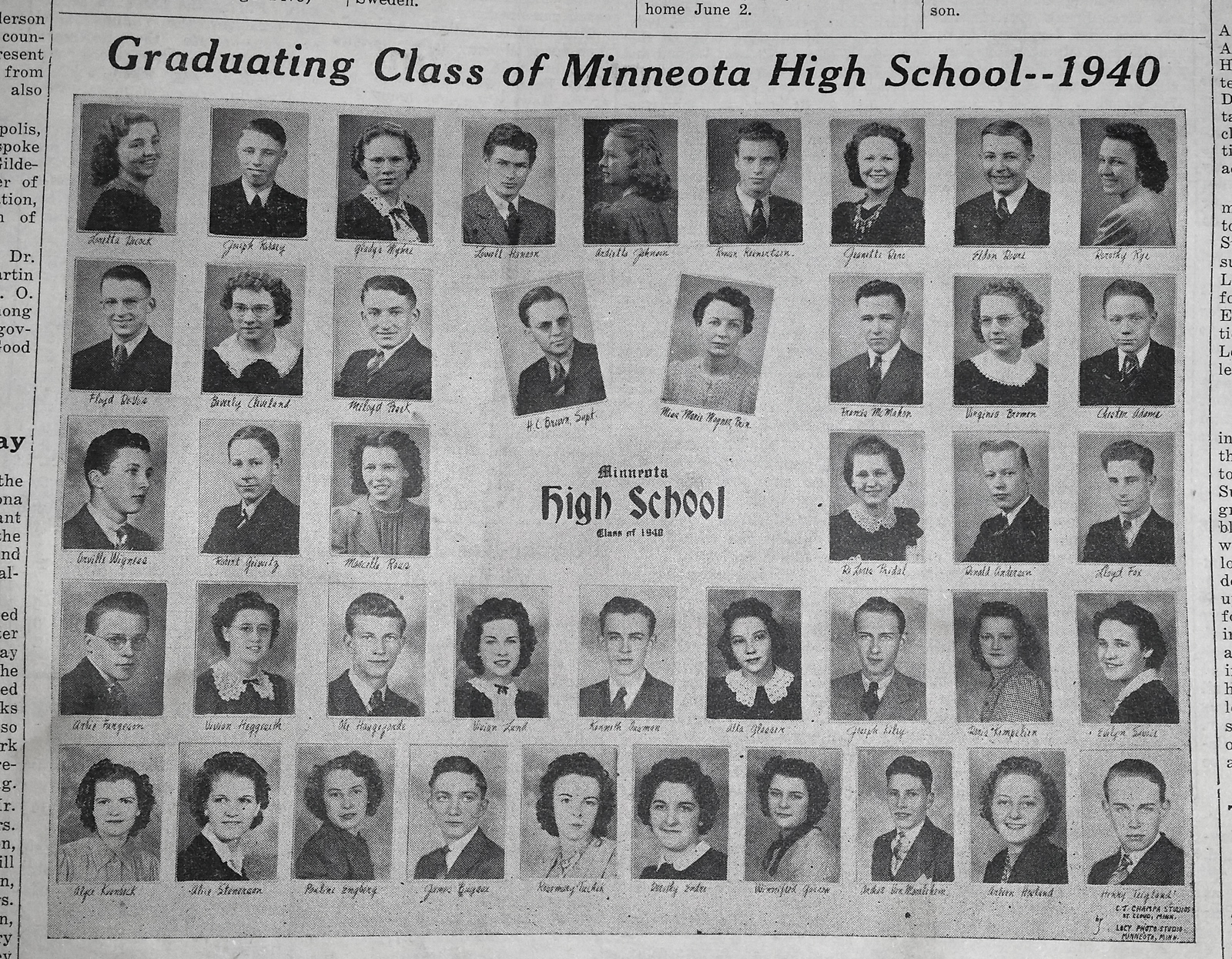
|
| Minneota HS class of 1940
|
I know that Mom was popular in high school, acted in school plays, was a big
fan of Swing music, liked to dance, and probably had boyfriends. Dana Yost
says there were none of the normal kinds of teenage hangouts in Minneota,
such as a drug store or soda fountain, but the Big Store had an "opera hall"
upstairs with a dance floor, where touring bands sometimes gave dance
concerts. For any real nightlife they'd have had to go to the Blue Moon in
Marshall, 12 miles away, but I don't know if Minneota teenagers drove cars
in those days. But in any case, the April 1940 Mexican-themed Junior-Senior
prom was the event of the season and I'm sure it was a big deal for Mom.
The photos are from the from the
Minneota Mascot, high-school
graduation issue, June 1940; Mom is 4th row, 4th from the left, full-size
cutout to its right. The accompanying Mascot article noted that "First
choice for school queen and generally accepted as the class beauty, Vivian
Lund says that everything is 'Jake' with her and has been for the last
decade." ["Jake" is 1940 hep-cat talk.]
Mom's houses
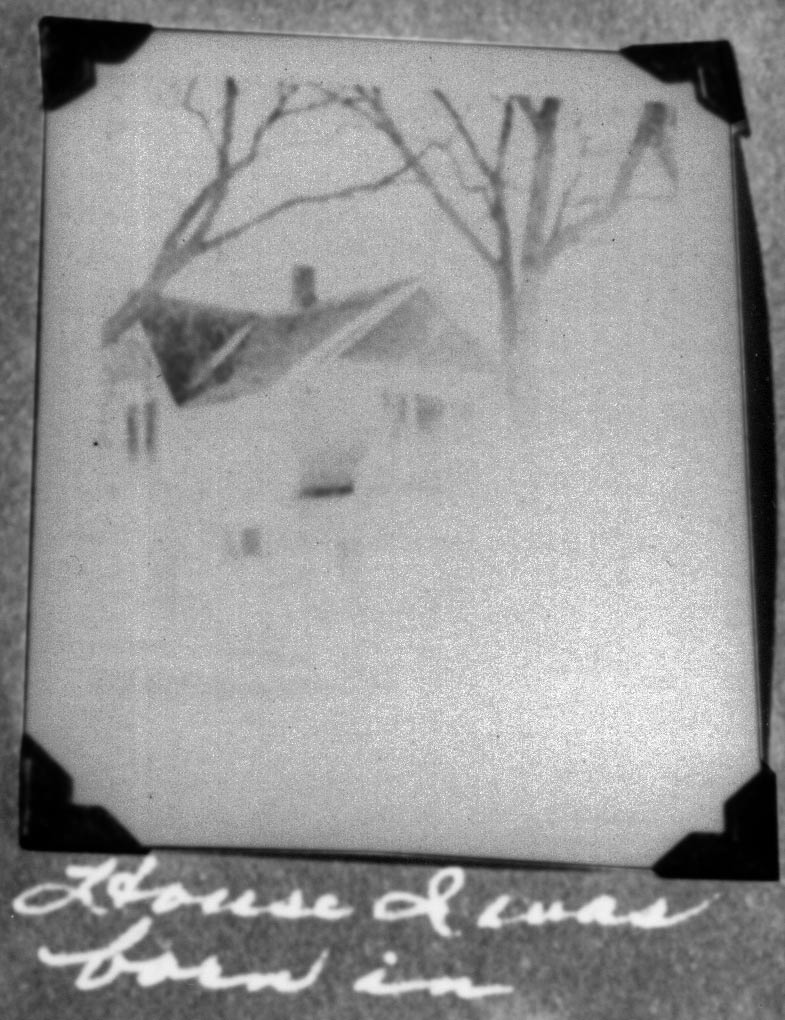
|
| First house
|
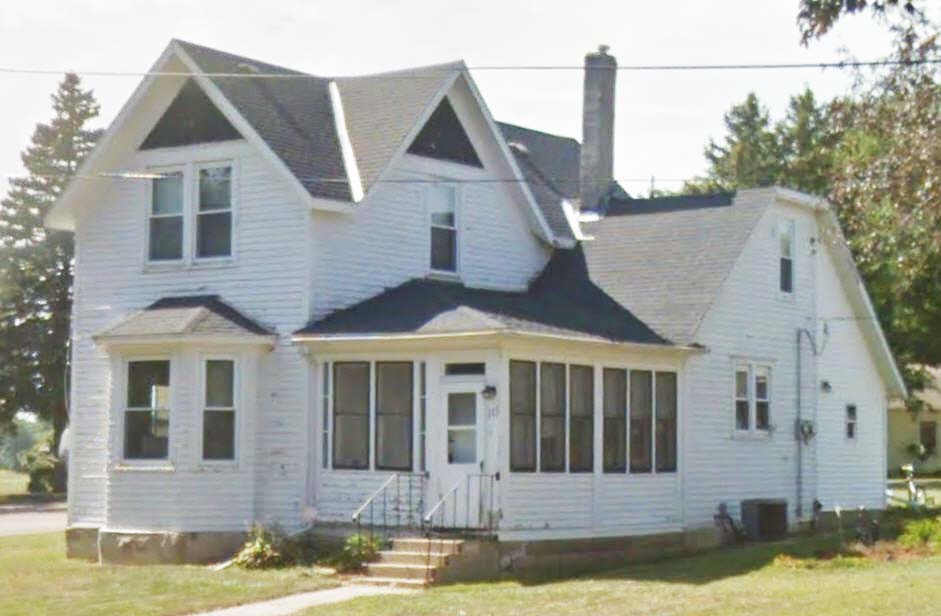
|
| House at 111 South Jefferson Street
|
I was interested to know if the houses where Mom lived were still standing.
A breakthrough came when Sandy spoke with Betty VanMoorlehem (born in 1931),
daughter of Mom's brother Clarence. Betty said the Lunds' first house was
at 106 South Jefferson Street; the house that is there today, although very
small, does not match Mom's photo at all. So I looked around the immediate
area in Google Street View and across the street I found the house shown in
the color photo, at 111 South Jefferson Street, right next door to Hope
Lutheran Church. It seems to be a perfect match; look at the configuration
of the roof, gables, and second-story windows. Clearly there have been
considerable additions since then (and the chimney moved) but this could be
the house where Mom was born, and Doris, and Shirley.
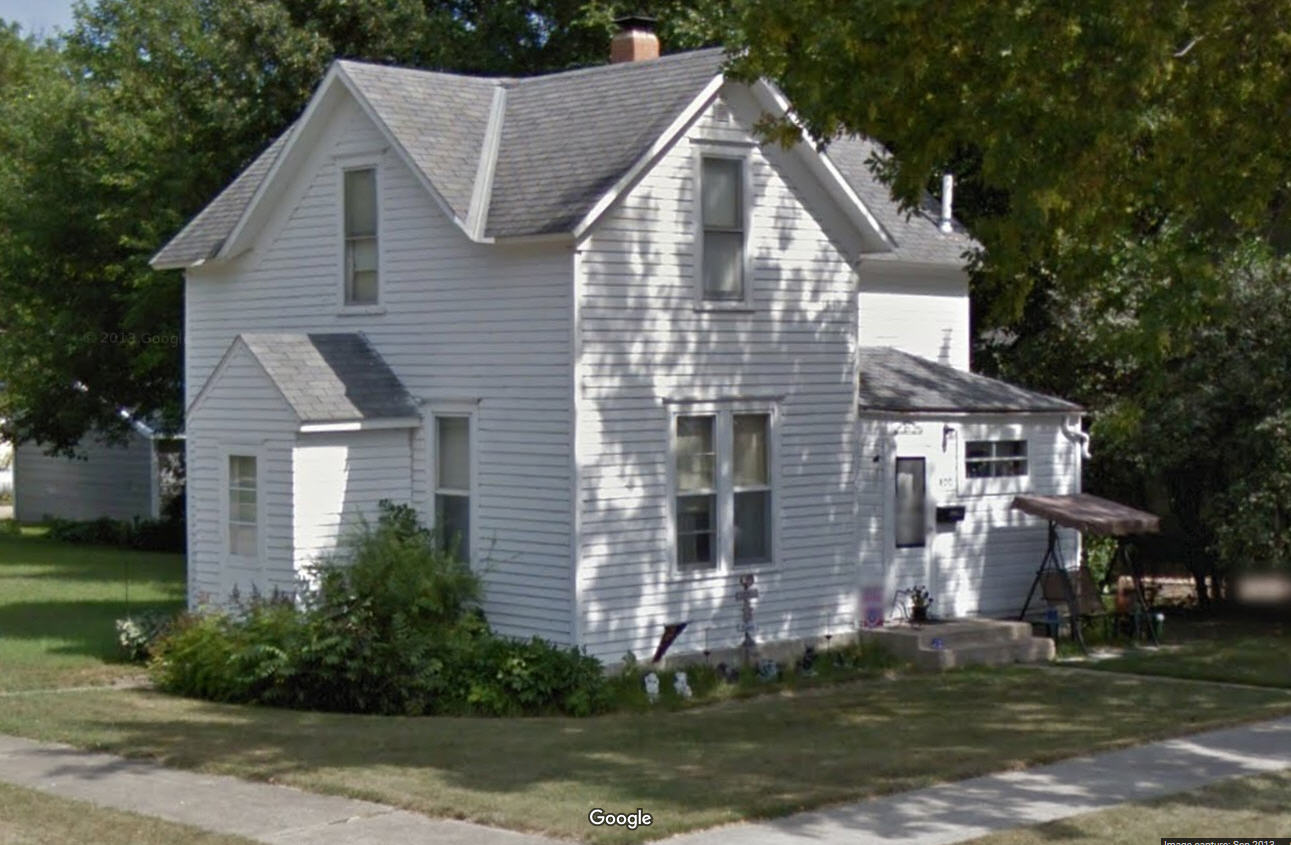
|
| Newer house the same address
|
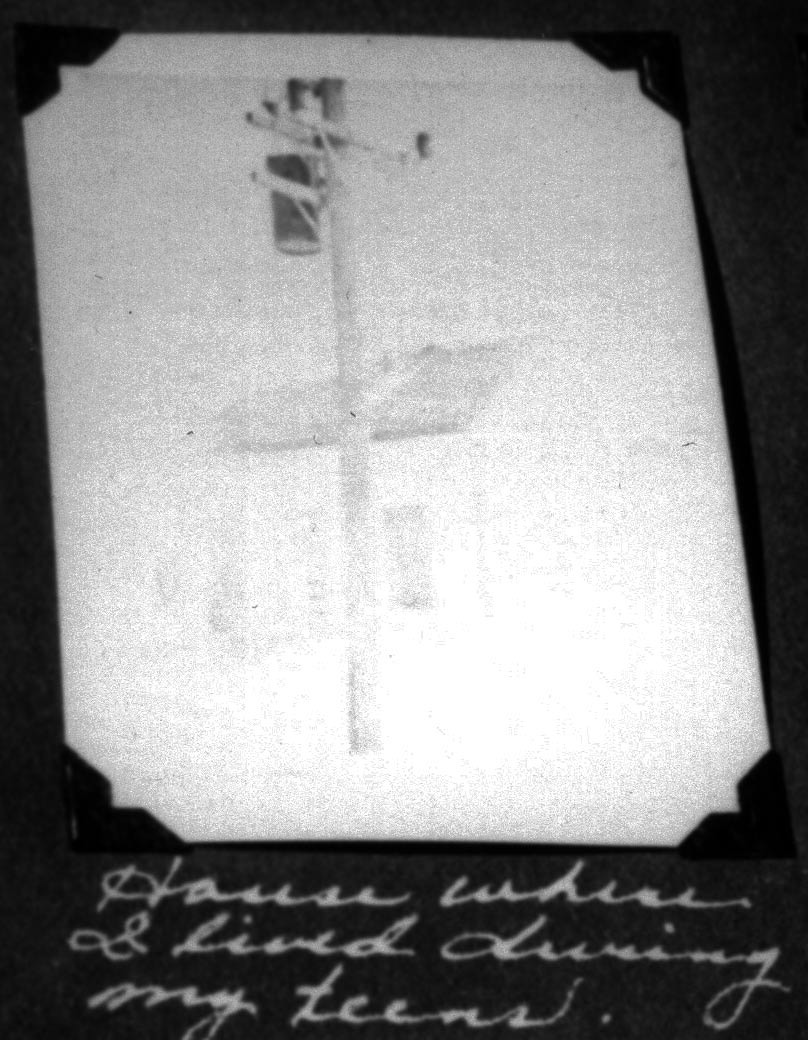
|
| Second house
|
Betty said the second house, the one by the school, was at 400 East 3rd
Street, on the corner with North Jackson Street. The color photo from
Google Street View shows the house on that corner as of 2013; clearly it
bears no resemblence Mom's photo. Betty also said that later (after Mom and
Doris moved out), "Shirley and Hannah also lived in the little house north
of Bill Holm's house. She remembers that Hannah would give Shirley a nickel
and Shirley would go down to Meger's Cafe and drink pop while other girls
their age would be working for someone to raise money." Sandy, repeating a
story of those days passed down by one of Mom's little sisters, said that
this house "had no running water...they were very poor...she hated to go to
school because she could smell how bad she stunk."
The girls who drowned
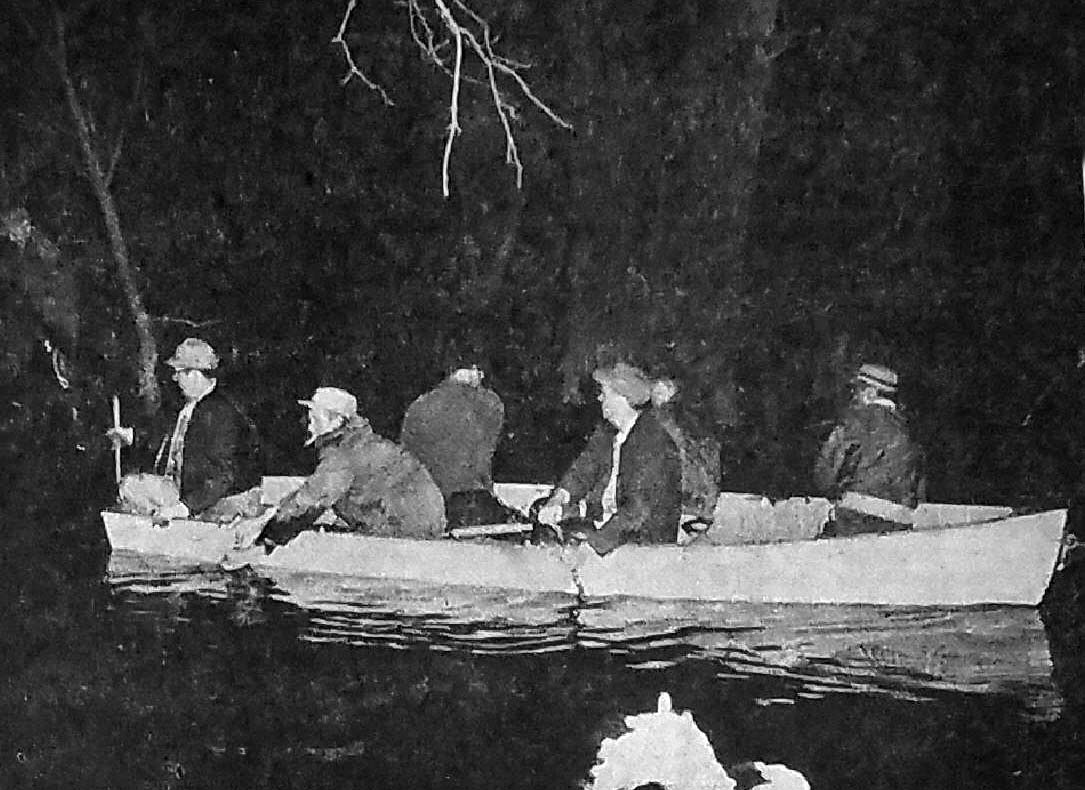
|
| The search for the girls
|
A melancholy postscript on the Lunds of Minneota. Doris and Shirley still
lived there in 1960; Doris was married with Earl Jasperson and they had five
children; Shirley was married with Leonard Hasel and had four children,
including one from a previous marriage. One day Doris's 8-year-old
daughter, Judy Ann, and Shirley's 4-year old daughter Cheryl went out to
play and never came back. They fell into the Yellow Medicine River and
drowned.
CLICK HERE to read the
story in the Minneota Mascot. It was a blow that Doris and Shirley never
recovered from and, I suspect, the reason they never left Minneota.
San Francisco
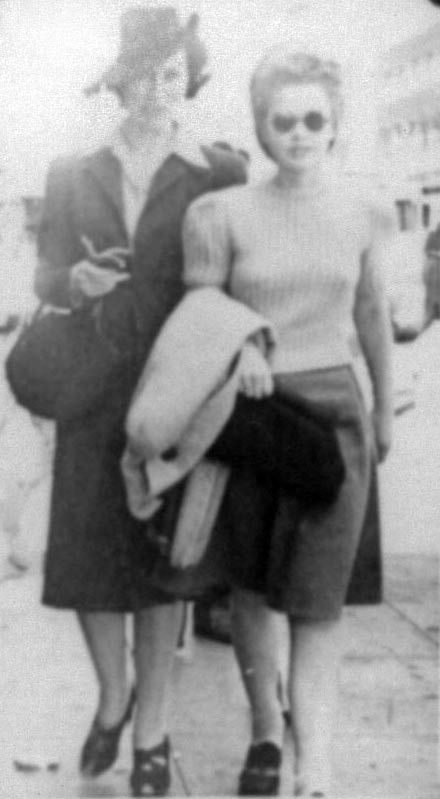
|
| Polly, Mom 1940
|
All of the Lund kids but the last two left home as soon as they had a
chance. Polly was the first to leave at some point between 1920 and 1927;
she got a job at Pacific Telephone & Telegraph in San Luis Obispo as a
telephone operator, transferred to San Francisco in 1935, and rose through
the ranks to become important enough to be able to bring some of her sisters
and brothers to California and, in some cases, got them jobs there too. My
Mom for one, who went there right after she graduated high school in 1940
and became a telephone company draftswoman, a job Polly arranged for her,
and she lived with Polly for about a year.
Navy WAVES
[
SEE NAVY WAVES GALLERY]
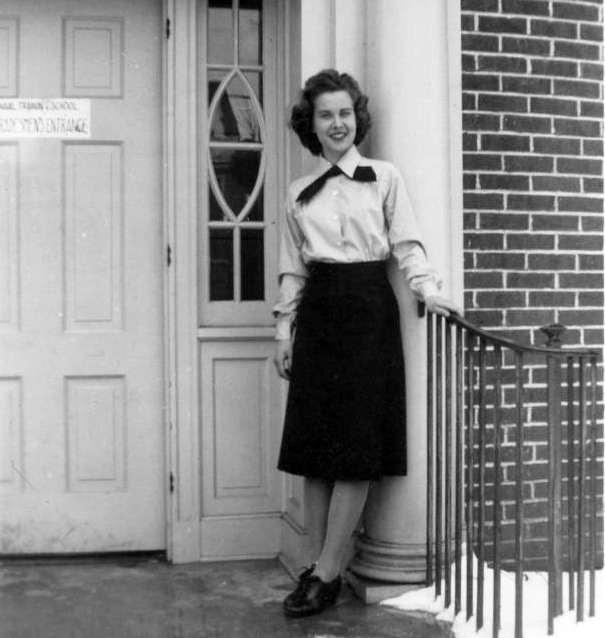
|
| Mom in the Navy, Cedar Falls Iowa 1942
|
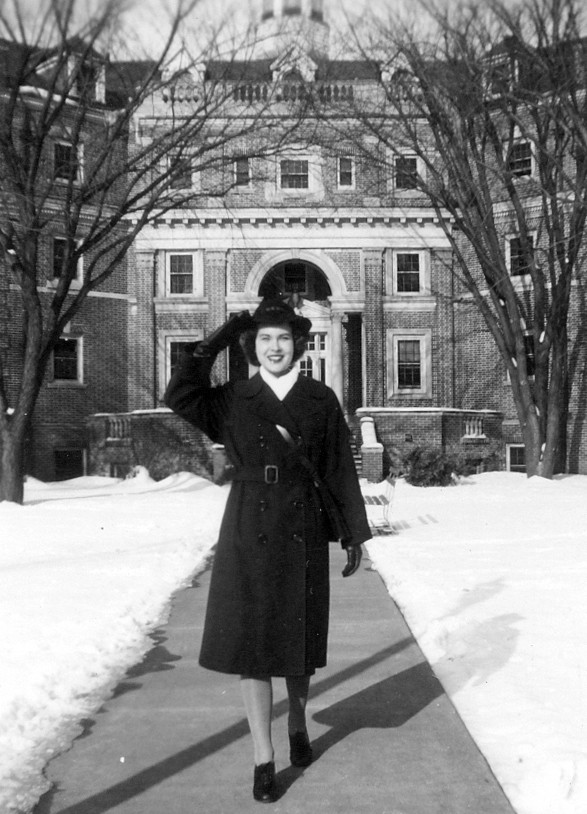
|
| Mom in the Navy, Cedar Falls
|
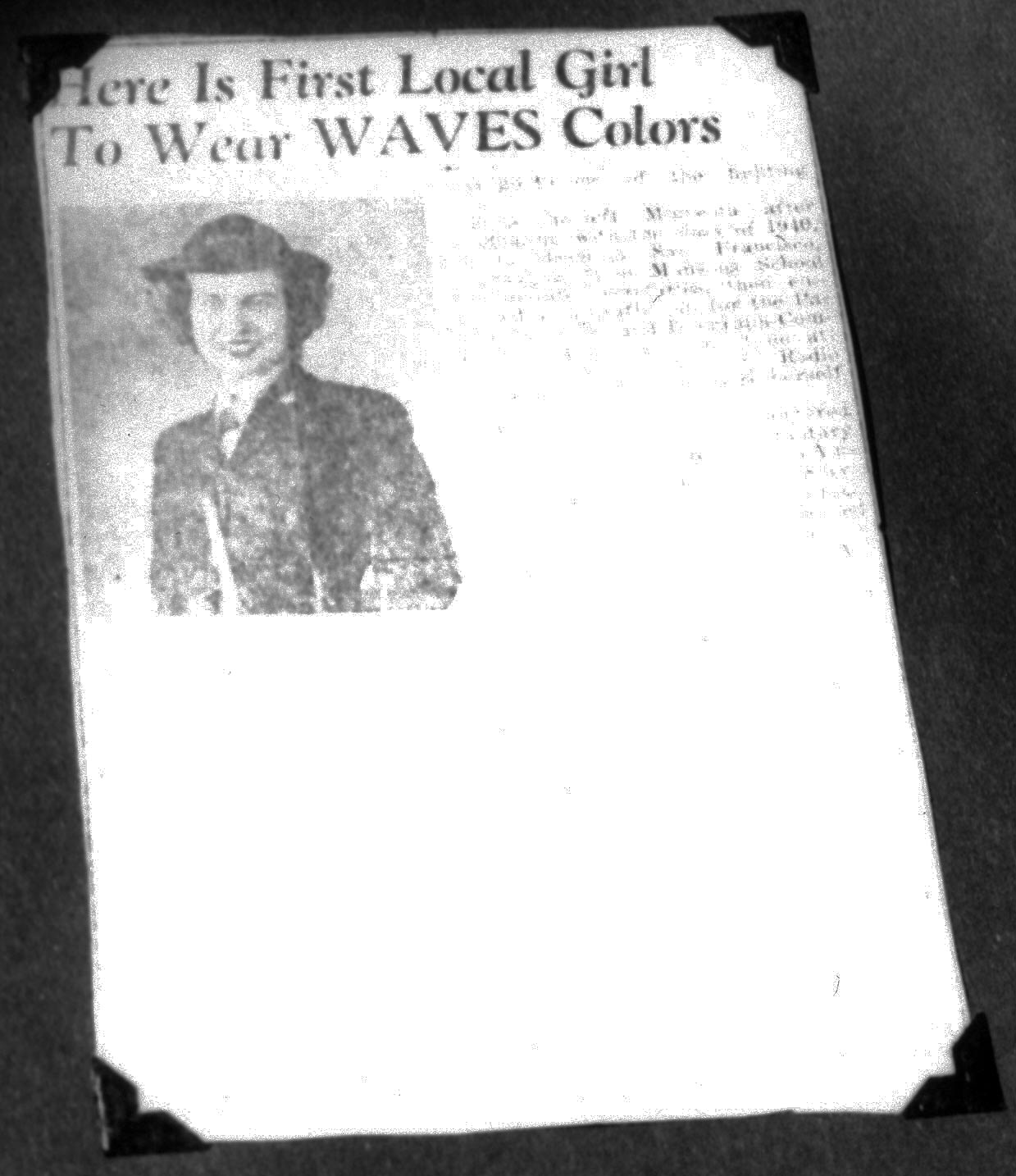
|
| Mascot article
|
Besides her PT&T job, Mom also got training as a private secretary,
learning typing and Gregg shorthand. When the USA entered World War II in
December 1941 she wanted to do her part so, while still working, she joined
the American Womens Voluntary Service, sold War Bonds, and also went to
night school in radio communications. There was talk that the armed
services would open up to women and she wanted a head start. By this time
she had moved out of the house of Polly (who, Mom said, treated her like a
slave) and lived at the YWCA. As soon as she finished her training she
signed up for the just-created women's branch of the Navy, the WAVES (Women
Accepted for Volunteer Emergency Service) November 14, 1942. Her hometown
newspaper, the
Minneota Mascot, published an article about it (this,
along with most of her Navy pictures, were in a scrapbook I do not have, but
later I obtained a
copy of the article from
the people at the Mascot, which still exists and has all its back issues in
binders). She had her six weeks of Basic Training at the US Naval Training
School in Cedar Falls, Iowa — not
at
Lehman College as I had
fantasized (Lehman — Hunter in those days — is near my Bronx
apartment and was the only WAVES basic training center from 1943 onwards.
Then they received advanced training in their assigned specialties at
Oklahoma A&M, Indiana University, University of
Wisconsin at Madison, Smith College, Miami University of Ohio, Georgia
State Collge, Burdett College, etc [
11].
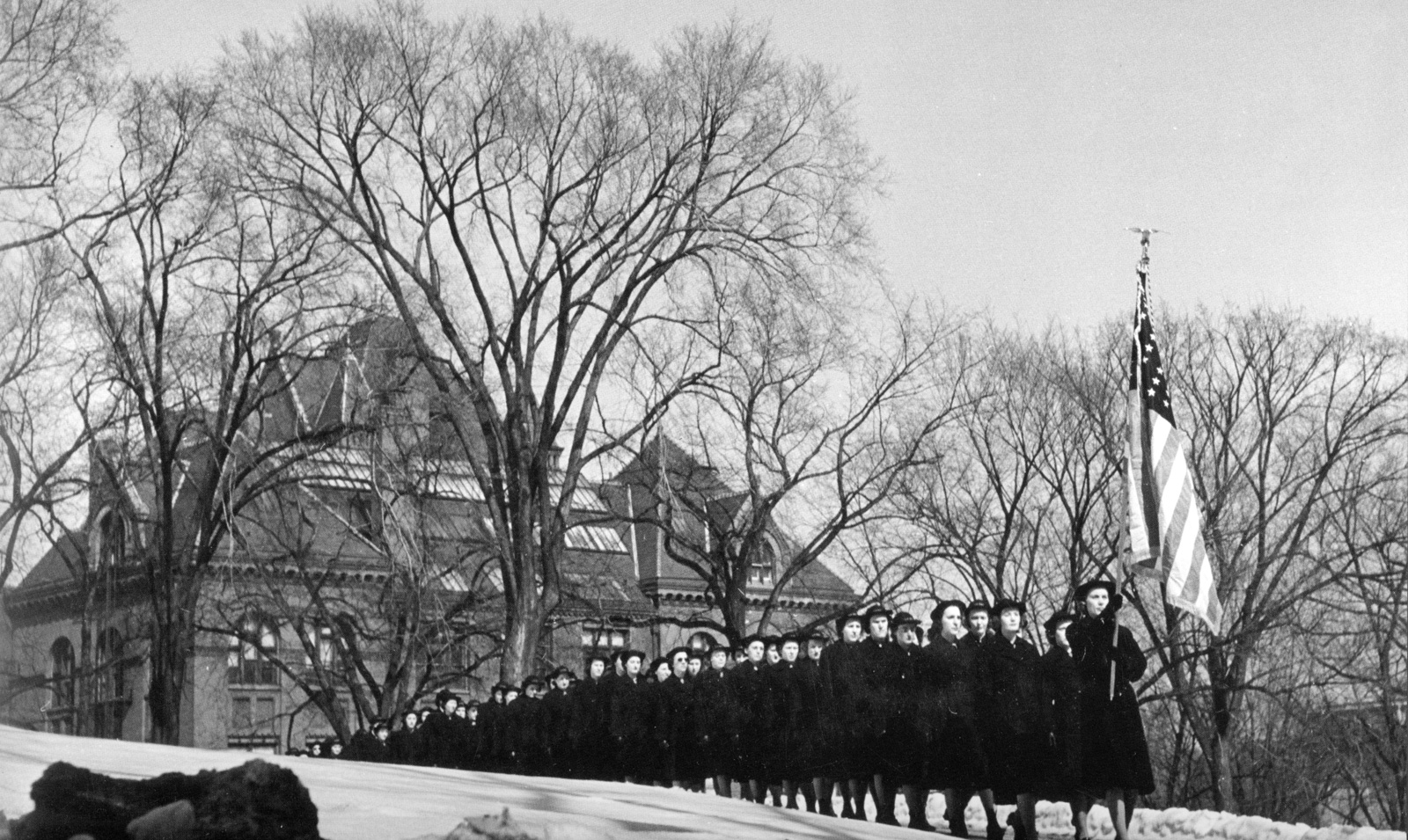
|
| Waves in Cedar Falls 1943
|
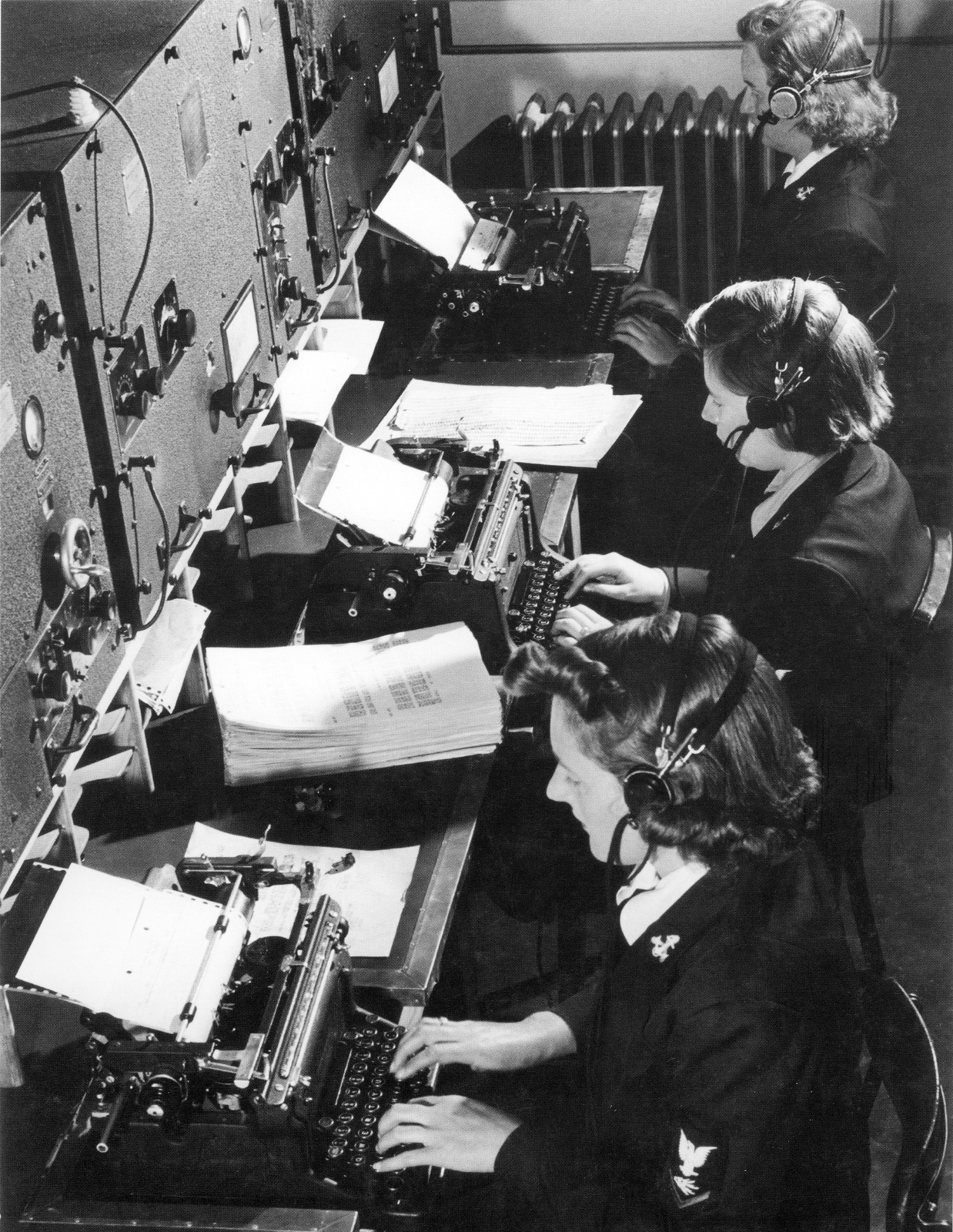
|
| Waves Radio School 1943
|
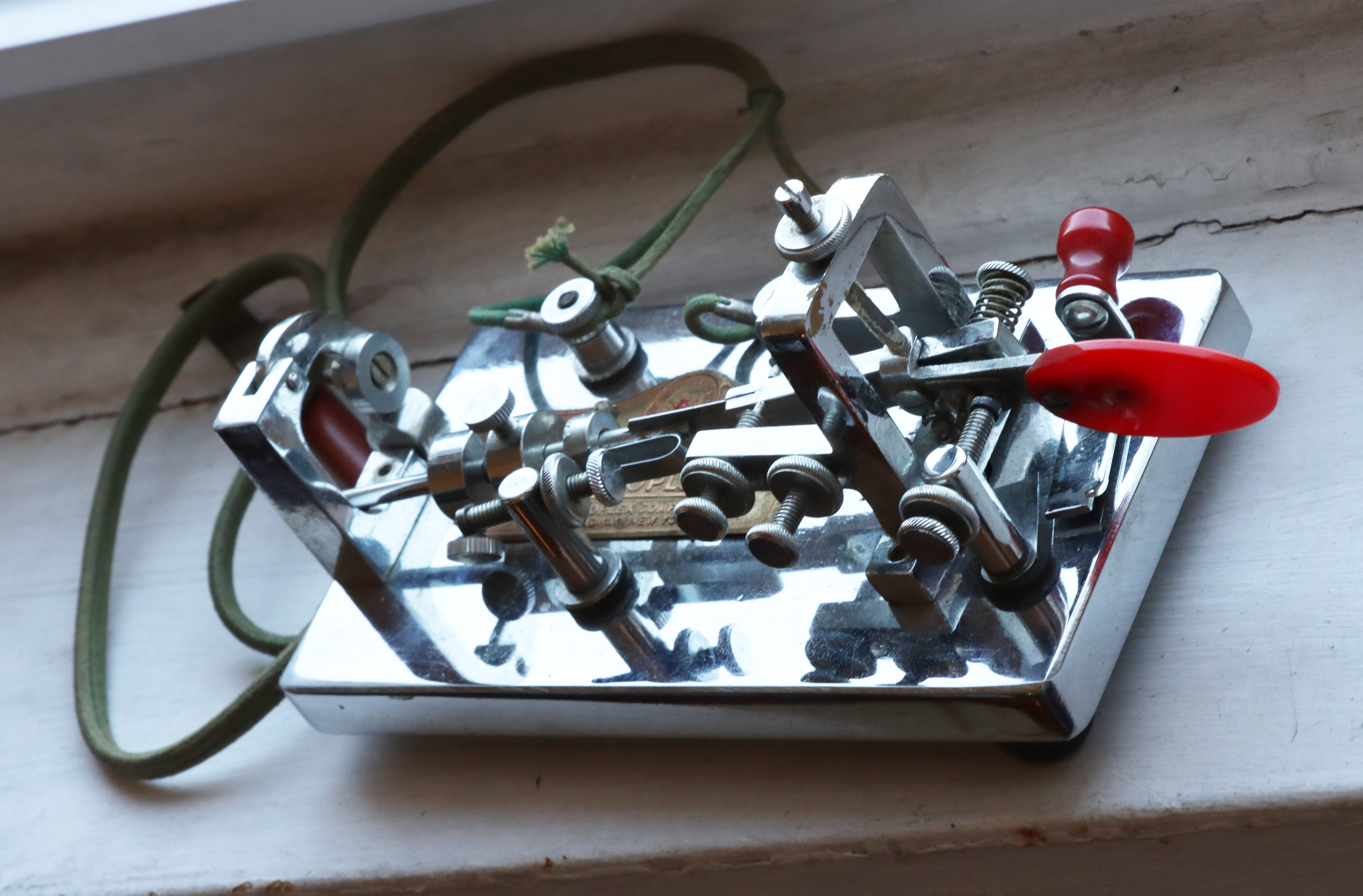
|
| Mom's semiautomatic paddle code key
|
After Basic Training in Cedar Falls, Mom went to Navy Radio School at "RS
NYD Washington DC" (Radio
School Washington
Navy Yard) in Anacostia. She excelled as a military code operator.
Just like my dad, she could transcribe incoming Morse code onto a clunky old
manual typewriter at 120wpm, and nobody could transmit code faster than she
could; for this she had a special side-to-side code key with all kinds of
springs, balances, counterweights, and adjustment points... it's called a
"semiautomatic paddle key"... purely mechanical but she could make it
"autorepeat" at lightning speed, which took enormous skill. We had it
in our house when I was little and they gave me Morse code lessons on it. I
never saw it again until October 2024, when cousin Danny discovered it in a
long-forgotten storage locker in Washington DC and sent it to me. The cable
would plug into a console like the ones shown on the left side of the center
photo above and (better photo) HERE.
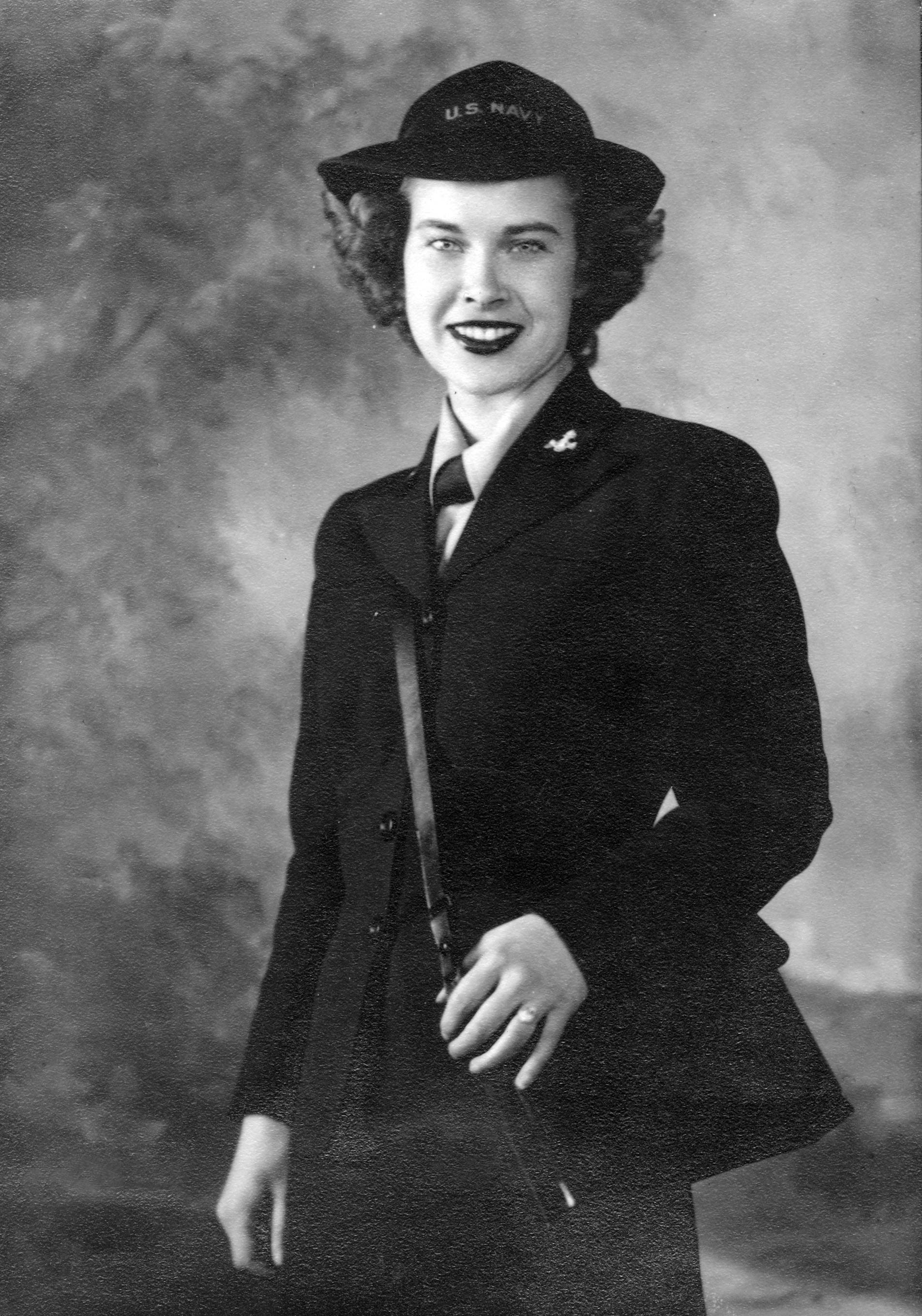
|
| Mom Navy portrait 1942
|
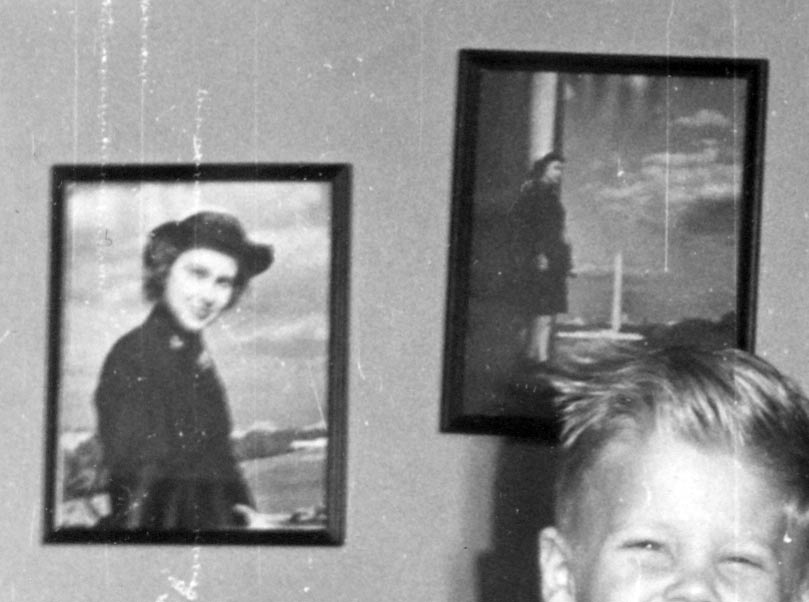
|
| Mom Navy pictures (and Dennis)
|
She was so good that she was assigned to Navy headquarters in Washington DC,
nerve center for the naval war in all theaters, where she worked as a "Radio
Wave"; as a recruiting poster said, "receiving dispatches direct from the
battle fleet ... an important link between the men who plan strategy ashore
and those who carry it out at sea." She met my father who wound up there
too, having some five years experience as a radioman on ships such as
the
USS Omaha (CL-4, the one built in 1916).
Unfortunately I know next to nothing about my Mom's years at the Navy
Department, except that she lived in temporary barracks near the Reflecting
Pool, between the Lincoln Memorial and the Washington Monument and close to
the Navy building. One interesting thing about the WAVES, though: it was
the
only branch of US military
service that was fully integrated in WWII (but starting only in December
1944). The framed pictures are of Mom in the Navy in Washington DC.
I don't have copies of them.
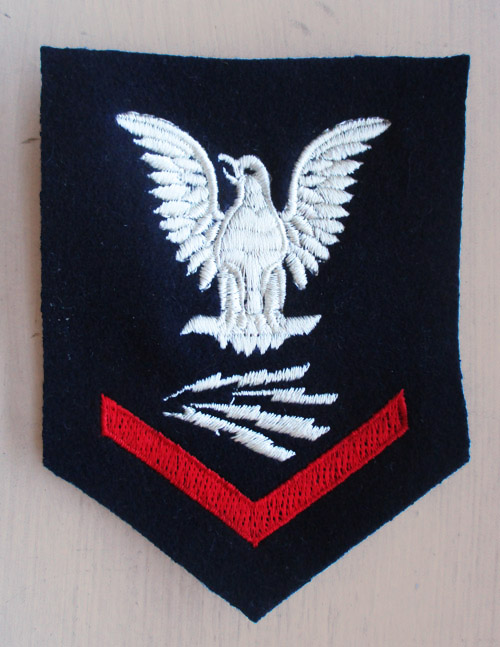
|
| Mom's chevron
|
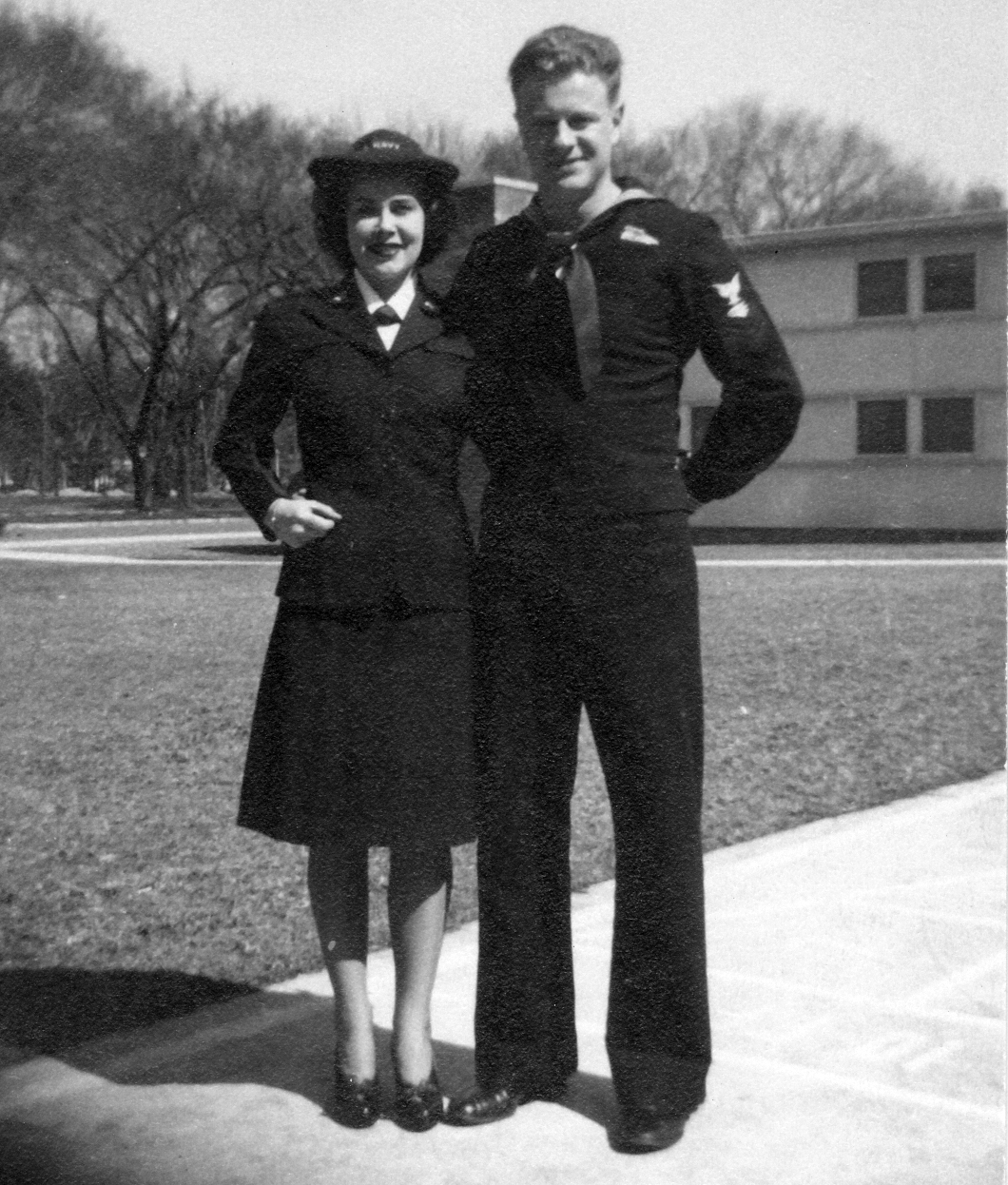
|
| Wedding day
|

|
| Wedding portrait
|
My mother and father were married March 14, 1944, in Washington DC in
their Navy uniforms, most likely in one of the Navy buildings, perhaps
the observatory (right photo). Mom's chevron is not fully visible
in the wedding photo but you can see it at left: World War II US Navy
WAVE Female Rate 3rd Class Radioman.
She was released from the Navy May 10, 1944, two months after getting
married, because she was pregnant (official reason: "Convenience of the
government"). If that had not happened, her enlistment would have ended
March 2, 1946 (six months after the Japanese surrender on September 2nd,
1945 — all wartime hitches were for "duration plus six months").
Fifty-some years later she received a citation from President Bush (W)
thanking her for her service. I know that her time in the Navy was a high
point of her life; she had a lot of friends — it was like going to
college and living in the girls' dorm — and she was doing important
war work. In later years she was proud to display the photos of herself in
uniform. My great regret with her, as with all my family, is that I never
asked them about their lives.
References -
Source material and recommended reading and viewing...
- Bachner, Evan, "Making
Waves - Navy Women of World War II", Abrams,
New York (undated). A big coffee-table book of photographs of WAVES
during the War.
- Mundy, Liza,
"Code
Girls - The Untold Story of the American Women Code Breakers of World War
II", Hachette Books (2017). My Mom was not a code breaker as far as I
know but she transmitted messages they had encrypted and received encrypted
messages for them to decrypt. Chapter 6, "Q for Communications", is
about the WAVES codebreakers and the buildings they worked in.
-
WWII Women Cracking the Code, Smithsonian National Air and Space Museum:
"A major part of the WAVES’ job was building and operating the Navy
Cryptanalytic Bombe, a 2.5 - ton electromechanical device developed to
break the four-rotor enigma messages from German U-boats. Six hundred WAVES
worked three eight-hour shifts, seven days a week at the National Cash
Register Company (NCR) in Dayton, Ohio, where they learned how to solder
and connect wires, read electrical diagrams, assemble rotors, and build 121
of these machines with no idea what they were building or why. It was
tiresome, tedious work that allowed no room for error. After the first
successful Bombe run in May 1943, the WAVES traveled with their Bombes by
rail back to the Navy Annex in Washington, DC, where they operated the
machines through the end of the war." The Navy Annex was about four
miles north of the Navy building (see this page).
- Video: U.S. Navy Cryptanalytic
Bombe, National Cryptological Museum.
- "Navy Service - A short History of the United States Naval Training
School (Womens Reserve), Bronx, New York", US Navy Training Service (1944).
- "Here
Come the WAVES", Hollywood feature film; Mark Sandrich (Director),
Paramount (1944). Includes location shots at USS Hunter (now Lehman College).
- "Homefront
Heroines: The WAVES of World War II", documentary film;
Kathleen M. Ryan (Director)
[website] (2012).
- The
little-known story of the Navy women codebreakers who helped Allied
forces win WWII, CNN, 4 August 2020.
- Munch, Janet Butler, Making Waves in the Bronx: The Story of the U.S.
Naval Training School (WR) at Hunter College, City University of New
York (1993).
- Christine Heidenrich,
Women Accepted for Volunteer Emergency Service: The WAVES PROGRAM
in World War II, National Air and Space Museum of the Smithsonian
Institute, Washington DC (2020).
-
Speciality Training, at
Homefrontheroines.com,
accessed 30 November 2023.
- Major General Mari K. Eder, The
Girls Who Stepped Out Of Line, Sourcebooks (2021). Chapter 12: Code
Secrets. More about the WAVES who worked in Signals Intelligence during
World War II.
After the Navy
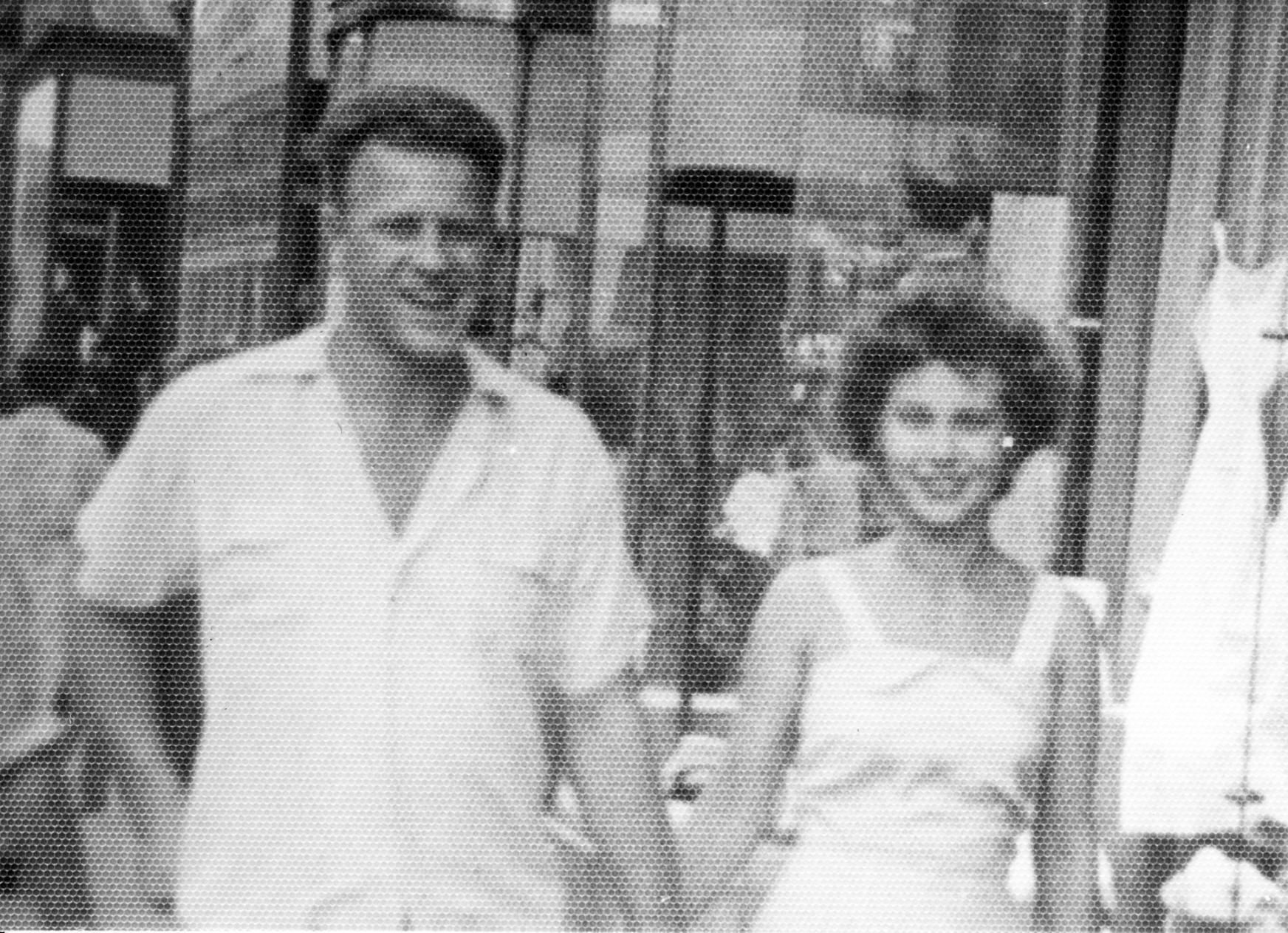
|
| Mom & Dad on a date, DC Aug 1947
|
Mom was a housewife for 20 years. Like many postwar mothers, she didn't
have a job; she stayed home all day to take care of the house and kids. I
don't think I knew any women who had jobs when I was a child, except my
teachers (and my friend
George Gilmer's
mother who had been social worker before marriage, and then worked in a
church office and then at AG Bell, Alexander Graham Bell Society for the
Deaf). In those days, even a meager salary from one single 9-5 job was
enough to support a family, even with a house and a car. My dad got out of
the Navy in 1946 and had
bought a house by 1947
(with a GI loan, of course), supporting a wife and one child and making
mortage payments on one paycheck. Three years later, a second child and a
car. He left the house for work at 8:30am and got home 5:30. The whole
time I lived at home (until 1962), his salary was the only income.
Mom did a lot of things with me when I was little… she taught me
to read and write, she made flashcards for math, and sometimes we even
played together (I remember some races, and I remember a dough fight we had
once when she was baking bread). The only time she ever asserted herself
with us was when we refused to eat something; she could never let food go to
waste.
I reconnected with childhood friend Jimmie Walker in 2014 (after 58 years).
One of the first things he said to me was "[your Mom] used to just appear
with a platter of orange slices or other goodies. She was like an angel
— perfect in every way. All the other boys wanted a mom like Vivian
da Cruz. I think of her often and remember how very beautiful she
was." It's true; back in those days there used to be chain gangs of Black
convicts working on the dirt road in front of our house; she'd bring them
orange slices and big pitchers of cold water. George Gilmer, who I've known
since 1947 said "I always thought that your Mom was one of the prettiest and
nicest Mom's in our neighborhood."
At some point in the early 1950s my father's personality changed. I
remember him being pretty normal when I was little; I liked him, I wasn't
scared of him. He and Mom got along well and even had some funny routines,
like long conversations in Navy jargon or Morse code. But now he was angry
all the time, yelling at us, beating us, and he subjected Mom to withering
verbal abuse every night when he came home, especially over dinner. Then
after dinner he drank until he passed out. So that was Mom's (and our) life
for about ten years.
In October 2018 Danny sent me scans of letters from Dad to Pete, 1941-1959.
In them he speaks admiringly and at length of Mom. Throughout the first
five years of marriage, the only anger he expressed was towards greedy
money-hungry doctors and wishing for "socialized medicine". Just before
Dennis was born in April 1949, Dad and Mom were already planning on a third
child, a girl to be named Delores (not Maritornes, he joked — a
character from Don Quixote, which he had just read, probably to
impress his dad, who was a professor of it and even had published a
translation, which was no doubt the one Dad had read). Mom's first suicide
attempt was in mid-1953. Dad concluded it was because the house was too
small and that's why he built the addition.
My Mom was the typical stoic Norwegian. She put up with dad's abuse and
other hardships all that time, never complaining, but withdrew; she didn't
talk about herself, she never expressed opinions, and after things got bad
around the house, she never expressed any emotion, never laughed or cried;
she wasn't affectionate, she just did her cooking and cleaning and sewing
all day every day and put up with Dad. When I read "Giants in the Earth", I
pretty much recognized my Mom in Per Hansa's wife, Beret.

|
| Mom & me 19th Street 1945
|
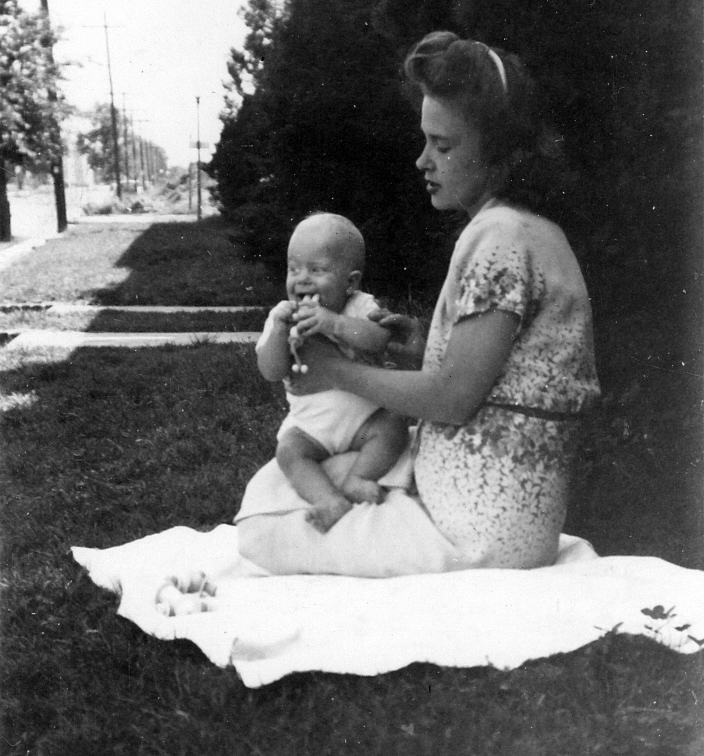
|
| 19th Street 1945
|
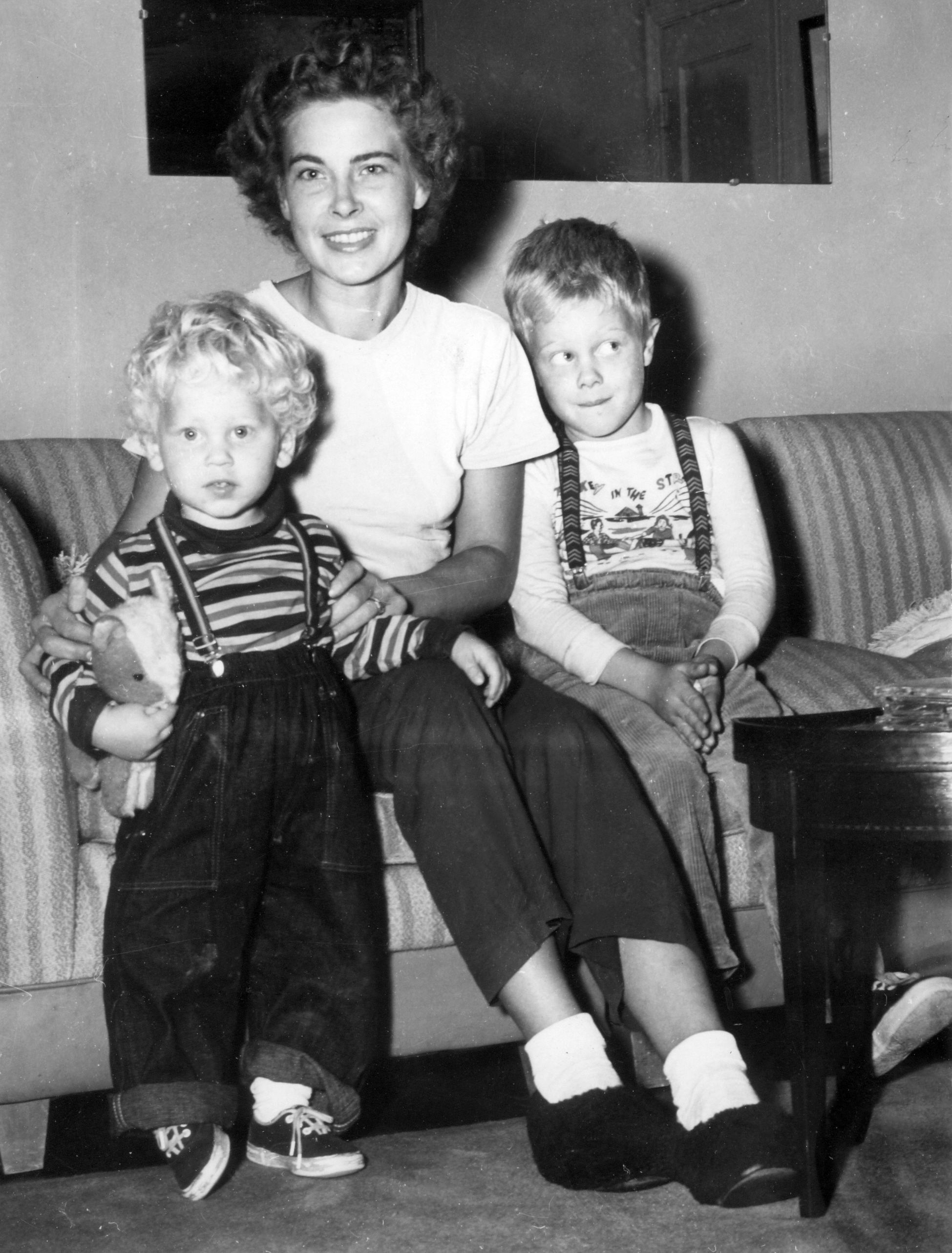
|
| Chesterbrook 1951
|
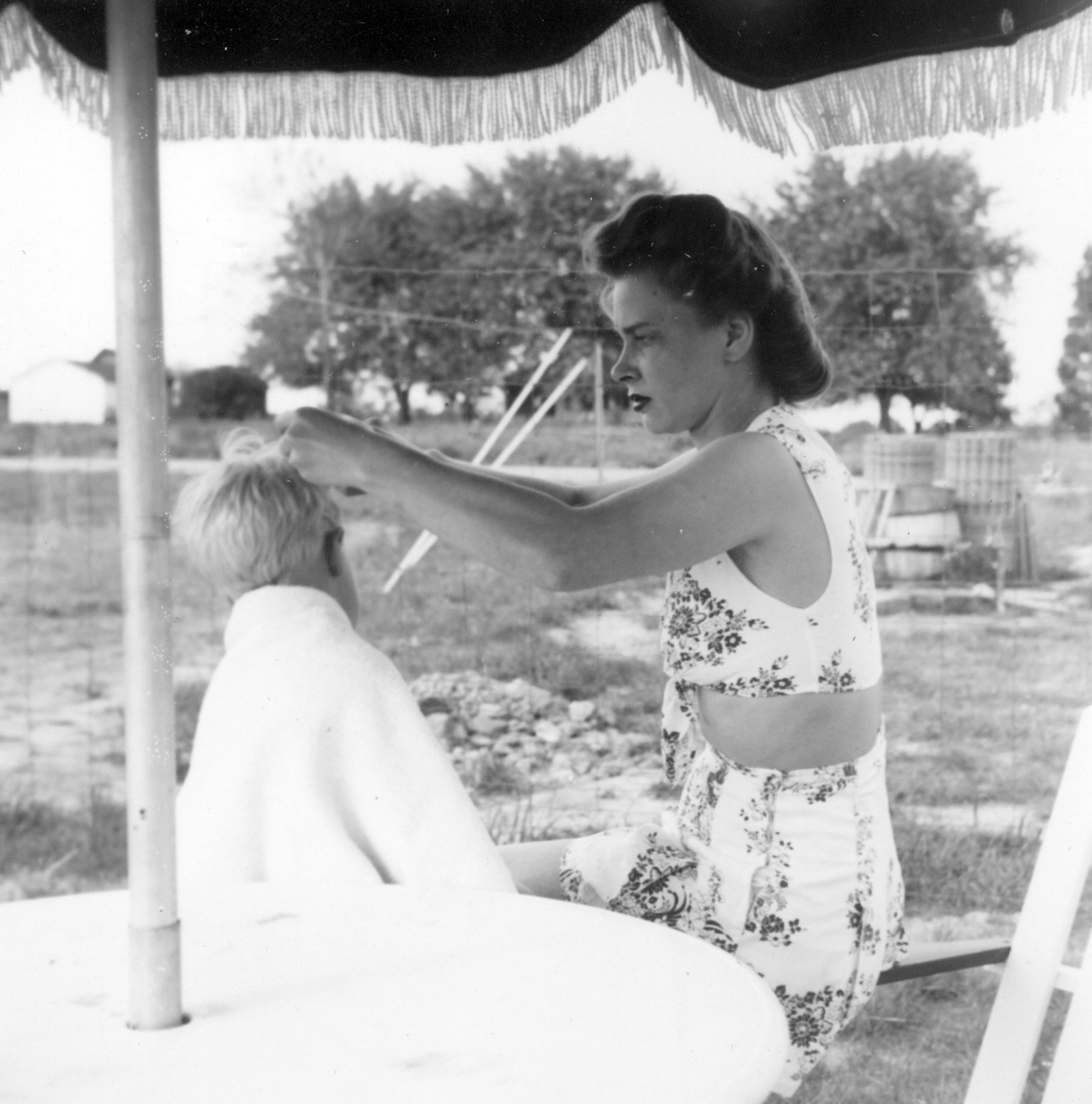
|
| Haircut 1952
|
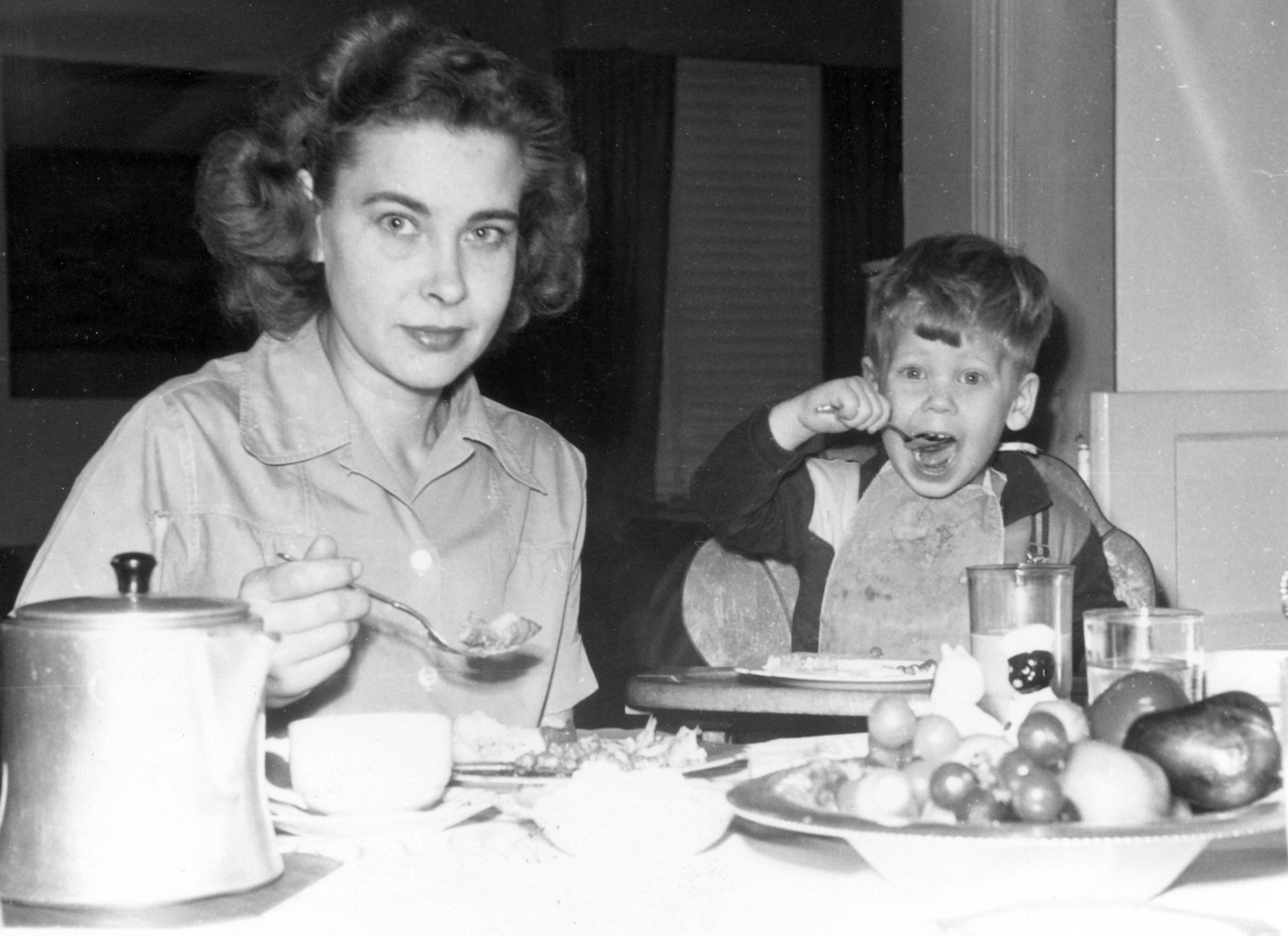
|
| Mom & Dennis Chesterbrook 1952
|
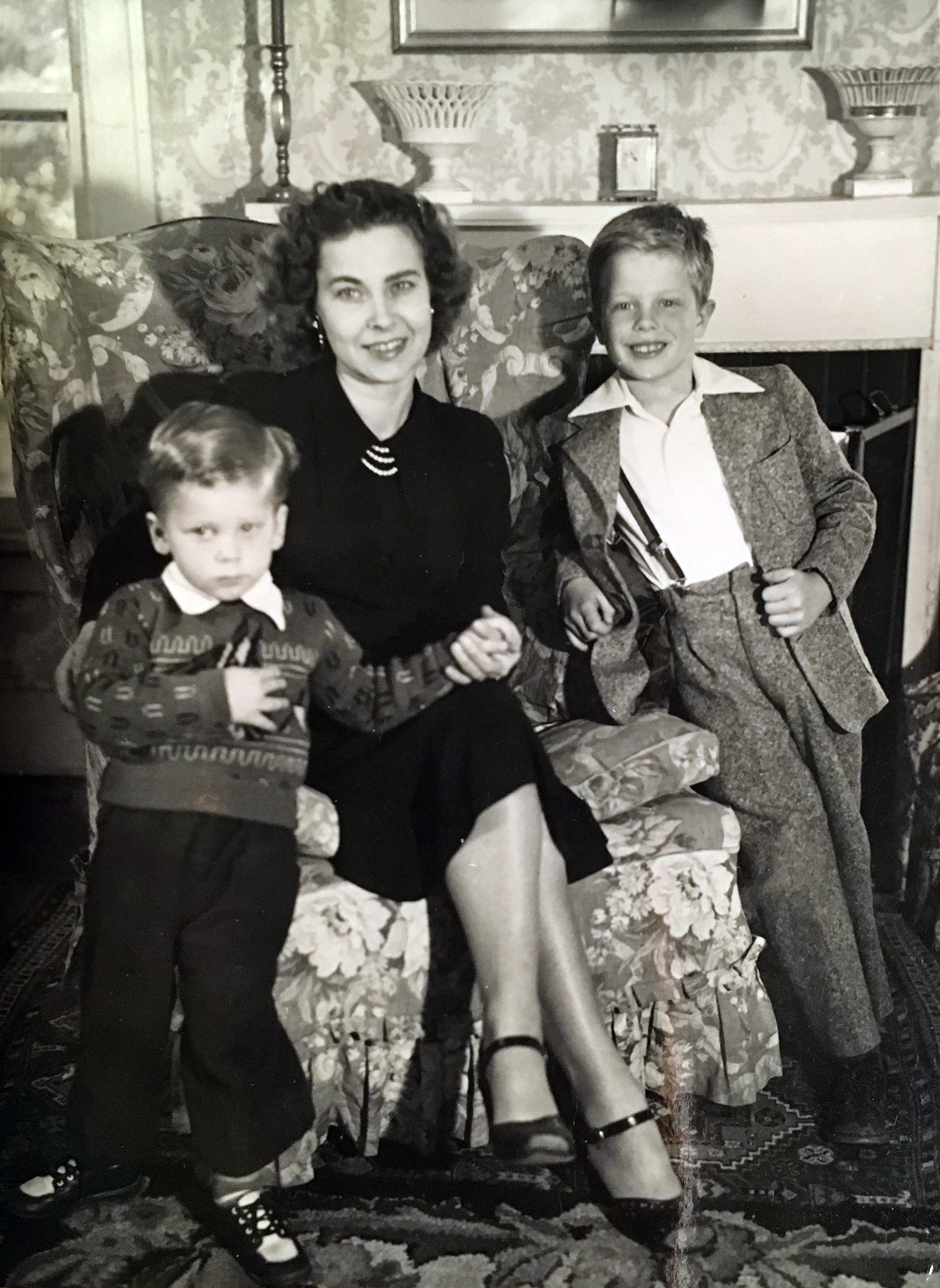
|
| At Gus's house 1952
|
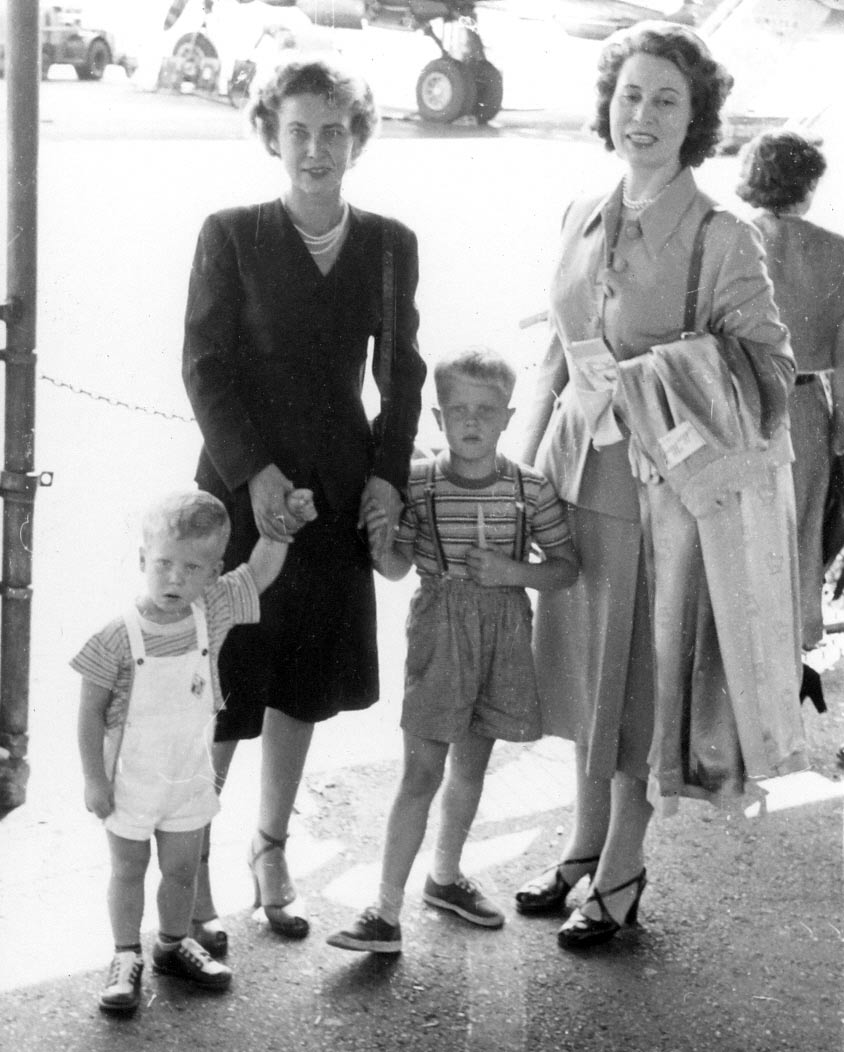
|
| With Aunt Polly 1952
|
Although I never saw dad hit my Mom (Audie, Dad's second wife, whose back he
once broke, told me that he did), he was unremittingly cruel to her,
eventually driving her to try to kill herself at least four times between
1953 and 1959. After each of these incidents (Dennis and I would come home
from school to find her unconscious from pills or in a bloody bathtub),
Dad would commit her to a mental hospital for months of shock treatments,
which — even at the time — I didn't think was right because she
wasn't crazy, just miserable. In July 2014, Jimmie Walker said:
I will fill in what I remember. Apparently, she tried using the sleeping
pills twice. Early one morning, you and Denny came over to my house and
asked if I could help you wake up your mom. You had tried pinching her,
shaking her and yelling at her to no avail. When I could not wake her, I ran
back home and woke-up my mother. She ran over and then called the
ambulance. Then I recall the time she got a razor blade, locked the bathroom
door and cut her wrists in the bathtub. Her life must have been a "living
hell" because of him. One time he physically abused me and left marks on my
chest and stomach. My dad marched next door and rang the door bell. When
your dad opened his front door, my dad said "Frank, if you ever, ever, touch
my son again, I will mop up this sidewalk with your bodily remains!" He
could have done it, too, because I've heard stories about how my dad beat-up
six guys at once inside of Coppicks Bar in Vienna.
Six months after writing that, Jimmie was dead.
Frankfurt, Germany, 1959-61
As described in the
Frankfurt chapter, Dad was
sent to work in Frankfurt for a few years in 1959, bringing Mom, Dennis,
and me along. We lived in a German apartment for a few months and then
moved to Army housing.
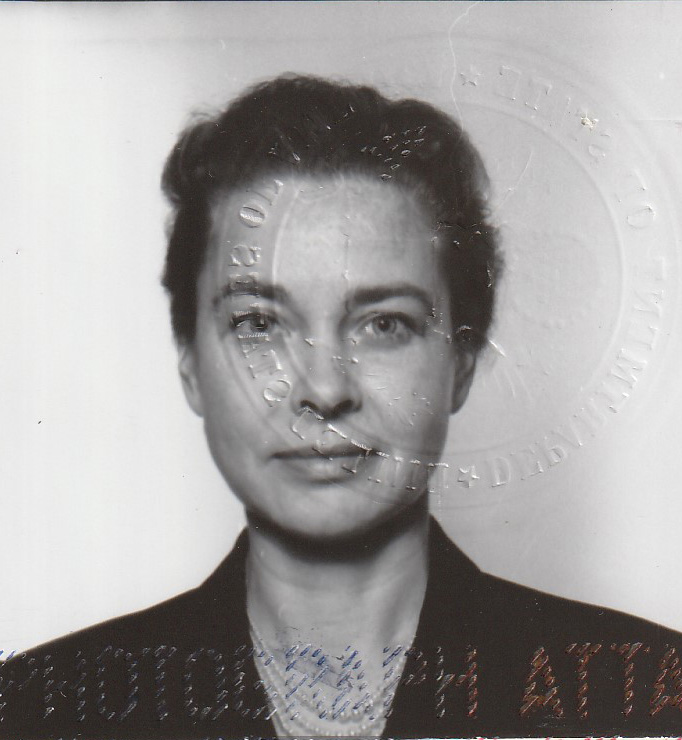
|
| Mom passport photo 1961
|
Mom tried to kill herself again shortly after we arrived. Looking through
one of dad's albums I find this comment:
One night in Frankfurt, about July 1959, the whole gang decided to attend
the "Merry Widow" ... Henri was in Paris translating for Eisenhower (when
Krushchev chewed him out) and my spouse was in the rubber room at the 97th
General Hospital. So I escorted Betty.
Nice guy. Anyway as a result of being strapped down and electrocuted so
many times over so many years, and who-knows-what mind-numbing drugs, there
was very little left. She had no emotions, no opinions, no engagement,
no curiosity, she just went through the motions of living. The only thing
that kept her going was her secret plan to escape, and finally she did it,
but both she and Dennis were wrecked for life by that monster. I don't say
that because Dennis was gay, even though that might well have had something
to do with my dad's bedtime romps with him every night when he was a child,
but he couldn't function in life; he couldn't graduate from high school, he
couldn't earn a living as a musician no matter how talented he was, and he
just bounced around from one situation to another where somebody else took
care of him. And if you think about how my mom was when we went to visit
her, she never really had anything to say. Once she was free of dad, the
pressure was off but she was empty. If you asked her how she was doing,
she'd say "Everything is wonderful!". And it was.
But what I didn't know was that she had been truly happy in the hospital.
She had long breaks from Dad and she made good, deep friends there. One day
some of her hospital friends paid her a surprise visit when I was home (and
dad wasn't). Suddenly she was a person I had never seen before: lively,
laughing, joking, saying outrageous things. It was the only time I ever saw
her so lively and animated; I imagine that's how she was in high school and
the Navy.
In later life I wondered why Dad turned so mean and brutal, especially since
his mother and father were good people, and his brother was a charming,
easygoing guy. According to Audrey, when he got Mom pregnant he had no
intention of marrying her, but was ordered to by his CO, a random event
to which all of us owe our existence. Audie says that's why he hated Mom so
much, that she "trapped" him, condemning him to the life of a poor working
stiff with no chance of becoming a big shot.
In 1976 my brother Dennis told me that that dad had told him
that he was one of the unwitting subjects in the CIA's experiments with
mind-altering drugs (Project MKultra) in the early 1950s. All I know is
that he was angry and full of hate until about his 70th year when he calmed
down a bit, but he had abused his own body so badly and for so long that he
would only live another couple years.
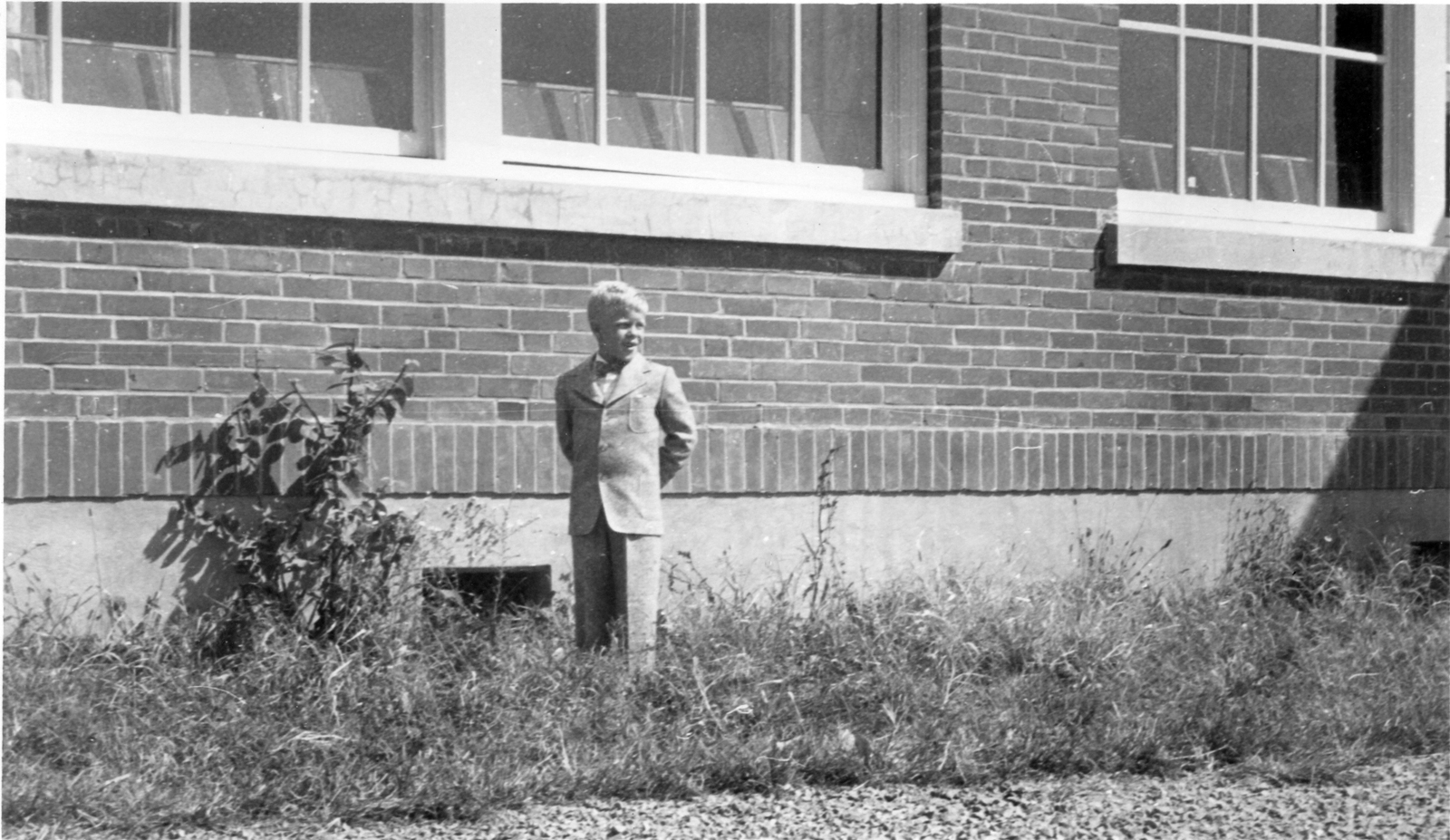
|
| Me at Mom's hospital, mid-1950s
|
I've never had analysis or psychotherapy, but I do try to
figure stuff out. Is there some part of me that resents my mom for trying
to abandon us so many times? I don't think so but I do know that every time
she disappeared into the mental hospital for a month or two and we only had
dad around, it was pretty frightening. Dennis and I both believed he could
kill us at any moment. I had nightmares for decades about that, even when
we lived on 118th Street (I was in my 30s and 40s).
Trip to Norway, 1960
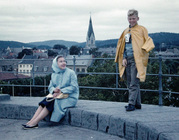
|
|
Mom and Dennis in Norway 1960
|
As noted in
another chapter, in the summer of
1960 while we were living in Germany, my dad took us all on an epic road
trip that included Northern Germany, Norway, Sweden, and Denmark. Despite
his cruelty towards my mother, he wanted to fulfill her dream of seeing her
ancestral homeland; she had a storehouse of Norwegian lore and she told us
many stories of the Norwegian countryside when we were children that were
passed down from her grandparents, all of whom emigrated from Norway. But
she had no idea where her family had lived. Anyway we covered a lot of
ground and she was able to experience many aspects of the country thanks to
my dad, for which he deserves credit.
Long Beach, California, 1963-80
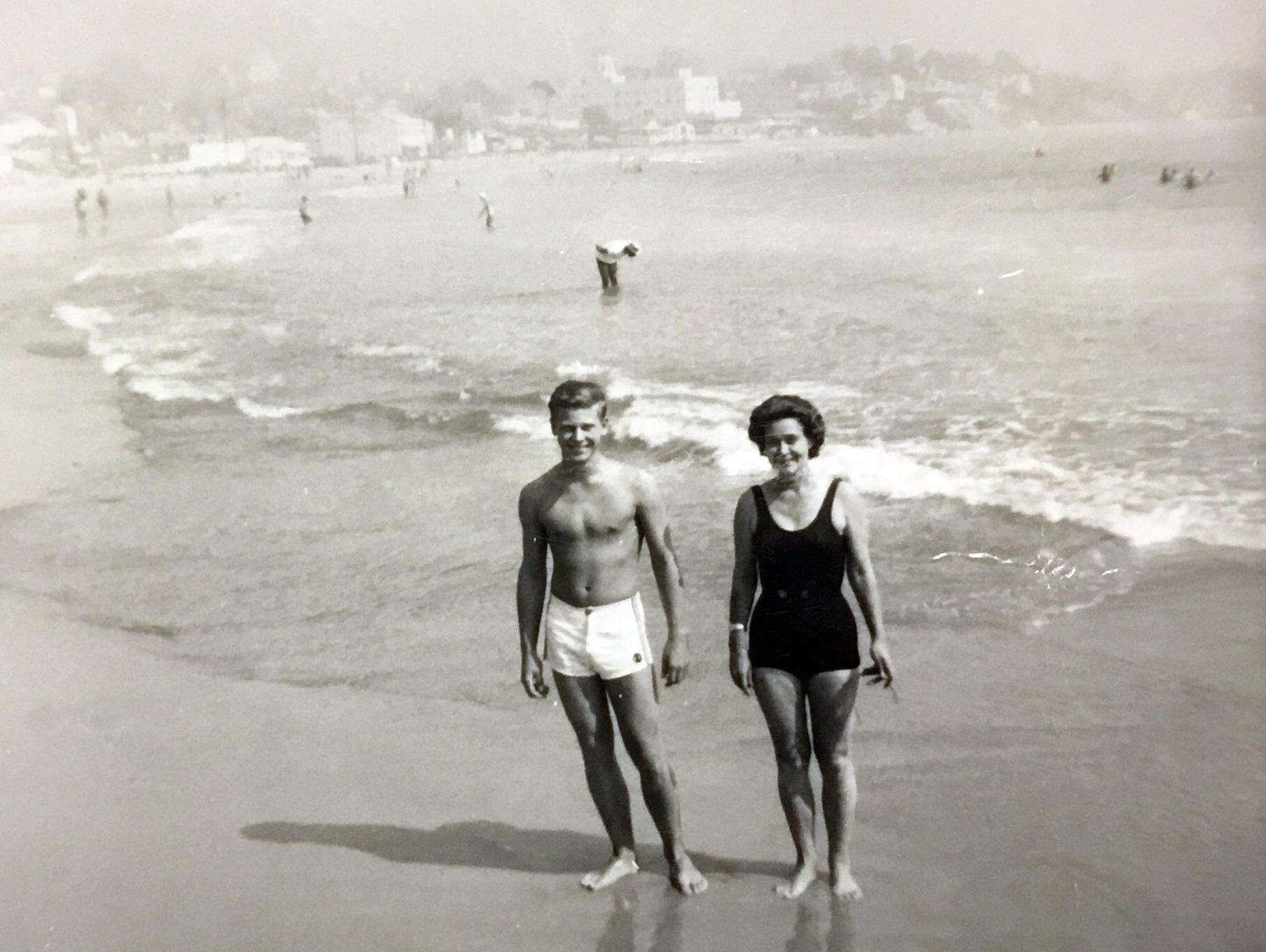
|
Free at last! Dennis and Mom
in Long Beach, 1963
|
Soon after I joined the Army 1963, one day while my dad was at work my mom
took Dennis and flew to California (Dad said she cleaned out the joint bank
account, Frank Rider said there was no joint bank account and she had been
saving pocket change for years until she had enough). In her quiet way, she
freed herself and Dennis from his brutal domination and she put 3000 miles
between them. From there she obtained a divorce, and probably got some
restraining orders too. At first she stayed with brother Zeke and his wife
Sally and daughters Sandy and Mary in Anaheim.
In late 2018, Cousin Sandy sent me a six-page typed letter Dad sent to Mom
in August 1963, shortly after she left him. It's threatening, sarcastic,
cruel, and — given the degree to which he had abused her for so long
— delusional. As though he is the aggrieved party, not Mom. It
confirms my impression that the reason he hated her so much is that starting
around 1952 or -53 she "denied [him his] marital rights" for reasons I can
only imagine; this leaves open the frightening question of whether he forced
himself on her after (or before) that. He describes his marriage to "an
impractical and ignorant woman" (and elswhere, "emasculatory") as "nineteen
years of almost unremitting horror", even though the horror was all Mom's,
Dennis's, and mine. He refers to her "appetite for gin and tranquilizers",
which is news to me... and this from a man who was drinking two
fifths of gin each evening by himself. He describes his ideal woman as
one "free of small-town inhibitions" and "who has come to realize that a man
is man and a woman is a woman; that they are not equal and never will be;
that one leads and the other follows; that
that is why she was born and
fashioned as she is." He ends on a semi-conciliatory note: "I must say in
all truth that I write this in some sorrow. In spite of the fact that we
got off to a shaky start [i.e. that he was ordered to marry her by
his Navy CO], you were a beautiful and devoted girl, nubile and all a man
could ask for. A wonderful mother, too. But somewhere along the line you
got off track and never quite succeeded in getting back on."
After staying with Zeke, Mom got an apartment in Long Beach and went to the
Career Training Institute there (and perhaps also Long Beach Business
College) to become a medical stenographer and secretary, and then was the
office manager of an orthopaedic practice for 10 or 15 years.
The photos above were taken shortly after Mom arrived in California in 1963.
At first she had a small apartment (first photo) with Dennis. Some of her
brothers and sisters lived in the area, and they appear in the next four
photos. The second photo is Mom with Polly's husband Harold Blanchette.
The third is Mom with Zeke's wife Sally. The fourth photo is of Ella, Mom,
Zeke and Zeke's daughters Mary and Sandy, and fifth is Pug with his wife
Ruth.
In the building where she lived she met Frank Rider, a divorcée who worked
as a legal aide; his strategy for meeting women was to spend a lot of time
in the laundry room, which is how they met. He looked like Dean Martin with
blond hair. Frank was too young to have been in the War, ten years younger
than my mother; he worked in a defense plant as a teenager, zooming around
on his bicycle delivering stuff between the buildings. I think it was a
shipyard in or around Vancouver WA where they built Liberty ships.
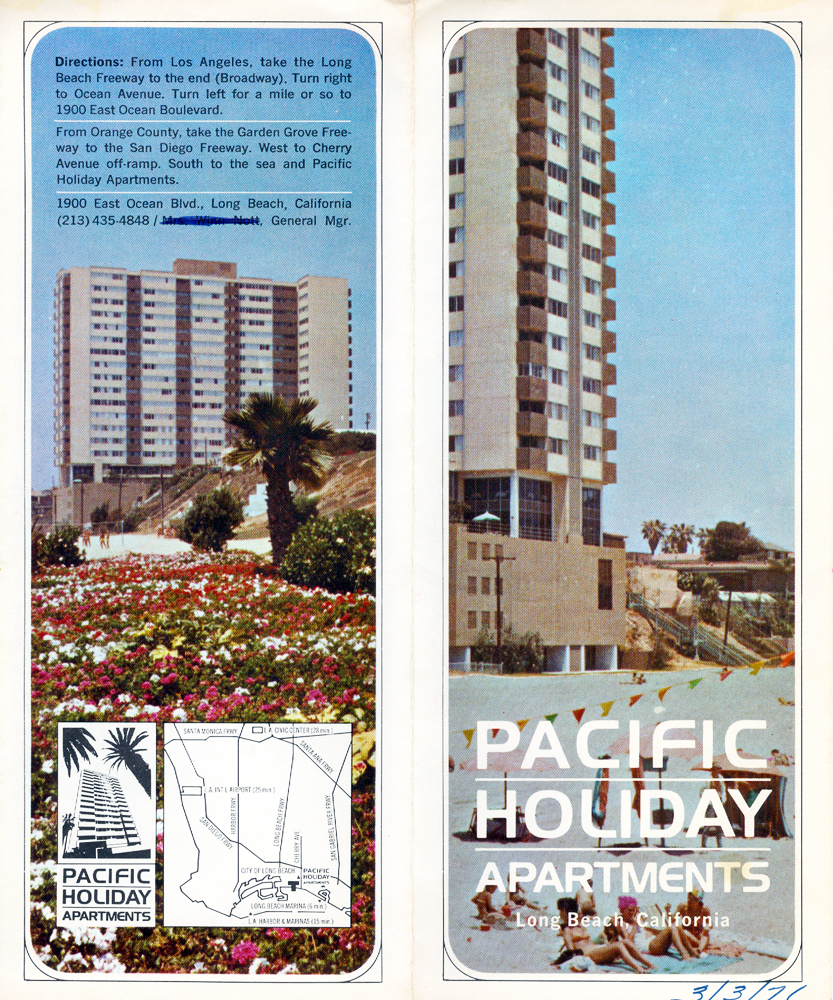
|
| Apartment in Long Beach
|
They decided to live together and rented a large and luxurious apartment on
a high floor of a high-rise right on the beach, with a big picture window
and a balcony overlooking the beach and the ocean. Mommy and I visited them
there both before and after you guys were born.
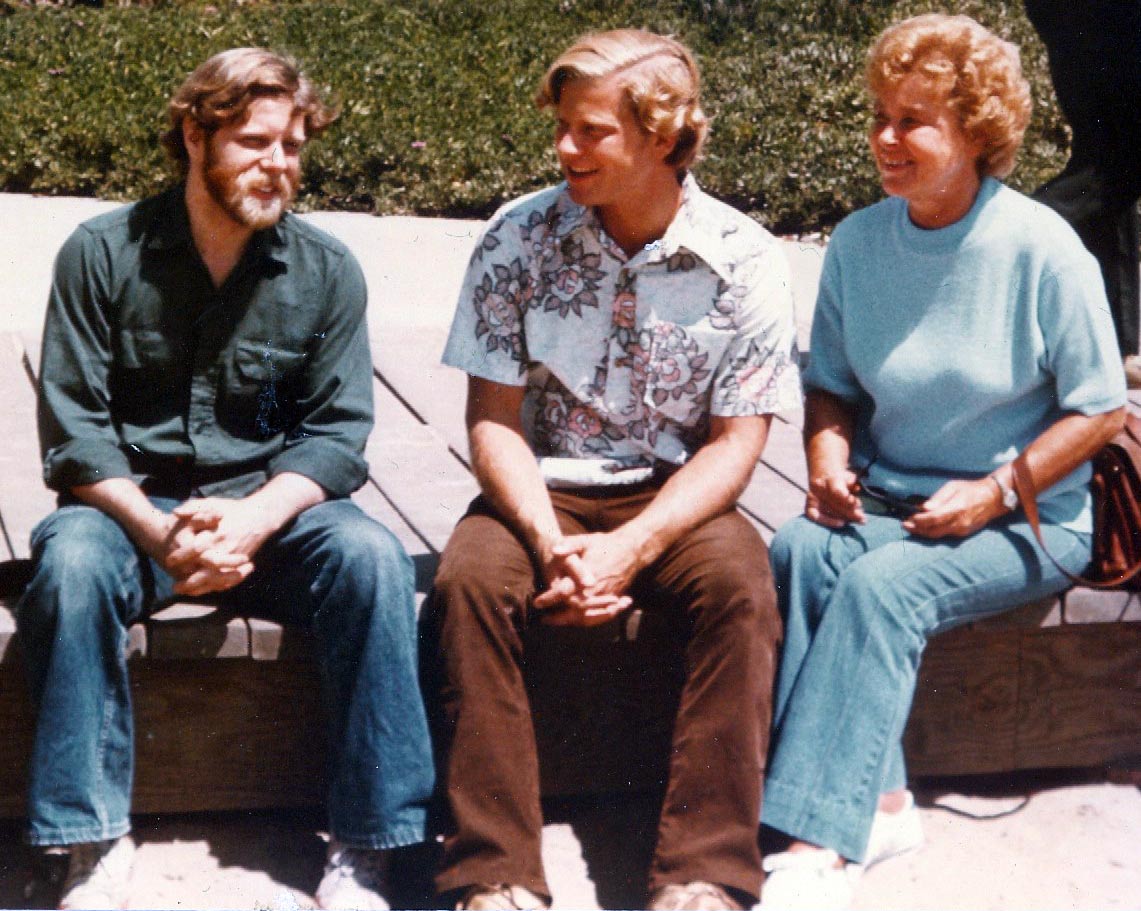
|
| At Laguna Beach 1976
|
I got out of the Army in 1966 but it was 10 more years before I saw my
mother. In 1976 after Judy and I got married we went to see Mom and Frank
Rider in Long Beach. They met us at the airport and Mom gave me such a huge
hug, I never knew she had so much strength. That was the closest she ever
came to expressing her feelings with me in person (after we got back, she
wrote "I can't tell you both how much your visit meant to me, and to Dennis.
It was one of the happiest times of my life. I have played the tapes [of
Dennis and me making some music together] over and over, hope they don't
wear out. I think you two are a great combination. I love my
daughter-in-law, and I am very excited about being grandmother" [Judy's
unsuccessful first pregnancy].) As you can see, she and Judy got along
great and Judy and Dennis were also crazy about each other. Frank Rider
rubbed Mommie the wrong way at first because he kept making little jibes
about New York City, but as the years went by I think we all adjusted to
each other pretty well.
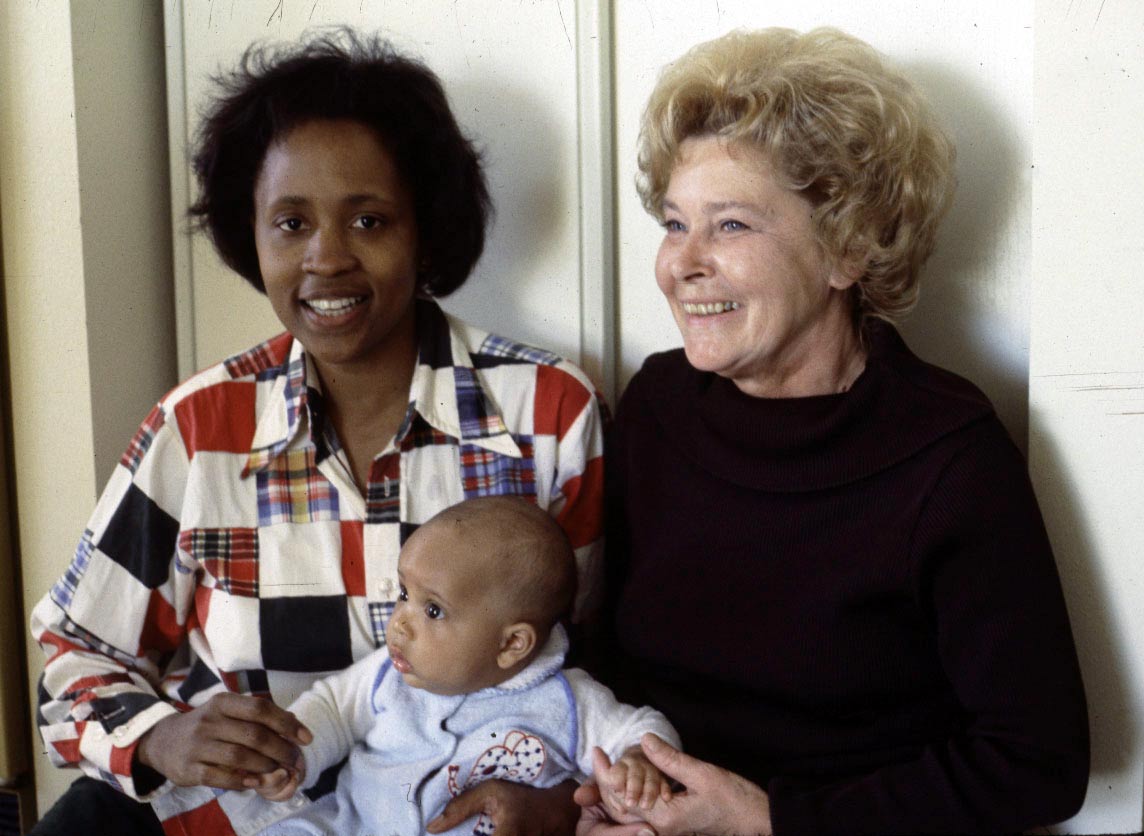
|
| Judy, Peter, and my Mom in 1978
|
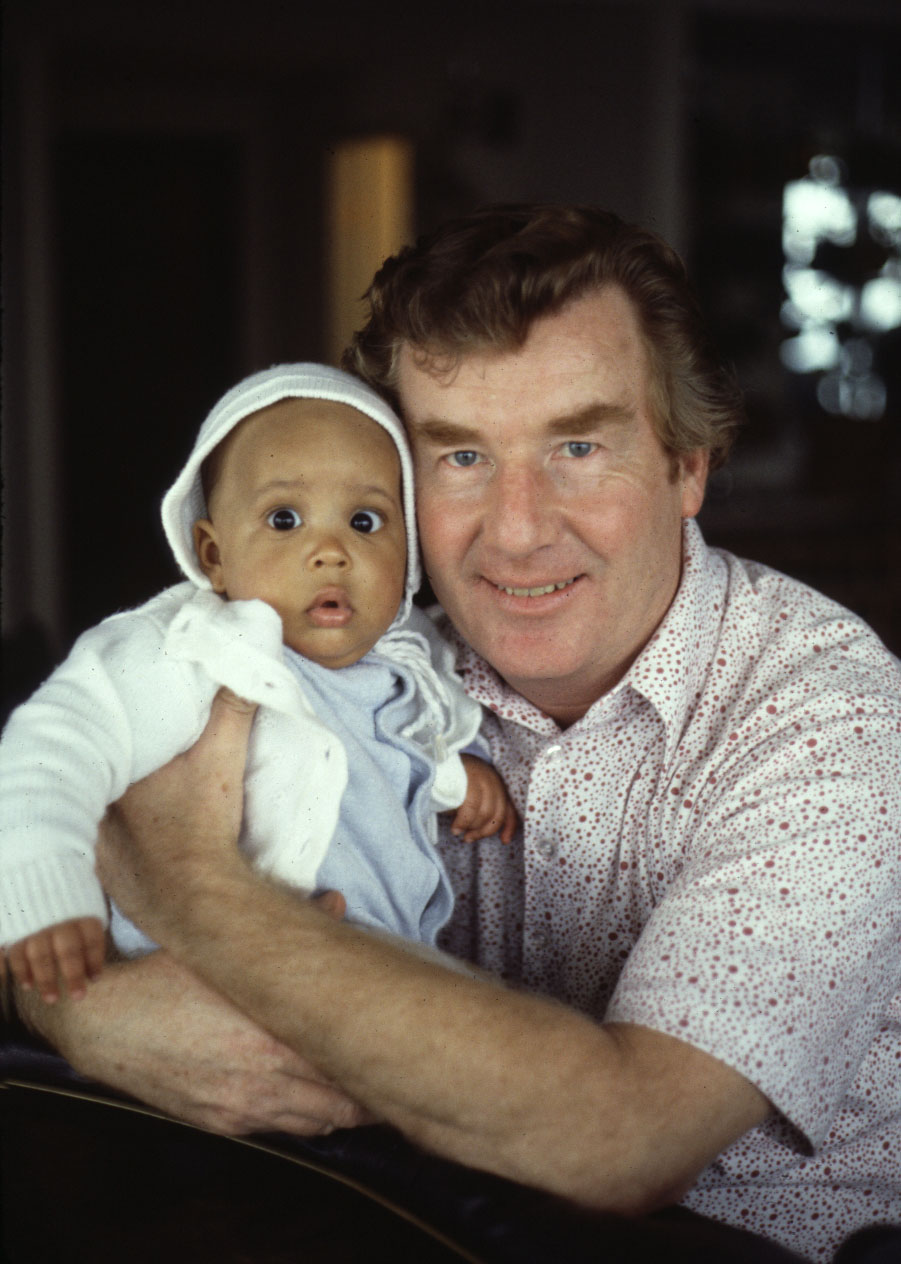
|
| Frank Rider & Peter
|

|
| Mom in 1978
|
On that first trip, Dennis picked us up in his 1959 Cadillac, possibly the
biggest car ever made, and with the biggest fins. It was kind of a wreck
but he was proud of it. He drove us all over southern California
including San Diego, San Simeon, and Laguna Beach where Mom found a shop
that sold a kind of Norwegian flatbread called lefse she used to have as a
kid. When we got to her house she made it for us; you have steam it or
something until it becomes flexible and spongy (kind of like injera,
Ethiopian bread, but chewier) and that you can roll stuff up in it.
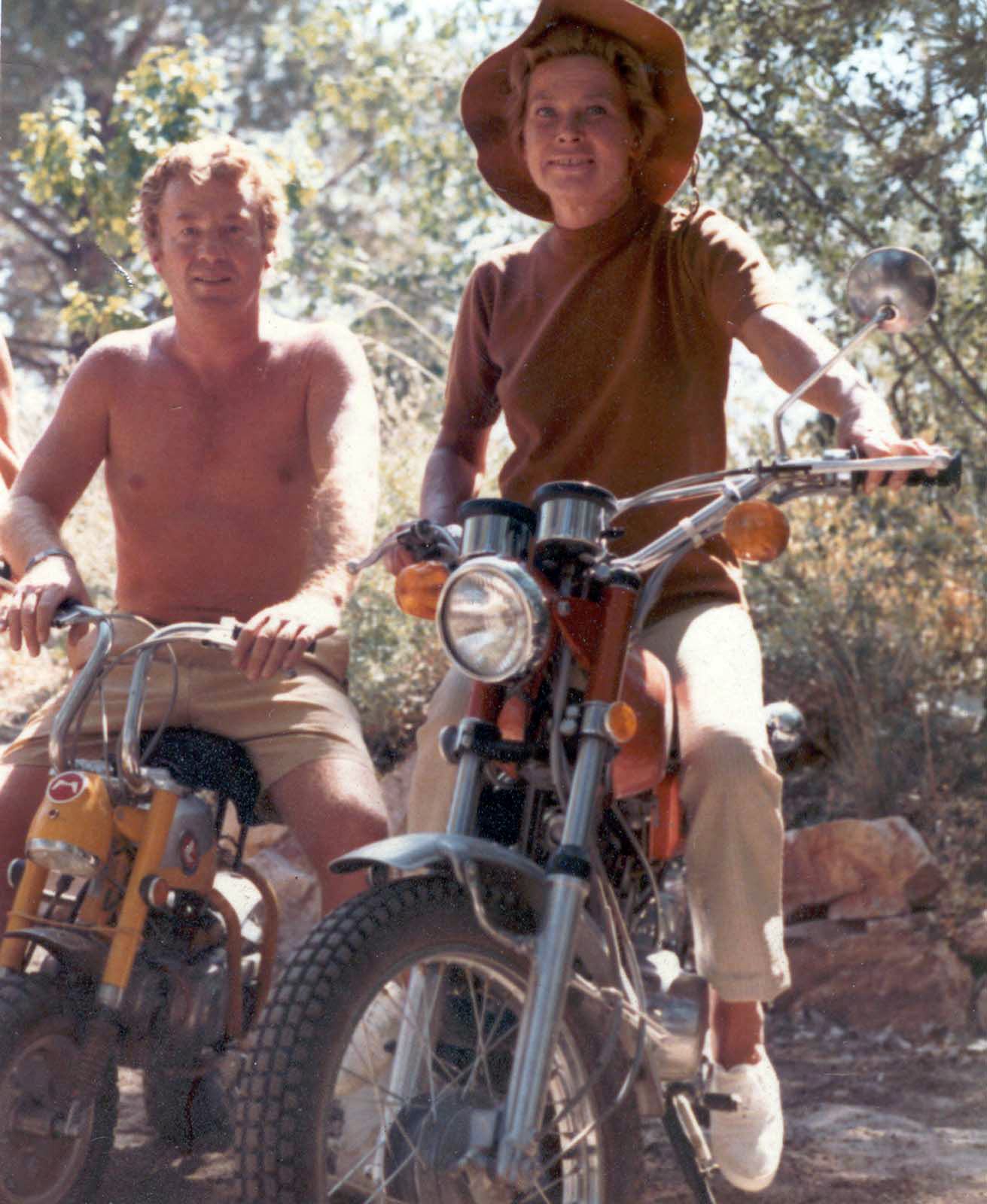
|
| Frank Rider and Mom
|
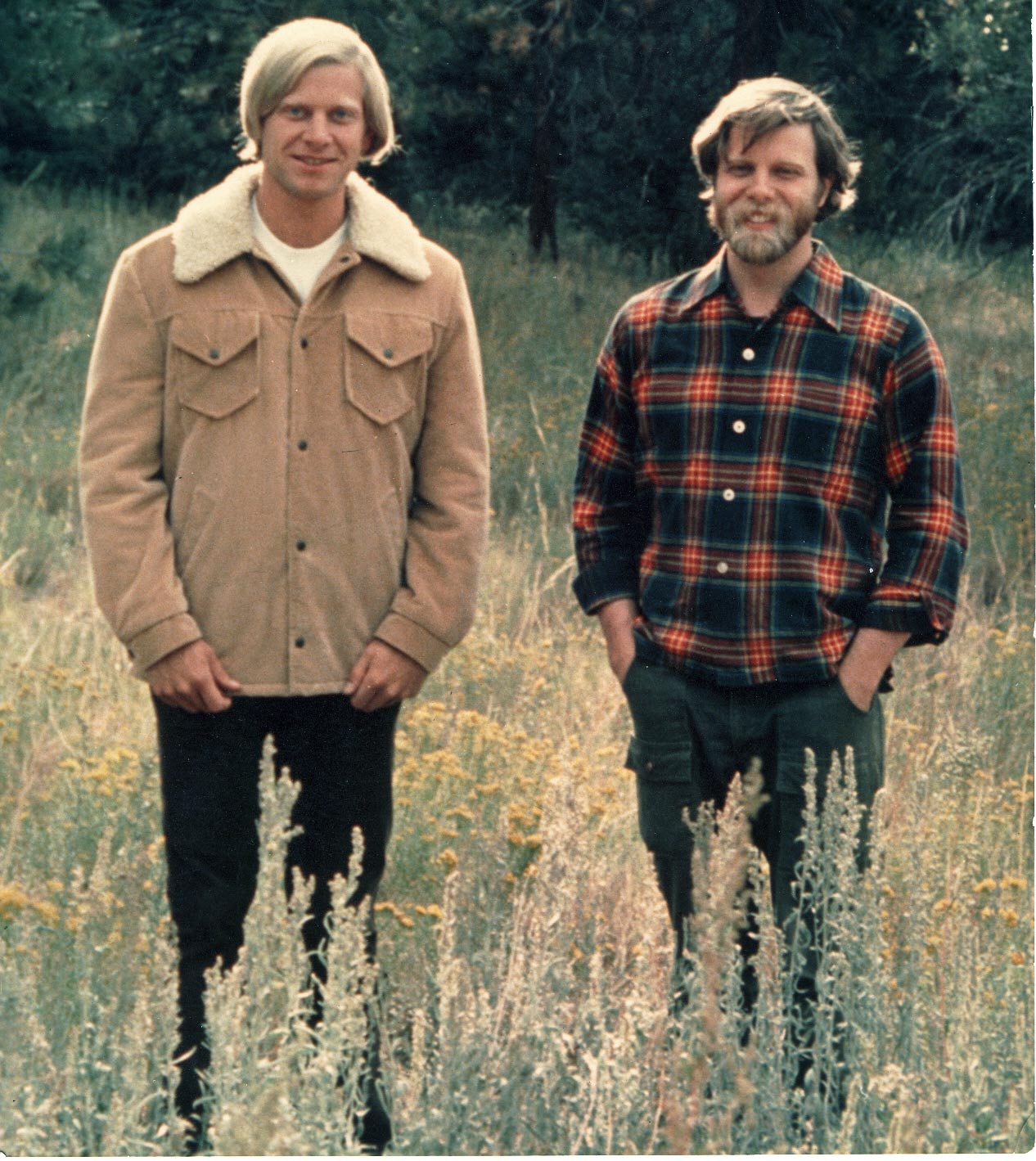
|
| Dennis and me 1976
|

|
| Dennis and me in Big Bear 1976
|
By 1976, Mom and Frank had also rented or bought a small cabin in Big Bear
in the San Bernardino mountains near Big Bear Lake and we went there too on
this same trip. We'd go for long walks up the mountain...
the air was pretty thin, it was at 10,000 feet. I fixed Frank's putt-putt
motorcycle that hadn't worked in years and took Dennis for a ride around the
lake, about 10 miles. He didn't want to drive it himself because he had had
a serious and traumatizing motorcycle accident at some point (I don't
remember the details) but he trusted me to drive.
Death of Dennis, 1978
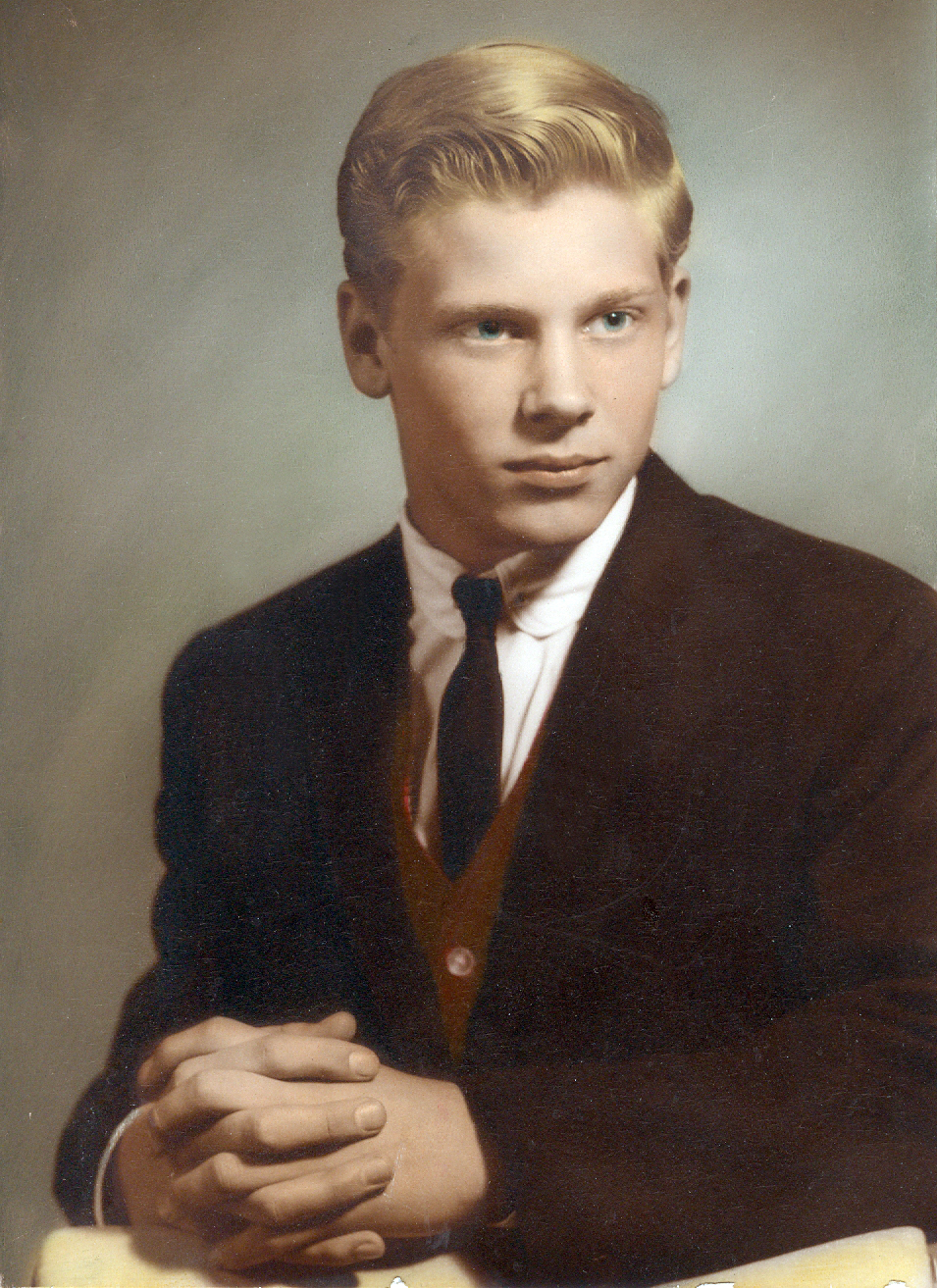
|
| Dennis 1968
|
I tell the story of Dennis's death in the
Dennis
chapter but, briefly... In early 1978, he had some strange symptoms,
saw a doctor, and it was a cancer that had metastasized all over his thorax,
every organ was involved; it was inoperable. Judy and I and 4-month-old
Peter flew to Long Beach, and found that the oncologist was optimistic and,
indeed, after two weeks of chemotherapy his cancer was in remission, but he
would need to continue chemotherapy for a long period. He hated the chemo,
the nausea, the hair falling out, and all the other side effects, so when
the cancer came back six months later he declined treatment and died at 29
years of age on his own terms. This was devastating blow for my Mom but,
always the stoic, she soldiered on for another 22 years. One consolation
for her was that she was finally a grandmother. And within 18 months, she
was a grandmother again!
Big Bear, 1980-1995
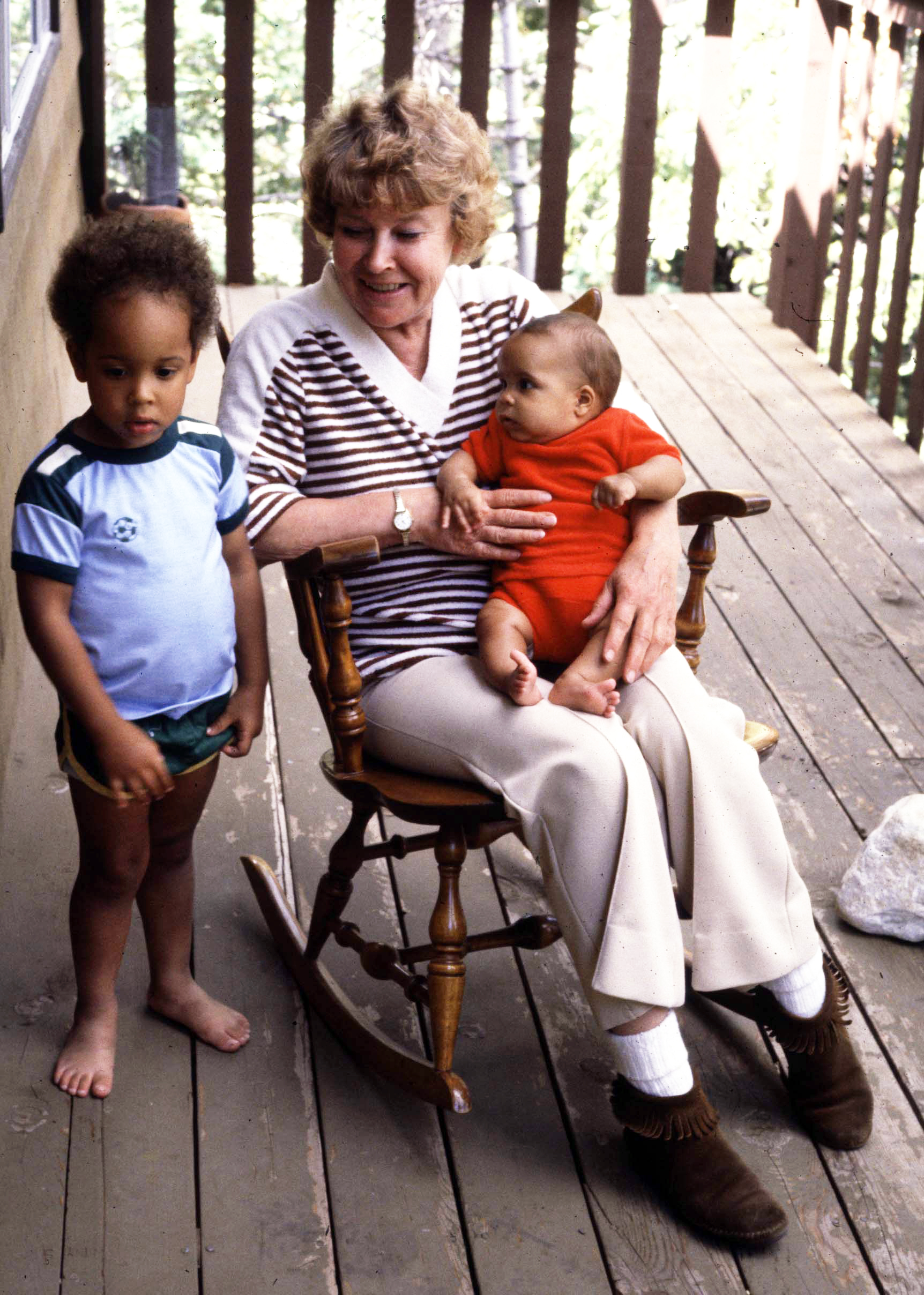
|
| Grandma Vivian Big Bear 1980
|
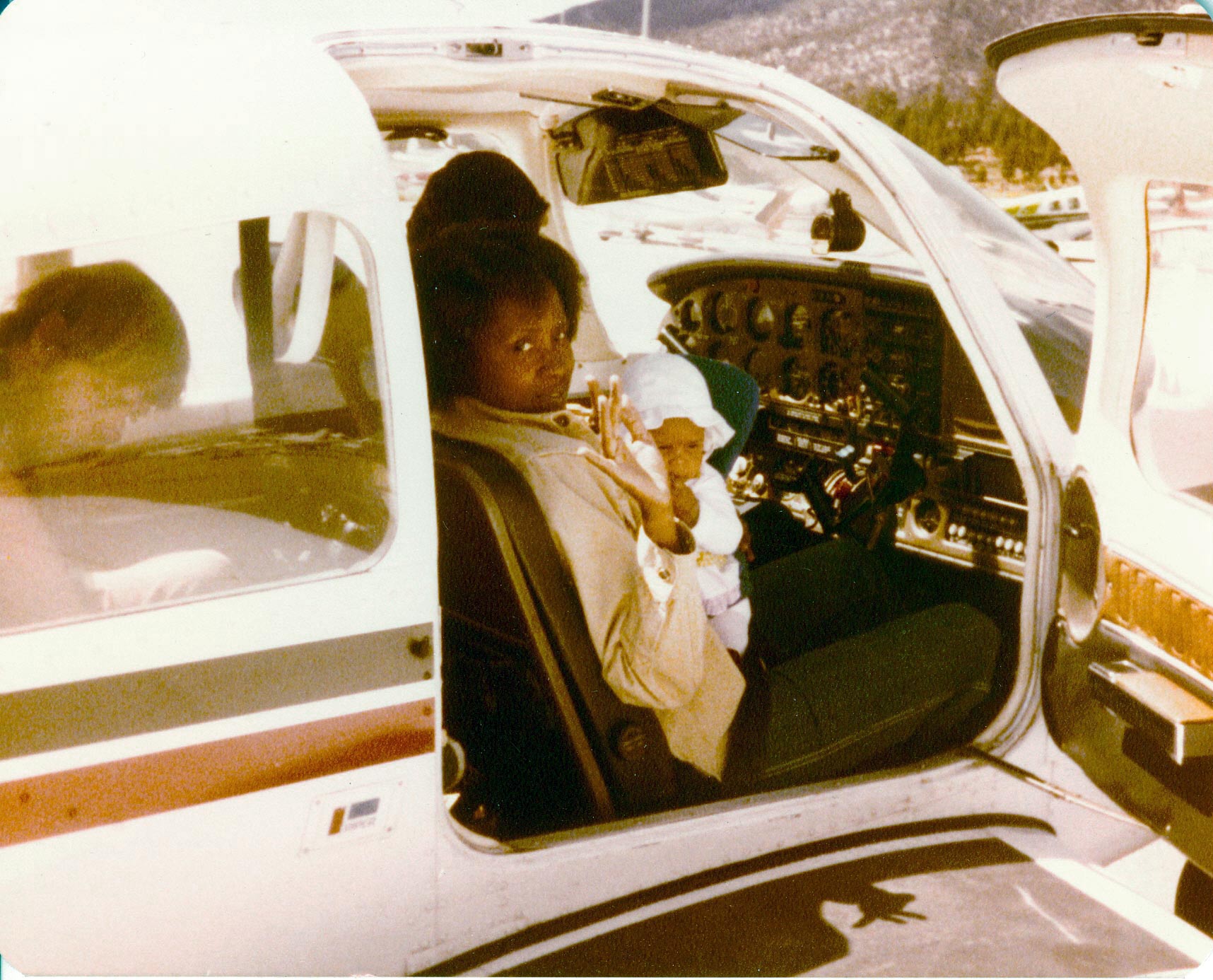
|
| Flight to Big Bear 1981
|
When Mom and Frank retired about 1980, they sold their Long Beach apartment
and moved to a much bigger cabin in Big Bear, where Mom's favorite pastime
was feeding the racoons, chipmunks, and birds. Frank made a modest living
doing real estate deals, maybe one a year. On one of our visits, Mom and
Frank hired a small plane to fly us direct from LAX to "Big Bear X", as Mom
called it. I don't know if you remember, it was quite an adventure... We
went up and up and up and then just landed without going down again. And
that's when Mom met Amy, her second grandchild. She came alive when
you guys were there.
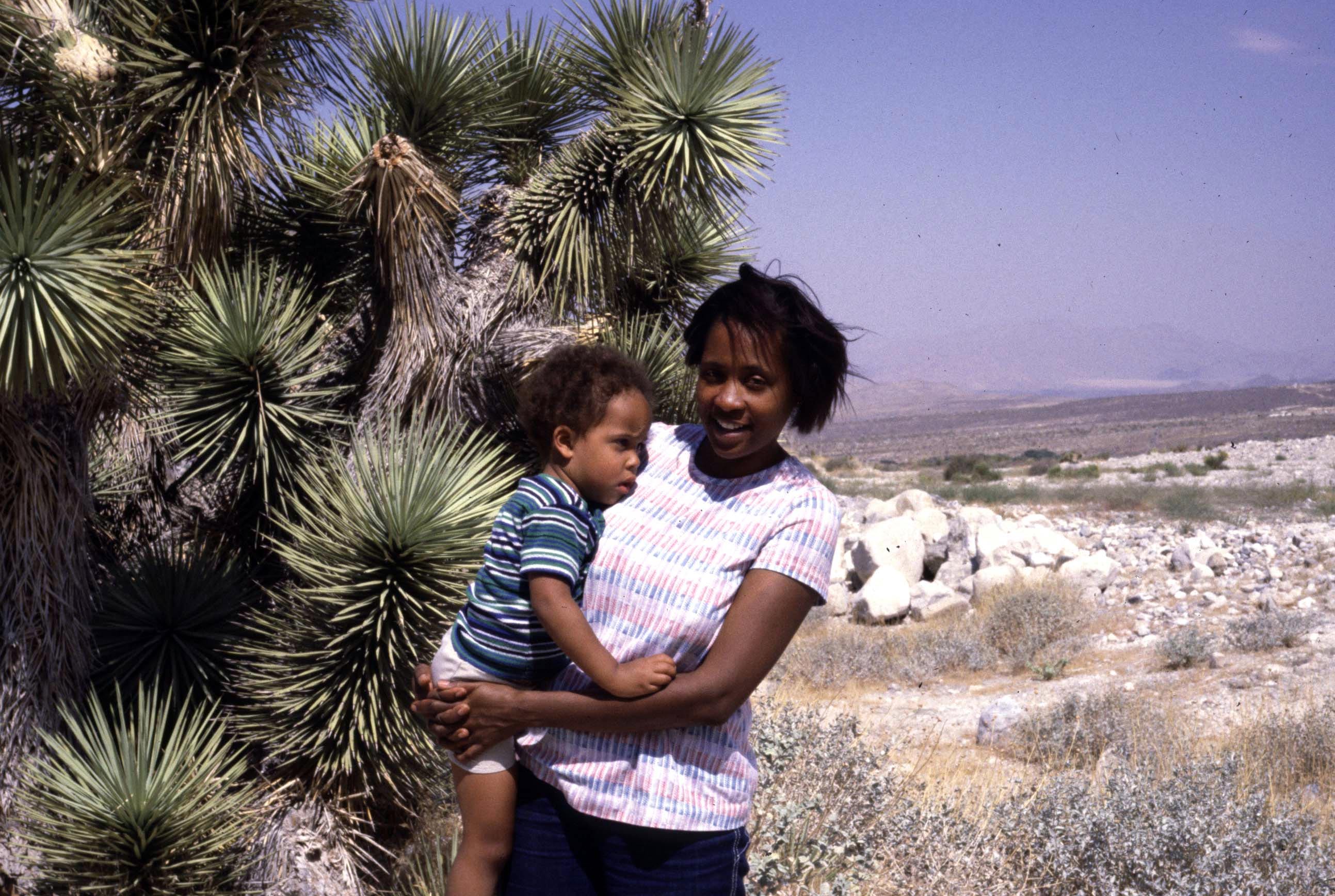
|
| Peter and Mommie in Death Valley
|
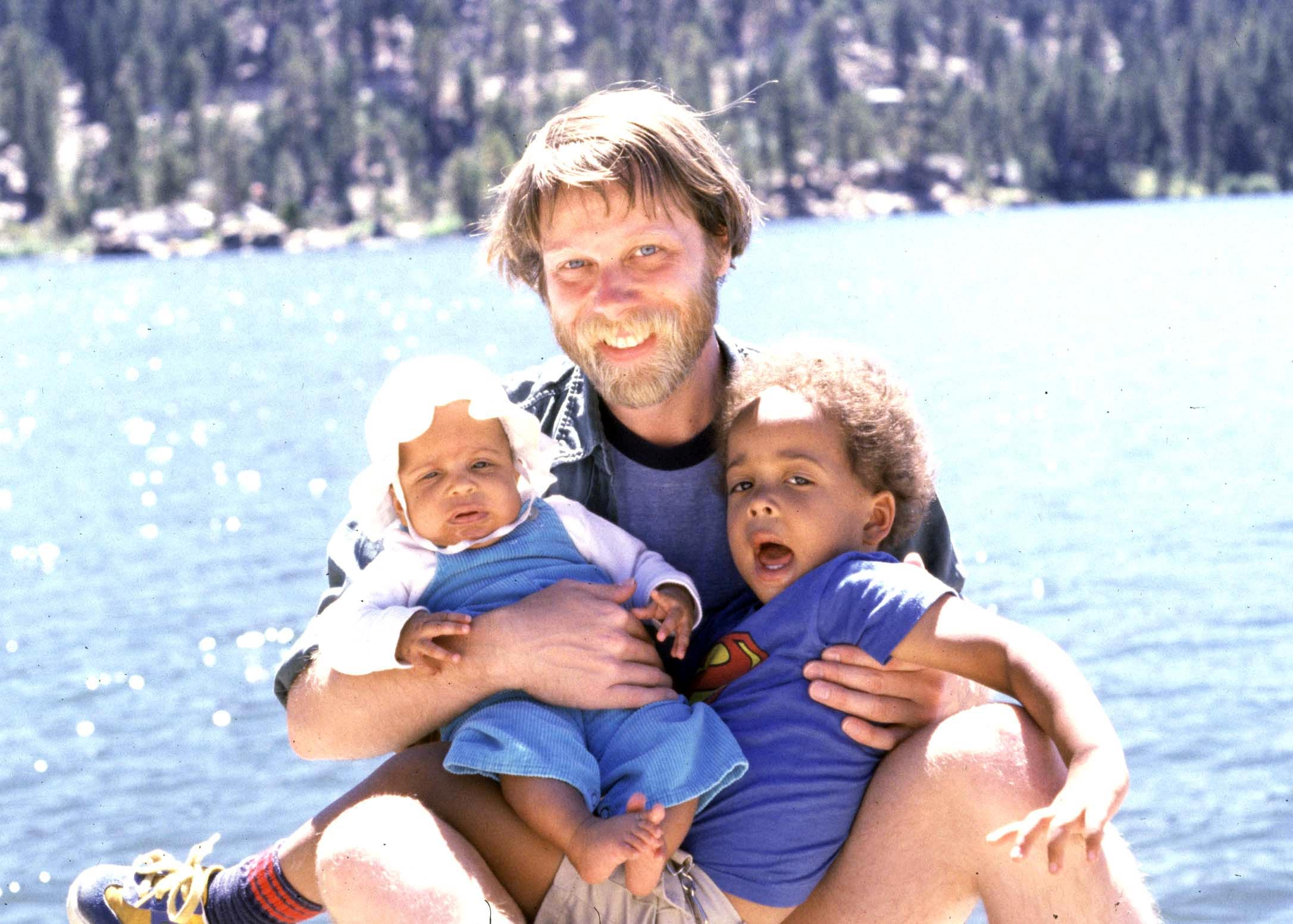
|
| At Big Bear Lake
|
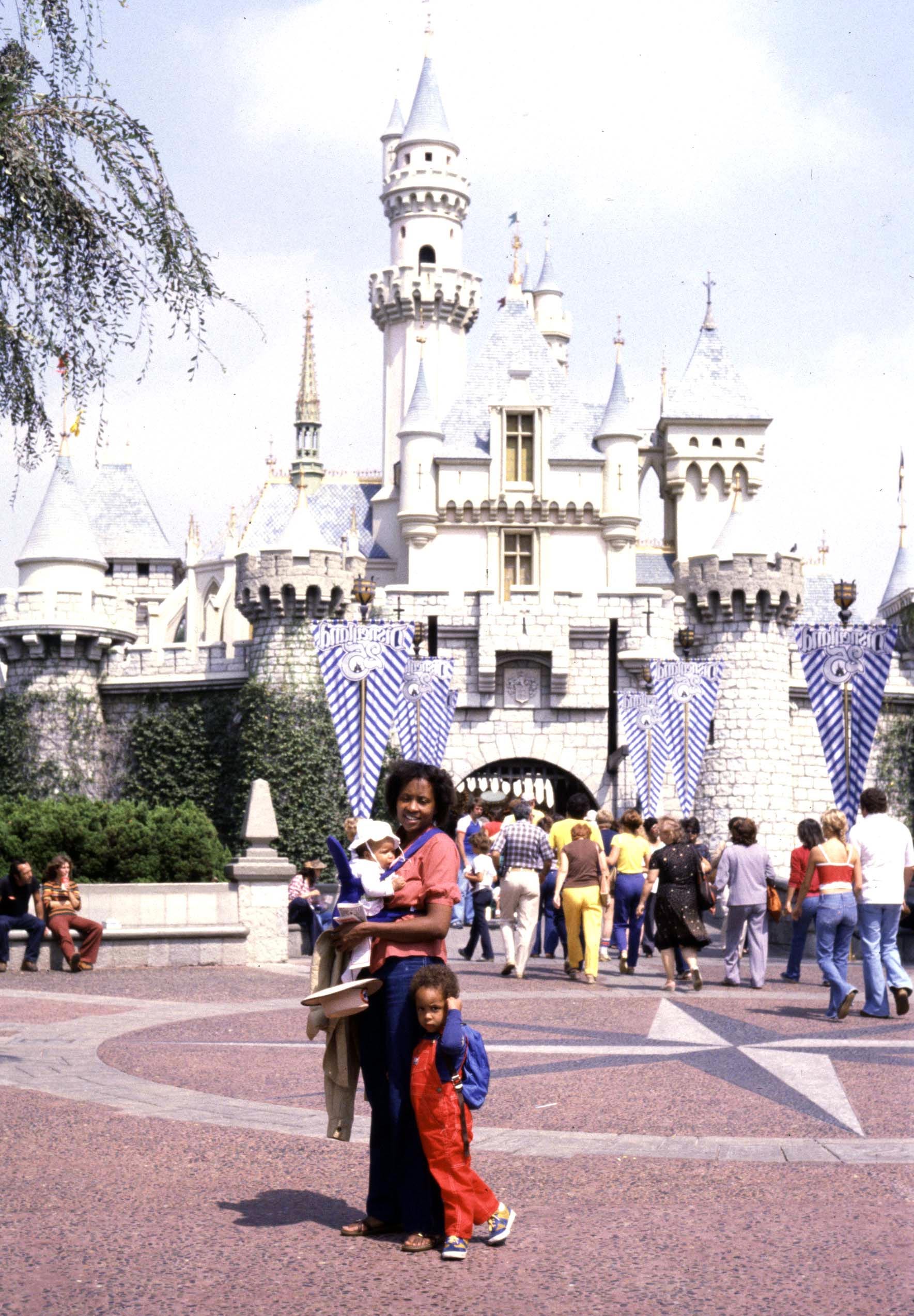
|
| Disneyland 1980
|
Another time we had to drive across Death Valley.
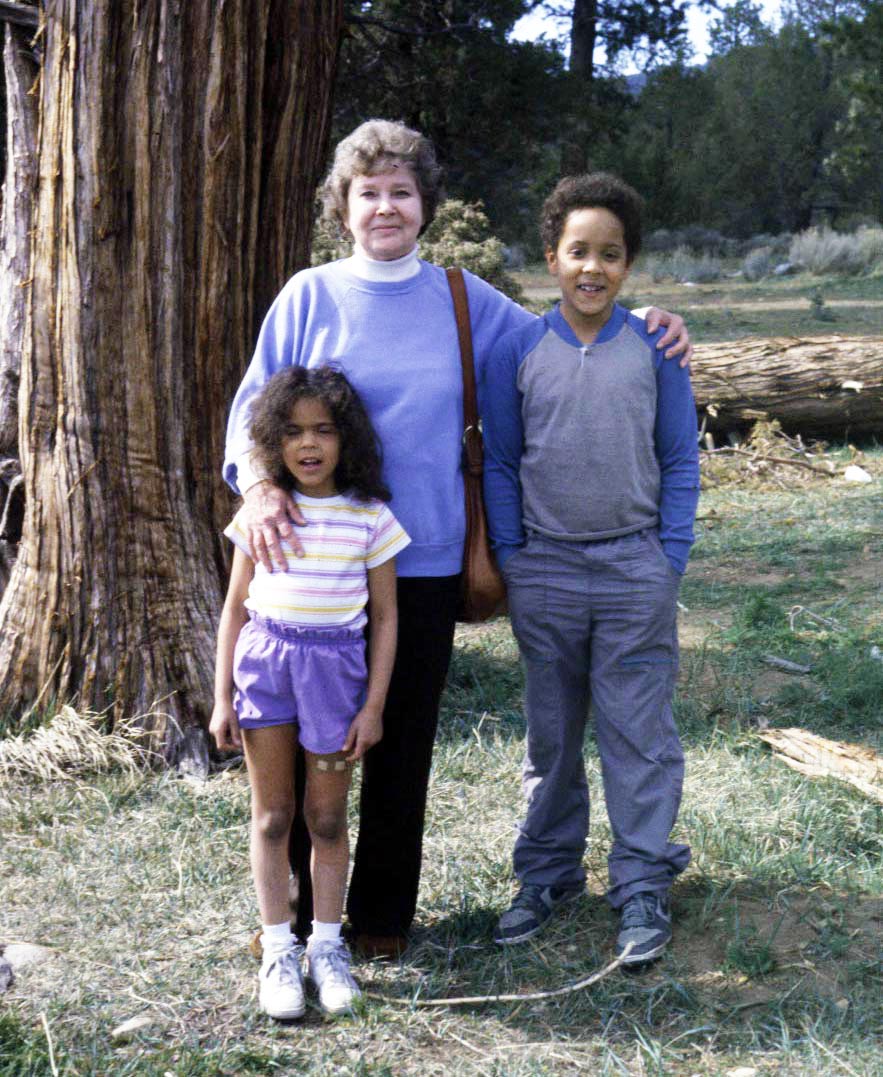
|
| At Big Bear 1986
|
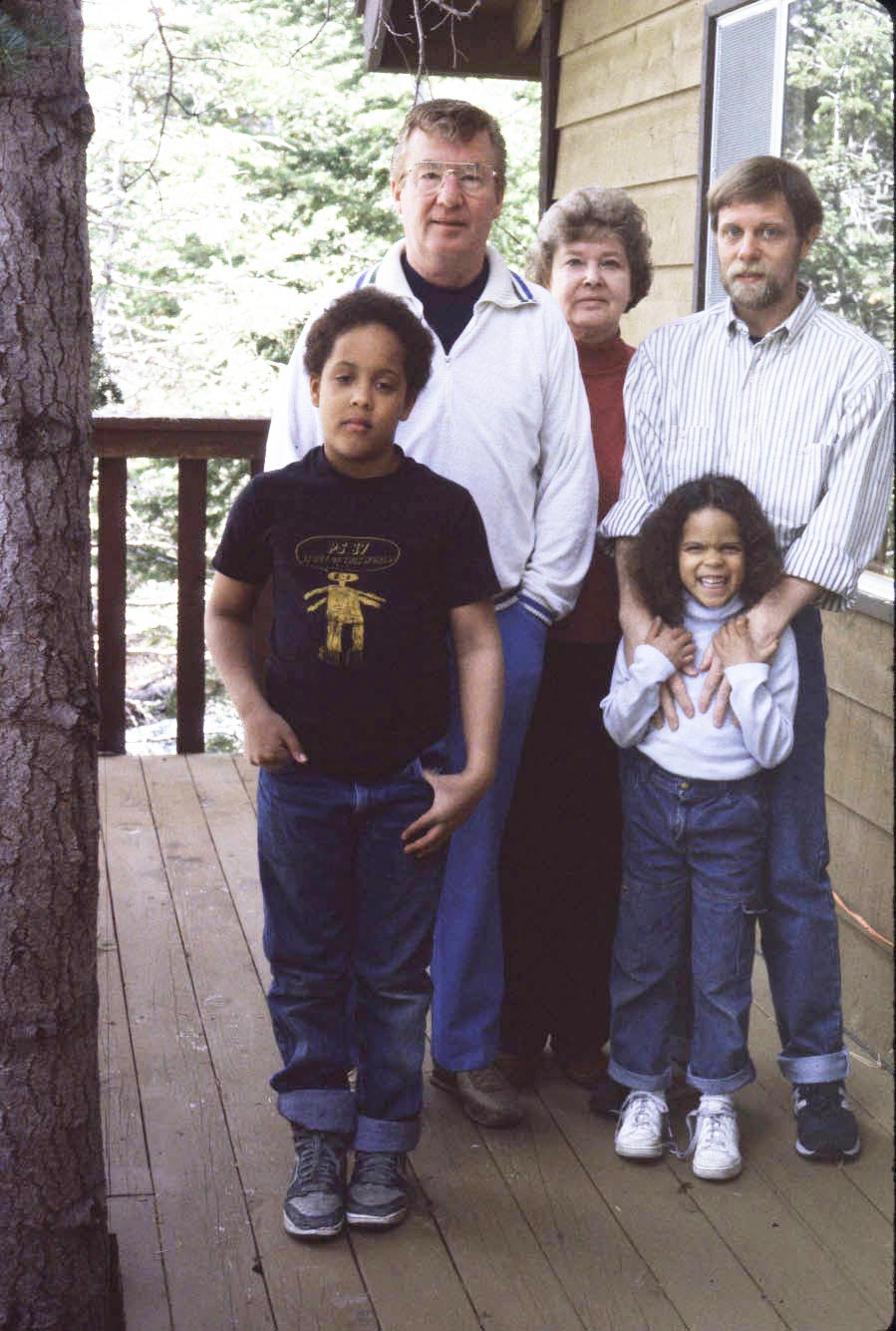
|
| At the big cabin 1986
|
We always had fun at Big Bear. Once we went to a rodeo, remember? That was
the time Peter rode on the legendary horse, Buttermilk. On that same trip,
we also went to Disneyland, where Peter and I went on Dumbo about 500 times;
it was the only thing he wanted to do, especially after that red-eyed
monster popped out in front of him in a dark tunnel on the Magic Mountain
ride!
We went again in 1986, when Amy was a sentient being, so this visit and the
one in 1990 are the ones she remembers Granma Vivian from. But on this
occasion Mom decided to bring out the family slides that my father had taken
in the 1940s and 50s and that he sent her when Dennis got sick. As we
watched them she got more and more upset and drank a lot of wine and finally
passed out. She was mortified the next day and very angry with herself for
losing control and as far as I know, she never did again.
Oregon 1990

|
| Oregon beach 1990
|
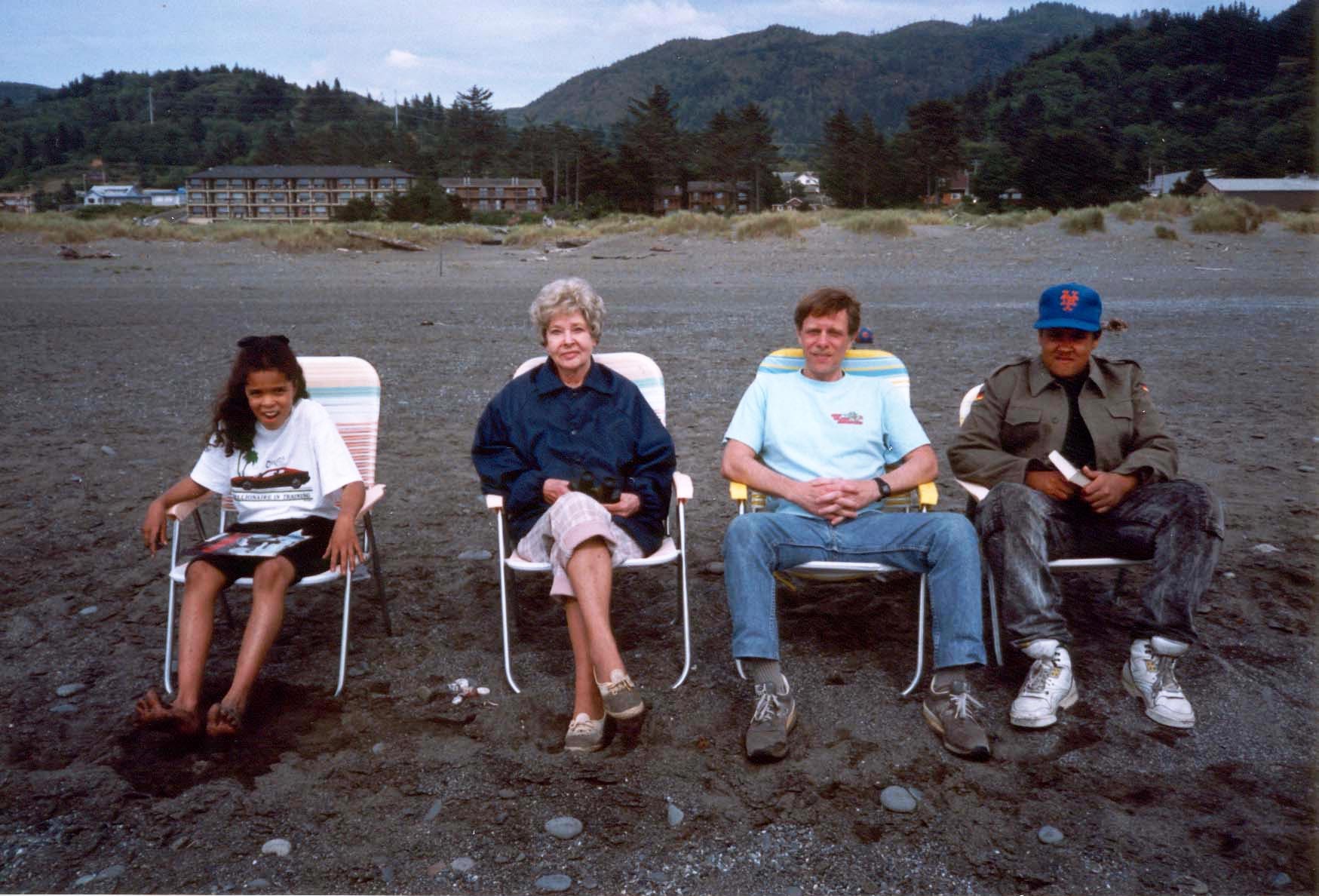
|
| Oregon beach - motel in background
|
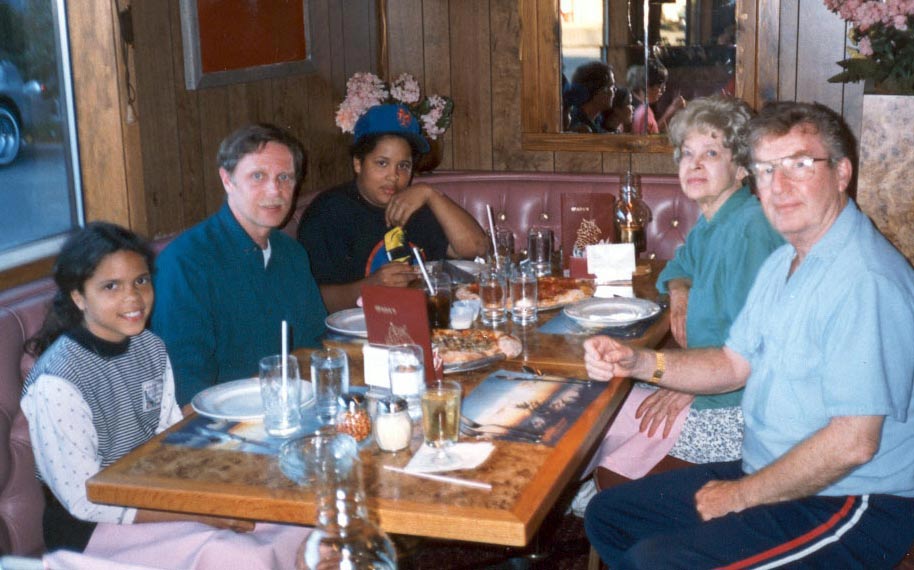
|
| Oregon diner 1990
|
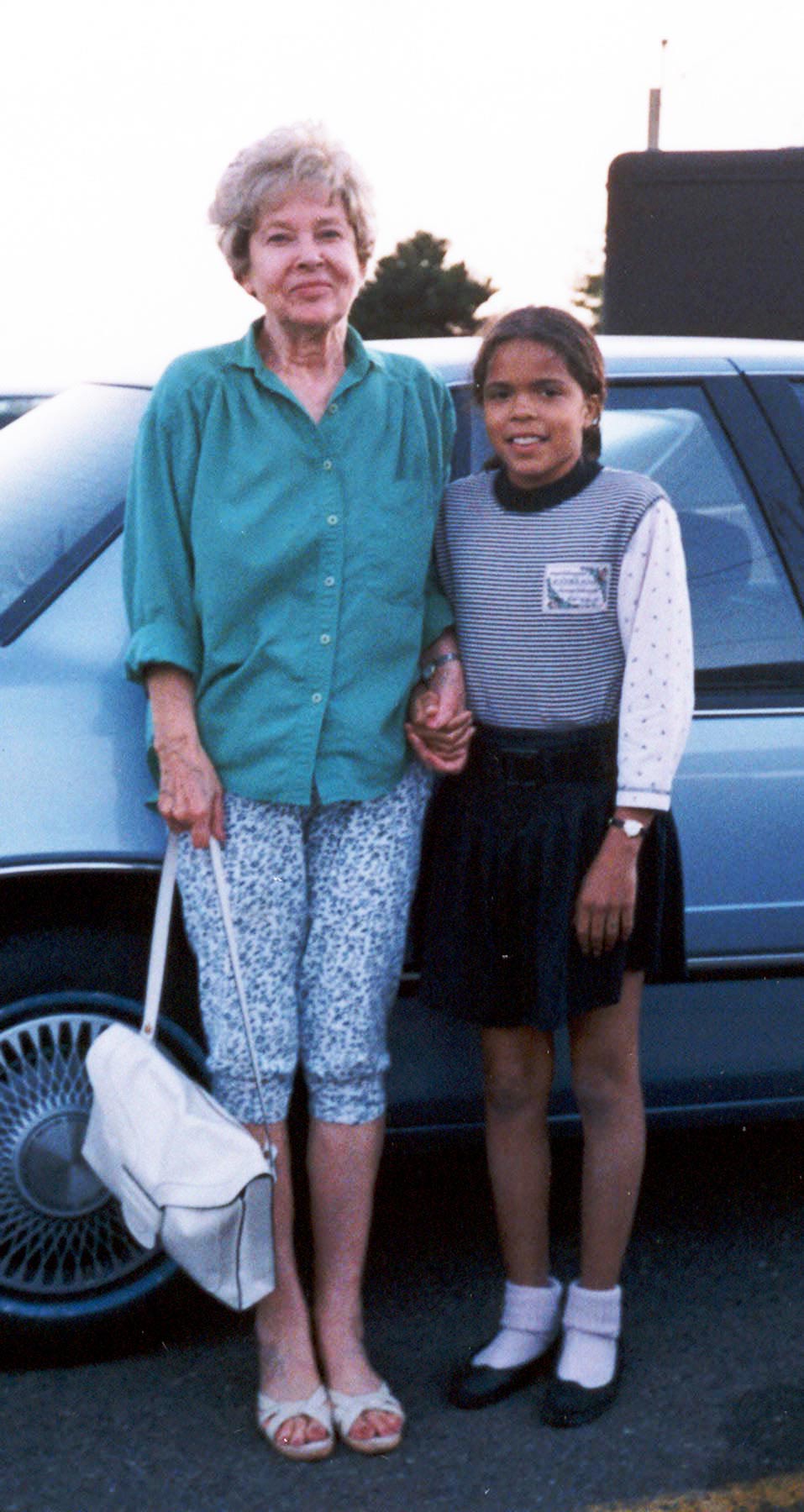
|
| Mom & Amy 1990
|
The last time we saw my Mom and Frank we went to stay with them in a place
they were renting in Gold Beach on the Oregon coast. There was no direct
flight to anywhere near there so we flew to Los Angeles and drove 500 miles
up the coast highway. It was pretty nice, we went through Castroville
(Artichoke Capital of the World), stopped in Bodega Bay (The Birds), we went
along Big Sur, went in the redwood forests... It took us three days; the
first night we stayed in a seedy old motel like in the Bogart movies in
Santa Rosa; the next night we slept in the car; no motels had vacancies. I
guess the most famous thing we did in Oregon was drive 160 miles north to
get giant 12-inch-diameter hamburgers at the Big Wheel... Twice! This
episode was the basis for Amy's Lehmen College application essay (the Big
Wheel is still there; it's in Waldport). We also went to Eugene one day.
We talked about going to Crater Lake but it was too much.
In 2018 cousin Sandy Stout (Mom's niece) told me "I noticed you were in
Oregon in 1990. I believe that was probably the year we went to that same
restaurant in Astoria and by happenstance saw your mom and Frank there. My
parents were visiting me in Washington State (we live 20 minutes from
Vancouver Wa and 45 min from Portland). That day we drove out to the coast
and ate in that same restaurant with the red leather booths. When we walked
in we saw Vivian and Frank and couldn't believe it. That was the last
time I saw her. It took her a few minutes to put things together because it
was such a serendipitous meeting. She couldn't believe what she was
seeing. Neither could we! There was a picture of all of us together that my
parents had. It would be cool to find that picture."
Indio, California, 1995-2002
Mom loved Big Bear and liked to walk around the area, which is truly
beautiful, but the hills were steep and she could only go very slowly and it
made her more and more tired as time passed. Eventually she saw a doctor
about it and was diagnosed with a blood disorder called polycythemia,
similar to sickle cell anemia, that was aggravated by the 10,000-foot
altitude. As the symptoms grew worse the doctors told her she had to get
out of the high altitude.
They moved to Indio CA in 1988, which is 13 feet below sea level and
hellishly hot and arid. Nothing to do and too hot to go outside, they just
stayed inside in the air conditioning. Mom and Frank were both in bad shape
and most of the outings were to doctors and hospitals. There was an
excellent hospital there that Bob Hope had paid for himself and then made
extensive use of, that Mom also used.
Mom died a slow death. It started in 1982 when she had a stroke while
riding with Frank Rider in a bus in Mexico. Ever since then she had more
strokes, plus a bout of cancer (lymphoma) in 1990 that was totally cured and
never came back. But the strokes persisted and increasingly affected her
memory, speech, and strength. Then in 1992 she had an embolism in her
femoral artery, which was resected in a big operation. Later the site
developed a staph infection and had to be resected again, and again, and
again, until this was being done almost monthly, for the rest of her life.
Meanwhile the strokes came more frequently, until by late 2001 she could no
longer communicate. Finally in late 2002 she had a huge stroke and,
according to her living will, nature was allowed to take its course and no
fuss was made; there was no burial, no service, no trace of her is left
except us (she wrote me a letter a couple years prior, expressing her wishes
very clearly while she still could). Frank Rider loved her very much and
was kind and attentive always; he stayed by her through her 20 years of
medical nightmares, including dementia in the final years, up to the very
end. There was no funeral or burial; Mom didn't want any of that, no fuss,
no "spectacle", as she wrote in her letter. She was cremated and the
"cremains" released to Frank Rider. Here's her obituary from the Palm
Springs Desert Sun:
Vivian da Cruz
Vivian M. da Cruz, 80, of Indio died July 26, 2002, in Palm Desert. She was
born March 5, 1922, to Carl and Johanna Engeborg Johnson Lund in Minneota,
Minn. She was a medical legal secretary for the Orthopedic Group. She
served in the Navy. She is survived by her companion, Frank Rider of Indio;
her son, Frank of New York; her sister, Ella Lund of Orange County; and two
grandchildren. She was preceded in death by her son, Dennis in 1978
[see full obituary].
Mom was the nicest person in the world; she never had a bad thing to say
about anybody. She wasn't prejudiced or narrow-minded. She was kind and
considerate and loved children and animals (except bluejays). She never got
angry, never argued. She never spoke of herself or her past and did not
show her emotions. And on top of all that, she was intelligent and highly
competent: she mastered mechanical drawing, shorthand, typing, and Morse
Code, as well as everything it takes to administer a medical practice. And
she was a tireless correspondent; I still have a stack of her letters over a
foot deep. I loved her a lot but (now that it's too late) I only wish
I knew her better.
I also wish I had gone to see her before she died, despite her wishes. But
at least after 20 nightmarish years with my father she had almost 30 good
years in California. Frank and my Mom were together until Mom died but they
never married; Mom said "once is enough". He treated her like a queen and
was crazy in love with her right up through her dementia and then her death
and even after that. After the nightmare life my mom had with
Frank #1, Frank Rider was just about the best thing that could have
happened to her: gentle, considerate, soft-spoken, and adoring.
I stayed in touch with Frank after that. In late 2009 he was diagnosed with
terminal kidney disease. He decided not to have dialysis; he didn't have
that much to live for to go through so much agony and expense to prolong his
life. Instead he went to Puerto Rico to relive a trip he made there once
with Mom, which he said was the best time of his life. I spoke to him in
Jan 2011, he said he only had a couple months left. But a year later he
called and he was fine, the kidney problem just went away by itself. He was
living in an assisted-living place in Oroville CA, near his first wife,
Nancy Crowe. After that I had a long talk with him about once a year. The
kidneys finally quit and he died February 17, 2017, in Enloe Hospital (CA)
of kidney failure and is buried in Vancouver WA, where he grew up. He also
had a son Rick I never met, who (last I heard) buys fruit in South
America and sells it in Asia, and who was married to Sara (who I talk to by
email); they had two sons and divorced in 2012.
The day Mom died I sent you guys an email that is a kind of epitaph,
click here to see it again.



























































